Yanez Novoa is a long time TDA staffer who was helping out on the 2024 Tour d’Afrique Expedition in Rwanda & Uganda.
What do you get if you mix 50 strangers and several tons of steel, food supplies and bikes together? Something like a TDA expedition.
And what is a TDA expedition really? I have heard it being described in many ways: a forced march, a circus, a family. What it is, is big and noisy with lots of sharp and shiny bits; it is high vis-vests and flashing bike lights, chain lube and back up derailleurs. Add up all these miscellaneous parts and you end up with a TDA tour.
In the beginning it starts with the banging of pots and truck doors too early in the morning; soft chatter that grows into a chorus of questions, complaints, compliments, and laughter. And eventually, a lot of laughter. But mostly is it the hum of idle chatter as the 50 strangers get to know each other better.

Showtime
When we arrive in a village, we are often the main attraction. Young and old come together to watch us set up camp and live our new lives on the road. At organized campsites and hotels, we often catch management on the back foot as we slowly dominate the space that they usually control and make it our own – the TDA takeover we call it.

Mia getting ready for her birthday celebration at Via Via
This was the case at Via Via in Entebbe, Uganda, which was our home for three nights. The team at Via Via were super helpful and surprisingly adept at handling something like us. It is a definite stopover for anyone visiting Uganda. On the second night it was Mia Hunter’s birthday and she and Hans bought everyone a drink at the bar. I sat back and watched the 50 strangers bond and move towards what they inevitably will be, 50 people from different cultures that rely on each other and look out for one another to reach their final destination.

The mud bath roads require some walking every now and again
The next morning it started again with the rattling steel, the patter of rain and the rustle of tents being packed up. The hum slowly died down as riders finished their breakfast and the circus spread out over the 116 km of riding that day – made up of 36 km of tarred road leading to a jetty and a 15 minute boat ride. It took 7 trips to get all the riders across that rainy bay. After the boat ride it was a 20 km mud bath to get to the tarred road that would eventually lead them to the town of Jinja.
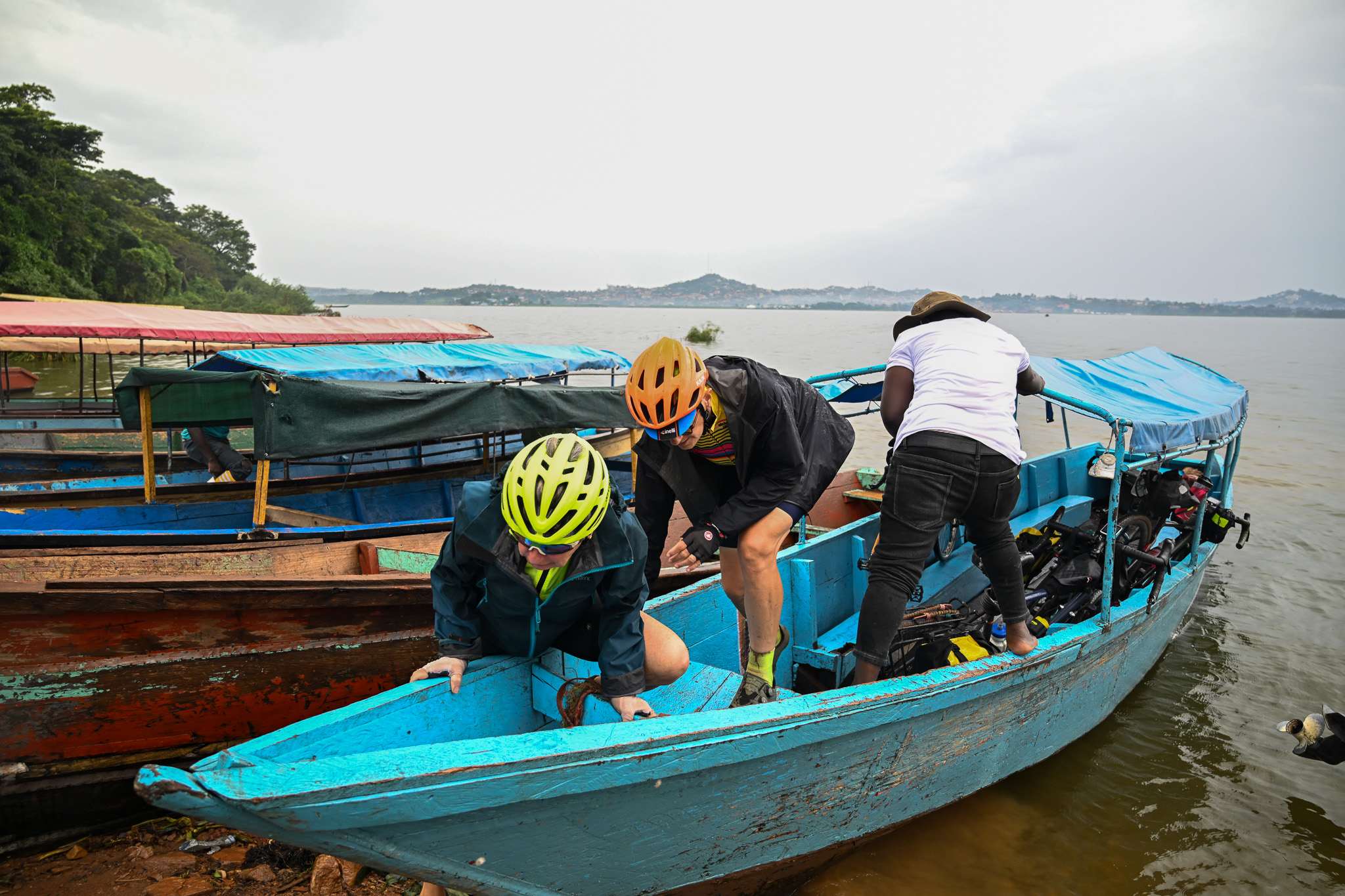
Uli and Eva hop off the boat after a short ride from Entebbe
The mothership, the big dinner truck, was the last to leave Via Via. Sharita and myself left the tour in Entebbe. As the big truck rattled away with all its pots and pans and assorted emotions we heard the birds and the sound of people starting their day, filling the space that had just been full of the 2024 Tour d’Afrique. A moment later, you would almost not believe that the circus had been in town.
All that was left were three black bags. One for organics, one for reusable and one for garbage. The garbage we often have to take with us until we can reach a site where local authorities can deal with it appropriately. The reusable gets recycled or used by locals to keep and do… just about anything they want. The organics goes to a farmer, some wandering goats or, as at Via Via, a compost heap. We try to have as little impact as we practically can and when we do that it will be a positive one.
It might not be our country, but for this little slice of time, it is our home.
RELATED
TOUR
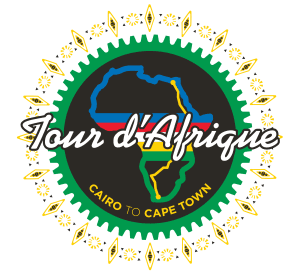
Tour d'Afrique
Our original trans-continental journey and flagship expedition crosses Africa from north to south, covering 10 countries in all. Beginning at the...
]]>
Benjamin Levin is the Content Creator on the 2024 Tour d’Afrique Cycling Expedition. He reports on the recent TDA Foundation bicycle donation that took place in Livingstone, Zambia.
Why do we ride bikes? On a TDA tour we ride bikes for an adventure, for the experience of cycling in a place you never have before – we bike for fun. In Africa, and many places around the globe, people bike for a different reason. They bike because school can be up to 30 kilometres away and elephants have prevented them from leaving on time. They bike because it is the only way that they can carry their goods to the market; they bike because their bicycle is their taxi; they bike because it is what they need to do.
>>Related Post: Local Bikes In Africa: An Appreciation
TDA Global Cycling wanted to create a great cycling adventure through Africa, encourage the use of bicycles and also contribute to helping people in some communities we cycle through by donating bicycles. Over 2300 bikes have now been donated to people across the globe over the lifetime of the TDA Foundation. Most recently, on the 2024 Tour d’Afrique, 34 bikes were donated to young scholars in Livingstone, Zambia so they would be able to overcome challenges and pursue their goal of obtaining a strong education.

Memory, the TDA Foundation partner in Zambia, and Charles Mioba, District Education Board Secretary, during TDA’s bike donation ceremony
Currently, the TDA Foundation partners with African Impact Foundation, a grassroots organization that works on the ground in Zambia, finding appropriate beneficiaries for the bicycle donations. “We partner with them [the Zambian Ministry of Education] for recommendations every year to identify which schools should benefit from this bicycle donation,” says Memory Mundia, Operations Manager of African Impact and the TDA Foundation’s main point of contact in Zambia. Memory and the Ministry of Education are looking for schools that are located in areas where their student body is spread out across a large area and face unique and challenging problems when attempting to commute to school. Once the beneficiaries are chosen, the school works to find which students are the most in need of the assisted transportation, and they are given the bicycles.
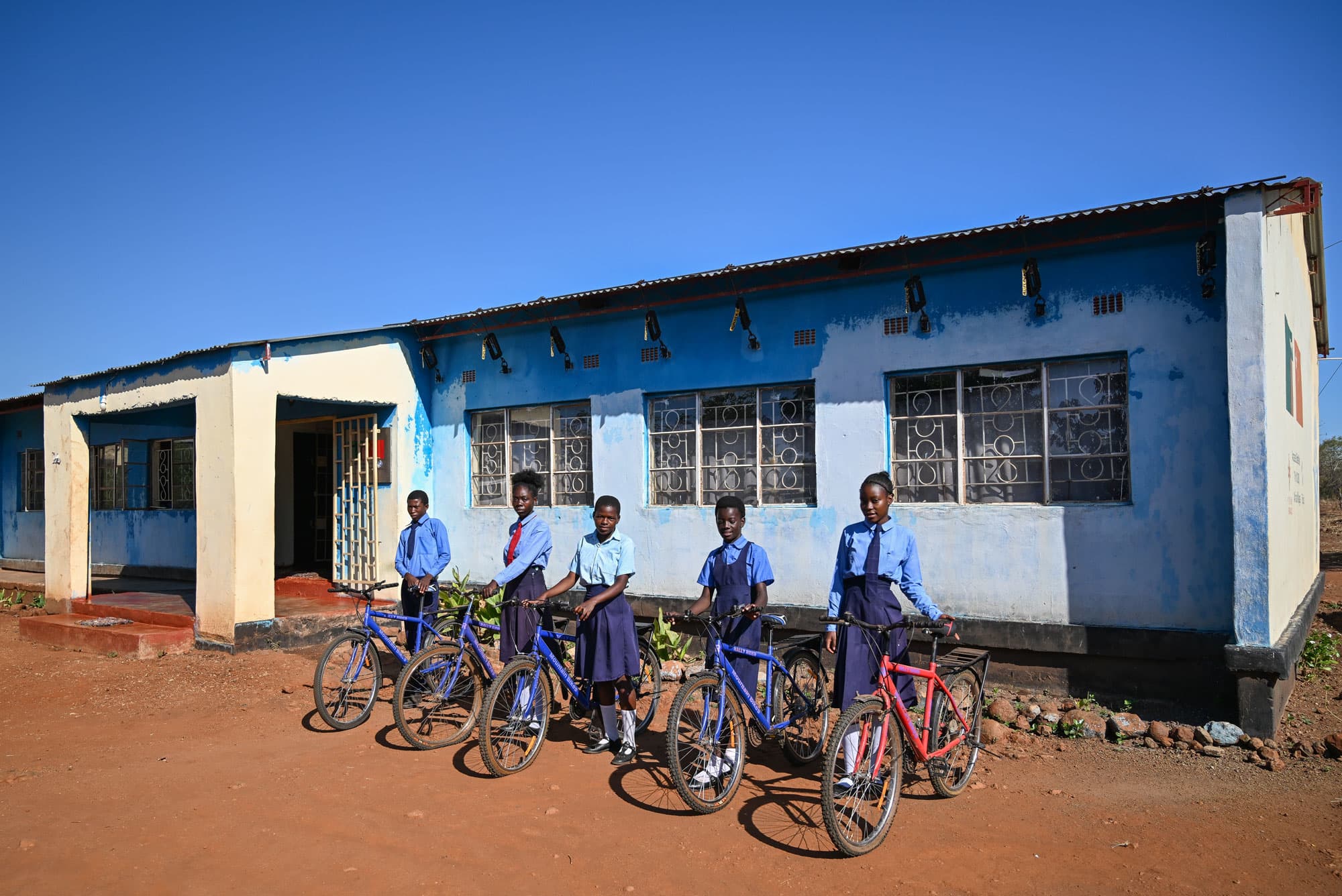
The five recipients of bikes at Twabuka Primary School
One of these schools is Twabuka Primary School located roughly 25 kilometres outside of Livingstone, Zambia and inside of the Mosi-oa-Tunya Game Park, a protected wildlife reserve where animals such as elephants, lions and buffalo roam free. “Being in a game park we have deadly animals like elephants,” explains the headmaster of the school. “In the morning the elephants will be traveling back towards the river [Zambezi River] and during that period it is really dangerous for the pupils… giving them these bicycles, they will start off late [to avoid the elephants] but still arrive on time to school.”
It was clear, when visiting the school in early April 2024, that these students wanted to be there on time and ready to learn. Nonetheless, when elephants are on the road, it is extremely dangerous for the students to try to get by them and get to school. Only a few years ago a pupil in 5th year was killed by elephants while attempting to make it on time. “Those times where I didn’t have this bicycle and there were elephants, I used to stay back at home, but now even if there are elephants, I can still come after they are gone… those times I would miss some topics in class, I would find the teacher had started without me, but now I can still come early and find the teacher before he starts teaching,” said one young woman we talked to at the school.

A young TDA Foundation beneficiary smiles as we chat about her bike
Not only are these treks to school at times dangerous for the children, but they also are tiring. Students in this district near Livingstone are expected to be at school at 7:15 in the morning and ready to learn by 7:30. If they have had to cover many kilometres while walking to school, by the time they get there, they are tired and have less energy to learn. “I used to miss classes because I was late and tired because of the distance I covered… having the bike helped me be active in class,” says Mathews Kanyemba, a former recipient of a TDA Foundation’s bike donation. Mathews has now graduated and is currently waiting to hear back from university in Lusaka, where he is planning on studying engineering. “If it was not for the bike, I doubt I could pass the way I did.”
As anyone who has ridden the Tour d’Afrique with TDA knows, education is available all over Africa. Countless mornings we have found ourselves cycling with hundreds of uniformed school children as they make their way to morning classes. The majority of the kids we see are walking, some are biking, and very few are in vehicles. Across the board one thing is very clear; these students are hungry to learn and go to school. Education represents opportunity for these students, a way to fulfill all the potential that each of them has. While we understand that there is still a lot of work to be done, we are thrilled that our bicycle donations help bring these intrepid young learners one step closer to achieving what they set out to achieve every time they make that journey to school.
RELATED
TOUR

Tour d'Afrique
Our original trans-continental journey and flagship expedition crosses Africa from north to south, covering 10 countries in all. Beginning at the...
]]>
Benjamin Levin is the Content Creator on the 2024 Tour d’Afrique Cycling Expedition. In this report, he looks at some of the bikes being used on this year’s ride.
What is the most important thing that you can bring on a bike tour across Africa? Well, a bike of course. Simple, right? In a way yes, but it is also a huge decision that will potentially impact four months of your life if you are riding the entire Tour d’Afrique from Cairo to Cape Town.
Do you want a carbon fibre bike, light on the road but potentially fragile? Maybe, maybe not. Do you want a steel tank of a bike that destroys the gravel sections but is a bit more difficult to climb the base of Kilimanjaro with? Maybe, maybe not. The truth is there is not one bike that answers all the demands of this long, challenging journey. A lot simply depends on what you are comfortable with. We asked some of the riders about the bikes they are currently using on the 2024 Tour d’Afrique so they could inform future riders of the pros and cons and the nitty gritty details of their bikes.
Jim Flynn (Australia)

Jim is riding a Curve bike. It is a full titanium frame that is set up for long distance riding and endurance cycling, particularly off road. Jim likes the titanium frame because of the flexibility that it provides along with the strength. The bike has been modified by adding aerodynamic extension bars to the handlebars. “Probably the most important thing I have got, which is essential for long rides like this, is the extension bars.” He says that having another hand position gives him a lot of relief on long rides. “I would spend all my time on those bars if I could.” Jim explains how people can get neuropathy from using the same generic grip every single riding day and that the options that his extension bar provides are very helpful.
He also has a suspended headset which gives him a bit of deflection which he appreciates on the dirt and gravel. Another thing Jim talks about is his choice to opt for a mechanical one by twelve gearing set up for simplicity. Though he has ridden with electronic gearing in the past, with different set ups, he says when cycling through Africa he prefers to keep things simple, and importantly, parts source-able. It can be difficult to find more modern/complex bike parts in many parts of Africa so keeping things basic is a sensible way to go.
What Jim recommends: Try to have a system that allows you to have multiple hand holds. Also, unrelated to biking but still very important, come with an open attitude and a love of adventure he says. “I think you have got to have a bit of a love of adventure and be prepared to put yourself out a little bit!”
Justene Wilkes (United States)

Justene is riding a Surly Bridge Club that she purchased specifically for this trip. She says that in the past she has ridden an aluminum road bike with a carbon fork but for this trip she wanted something that could handle a wider range of terrain and climbs. Her Surly Bridge Club is all steel and sized up so it is more robust. She loves the steel but says it is heavy and it makes some of the climbing days that much more challenging. However, on the dirt, this bike is a rock star. “We recently had a day of 55 kilometres of rock and dirt and I just plowed right through it… I attribute that to the steel bike and the wide tires that it came with,” she says proudly.
Justine explained that she did not exactly know what to look for when buying a bike for this tour so sensibly she went to her local bike shop to get some recommendations and this was one of the bikes they recommended for her. “One feature that I quite liked is the single chainring in the front, one less thing to break and go wrong for me, and so far I have been very happy with that choice, but the downside is that when we have a really wicked tail wind, I sometimes cannot keep up because I have a max speed I can do.”
What Justine recommends: Carry snacks and Tylenol!
Helen Smith (United Kingdom)

Helen is riding a Hardtail mountain bike, a specialized rockhopper. “I decided to ride the Tour d’Afrique on this bike mainly because I absolutely love riding it!” Helen explains that with the combo of off-road and tarmac, this bike is perfect for her riding style. “The main features that I like about my bike are the front suspension and the ability to turn it on and off, also the three gears that I have on the front chain ring.” She says that for her personally, this gear set has an advantage because she can quickly change between the large and the small cog at the front.
She knows that she does, however, have some limitations, but not the ones you may expect on a bike. “The main limitation of this bike is actually probably me myself. I am the smallest rider on the tour and have the smallest frame size, a 13 inch.” Because of the bike’s small size, she can only carry two water bottles on the frame and does not have any mounting points on the front fork. This, she says, is her biggest battle on tour because she has to carry extra water in a pack which is an inconvenience in her opinion. Helen also carries around something key to her success on tour that no other rider does, a little Scottish teddy as a mascot!
What Helen recommends: Get a pro bike fitting and make sure that you have enough space to carry a sufficient amount of water.
Henry and Linda (United States)

Henry and Linda, one of our husband and wife couples on this year’s Tour d’Afrique, are both riding the same bike, Fuji Touring bikes. “They are about as basic a bike as you can get,” Linda exclaims. “We have caliper brakes and bar end shifters which are virtually unbreakable!” She explains that bringing a simple bike to Africa was a big thing for her. “I think almost anyone in Africa can fix our bikes,” she says laughing.
The bikes are steel which means they are heavier than many bikes on tour; however, this also means they are rugged and are able to put up with the beating that they get on these African roads. Another feature of their bikes they believe is valuable is having wheels with 36 spokes. With all the dirt roads, the couple believes that having that amount of spokes protects them from potential damage to their rims.
What Linda recommends: Simple bikes! They are easy to fix and maintain.
What Henry recommends: Take a saddle that you are comfortable with and have ridden before. “Saddle sores can take you out,” says Henry. He also recommends double handlebar tape and handlebars with multiple handholds to avoid sore hands while riding.
Jannes Nijland (Netherlands)

Jannes is riding a titanium gravel bike that he bought specifically for this tour. His number one criteria for picking a bike was to find a durable bike that could handle all the elements, specifically the gravel which he loves. “The best days are the gravel days. We had a 400 kilometre straight gravel stretch which is really unique…”
Riding a bike made for the most physically taxing stretches allows him to cruise through the difficult stretches and deal efficiently with the sealed roads as well. He explained that he would rather have a bike that can handle all of the riding as opposed to just some of it. Jannes rides with a double chainring in the front because there is so much climbing and descending that having a wide range of gears to rotate through is a big help.
What Jannes recommends: “The most important thing to bring is your bike!” Jannes says, chuckling. He also thinks that having a double chainring for your gears in front is important because there is more climbing than he expected! Further, he recommends making sure you bring gear that is new. “Do not show up with a cassette that has been riding 6,000 km back home.” Finally, he echoes what other riders have said. If something breaks and you cannot find a replacement, your tour is finished so bring a simple bike with simple parts.
Closing thoughts
As you can see, everyone comes with different opinions on the best sort of bike and suite of features to go with it. Helen and Jannes really find value in having multiple chain rings on their front gears whereas Jim and Justine ride with one and enjoy the simplicity that it brings. While many opinions differ, there are a few common threads that everyone agrees on. First off, you are going to cycle through Africa. This is not Europe where there is a proper bike shop in every town you go through – finding parts to replace can be difficult. Bringing simple parts and ones that are source-able can save your tour. “If something breaks that you cannot replace then you cannot ride anymore… that is the consequence [for bringing parts hard to replace],” Jannes exclaims.
Secondly, bring a bike that you are comfortable riding. This is an epic adventure, something that very few people in the world ever have the chance to do. It is tiring, thrilling, treacherous, and exhilarating. You do not want to be uncomfortable with the bike you bring. Trust yourself and bring a bike that you know you will be comfortable with, a saddle that you have ridden on, and, as Jim says, an attitude for adventure never hurts!
Watch our accompanying video to hear the testimonials from the riders themselves along with some additional tips!
RELATED
TOUR

Tour d'Afrique
Our original trans-continental journey and flagship expedition crosses Africa from north to south, covering 10 countries in all. Beginning at the...
]]>
Benjamin Levin is the Content Creator on the 2024 Tour d’Afrique Cycling Expedition. In this report, he takes a look at TDA Global Cycling’s method of navigation for the riders on tour.
TDA’s Navigation History

In the company’s not so recent past, GPS mapping software was not as readily available as it is today. That meant in order to navigate groups of cyclists across continents, they used biodegradable flagging tape. Yes, flagging tape. Imagine biking 10,000 km down the entire length of Africa and only being directed by little pieces of bright orange tape hung on whatever the staff could find. Sometimes, they even used energy drink powder….needs must!
>>Related Post: Finding Your Way Home

Well, luckily for everyone who would be involved in what seems like a stressful process, TDA has changed with the times and now employs a new way of herding the groups of sometimes 60+ riders across continents. They use GPS mapping and the Ride with GPS interface (with only the occasional flagging tape for areas that may prove confusing).
>>Related Post: Navigation And The Tour d’Afrique: On A Wing And A Prayer
So, what is Ride with GPS? Ride with GPS is an interface that allows users to plan routes as well as map, analyze, and share their rides with friends. Similar to other apps such as All Trails which is used for hiking and running and Polar Steps which specializes in general travel tracking, Ride with GPS is designed for bike travel. With an extensive database of maps, Ride with GPS allows TDA to navigate its plans accurately and efficiently along the routes that they plan out.
Currently, Ride with GPS is being used on the 2024 Tour d’Afrique and 3 months into the tour it has worked without a hitch. We have travelled through deserts in Egypt, mountains in Rwanda, and the savannahs of Kenya and Tanzania, all while having Ride with GPS telling us where to turn, where to find refreshment, and most importantly, how far until lunch!
Ride with GPS is a flexible app that can be customized to best fit the users’ preferences. Most riders on TDA tours use a smartphone with the RWGPS app as their main navigation method. While this presents some challenges (weather resistance and battery drain), in our experience, it is the easiest setup to use, especially for anyone who is less tech-savvy. Riders can bring a battery pack as a back up. Others prefer to use a Garmin or Wahoo GPS device – these are also a good option, but require much greater effort and patience both for initial set up and to load the daily tracks. If you do not already use a Garmin or Wahoo device, a smartphone is the best option
Below you will find testimonials from the 2024 Tour d’Afrique riders explaining how they use the app to best suit them on their rides.
Henry

Henry uses a Wahoo when he rides, while also having Ride with GPS app active on his phone. The Wahoo gives him vocal cues which he thinks are helpful but keeps the app open on his phone because it provides him more information than is displayed on his Wahoo. “I check the app a lot on those long climb days because I need to proportion my energy properly.” He says he will also check information like the speed he is going and the distance he has left until the next stop he plans to make so he can estimate how long it will take him to reach his destination. Henry uses physical cue sheets as well (printed out versions of the cue sheets on Ride with GPS). “I have [used the sheets] to look for coke stops… if we are at kilometre 115 and it says there is a coke stop at kilometre 120, I know that I will have the chance to stop soon.”
Linda

Linda uses a Wahoo during her rides while also keeping the Ride with GPS app active on her phone. However, unlike Henry, she says she rarely opens the app during her ride. She does not use voice cues, simply following the arrows presented to her on her Wahoo. Linda says that riding without checking so many metrics and specifics is “just her style” and that it would be the same way if she was riding solo and not in a large group. “I very rarely look at the physical cue sheets,” Linda exclaims. “I bring them just in case I get separated and need to know what’s going on…I have a lot of trust in my arrows [on the Wahoo display].”
Jannes

Jannes uses a Garmin in order to navigate on the Tour d’Afrique. He jokes that it really is not all that difficult to navigate in Africa. “Well actually it’s not too complicated to ride in Africa cause most of the road is straight and has little turns!” He keeps his Garmin screen on throughout the entire ride because it has enough battery life to last the entire day without dying. The most important metric, and really the only one he says he looks at, is the distance to the next stop on his route. He mentions that he will occasionally look at the speed he is going, or what was going on during the ride, but not consistently.
Kenny (one of our bike mechanics)

Kenny uses his phone as his GPS as opposed to a Garmin or a Wahoo. He chooses to leave the screen blacked out but rides with the audio cues which he listens to in one earphone. He turns his screen on periodically to make sure that he is on route, but when he does, he does not use any of the specific metrics on his home screen. “I like the simplicity of just a line to follow and the avatar.” He says he does not use a physical cue sheet but will use the one provided on the Ride with GPS app when he needs it.
RELATED
TOUR

Tour d'Afrique
Our original trans-continental journey and flagship expedition crosses Africa from north to south, covering 10 countries in all. Beginning at the...
]]>
Gonzalo Pastor is a sectional rider on the 2024 Tour d’Afrique Cycling Expedition. In this post, he reports on his experiences, religious and otherwise, in Tanzania.
We are in beautiful Tanzania. A few days ago, we camped under the impressive Mt Kilimanjaro and last night we saw Mount Meru from our campsite. Two jewels of Tanzania! I will be taking with me many wonderful memories from this beautiful land, spiced by the magic of the Tanzanian people. People from different tribes (Maasai, Chagga and other 118 tribes, living in peace with one another) and 3 of the world’s main religions, mainly Christian, Muslims and some Hindu.

I would like to note a material thing that makes many young men and women happy in these lands: the colourful T-shirts from leading international football teams (Manchester United, Chelsea, Arsenal, Real Madrid and others) that are seen all around on the youngsters (and not-so-young!). Dress codes that can be distinguished a mile away while biking, because of their bright colours. The amusing thing is that if you, for example, ask some young Maasai ladies about the team T/shirt that they are wearing, they may look at their shirts and reply that they don’t really know what are those t-shirts all about! But that is, however, immaterial to the smile that you receive from these ladies as a curious tourist! We just like football, and that is why we use those shirts, Jazz told me at the hotel counter! A little gift from the Champions League’s organizers that makes so many people happy down here. Muchas gracias Champions League!
The story of the Maasai people does not finish there. The Maasai, in Arusha and maybe in other places, may be facing some tough times once you look deeper. Modernization has arrived and many large fertile areas are now fenced, thus somewhat limiting the space available for grazing their cows, goats and sheep. Lands that were open fields not so long ago, are now private property and beyond reach for them. My observation is that the Maasai are adjusting to the times. Some are more engaged in agriculture than in the past. Others work in the services sector, in tourism or retail. Those working in the tourist sector may not even carry their traditional bright-coloured shoulder blankets and walking sticks used by their parents and grandparents.

Tanzanian society, overall, is very religious and that may be a source of cohesion in these changing times. The names of our local assistants along the road have been, among others, Emmanuel, Ezequiel, Ruth, Naomi, and Sarah. Even the wifi passwords give you a hint – for example, “Blessing 2023.” The Maasai are also a very traditional social group. Tradition! Tradition! It impacts the way they live and eat. For example, according to their religious practices, not all portions of the cow are eaten and some portions are reserved for men and others for women. I have received many blessings along the road these last two months, including some requests to keep some people in my prayers. My last name is Pastor, which is Swahili reads Mfundisi, or leader of a congregation. Thus, some people think that I am, in fact, a religious leader. That makes me very proud and I now carry that name with great pride and responsibility!
RELATED
TOUR

Tour d'Afrique
Our original trans-continental journey and flagship expedition crosses Africa from north to south, covering 10 countries in all. Beginning at the...
]]>
Judith Gold, sister of TDA Founder Henry Gold, is currently cycling the 2024 Tour d’Afrique from Kigali to Cape Town. In this piece, she looks back at her experience cycling through Kenya.
We have now completed cycling through Kenya. Our first rest stop in the country, after an intense 5 days of riding from Entebbe – through mountains, on dirt roads, in fishermen’s boats and on local trucks – was in Eldoret, the town where Kenyan runners and cyclists train. It was home for the recent Chicago marathon champion and world record holder, Kiptum, who died in a tragic car crash a week before we arrived.
Surprisingly, at least to me, there was a huge difference upon entering Kenya. We saw many industrial farms, greenhouses, and evidence of industry. Sadly, there was virtually none of that in the parts of Uganda we biked, save for one Chinese industrial park. The roads in Kenya are less busy, houses set a bit further off the road and a lot fewer adults and children milling about and the majority of women are in modern dress. The land is also dryer, though still green, and we passed the occasional cactus and acacia tree, but no giraffes (they feed on the acacia). The land turned very green soon thereafter, as we entered the Great Rift Valley. An amazing ride, even among the many amazing rides we have already had.

Another highlight were the numerous crossing of the equator, which I have already written about, as we snaked our way east from Uganda before turning south towards Nairobi. It’s just one of those things one likes to tick off one’s list, but we crossed it so many times that many of us lost count. A fellow cyclist, after she read the blog, reminded me that I forgot two crossings during our trip to see to the chimp sanctuary in Lake Victoria. As I said, we lost count…

The scenery in Kenya was impressive. It truly is a beautiful country (at least the part we cycled). It’s surreal sometimes to be the only cyclist on an empty long road, as the vast majority of the other cyclists are way ahead of me. I have to remind myself how amazing this really is. And it’s also remarkable how safe it feels. Especially when one considers that the interior of Africa was a completely mystery only 150 years ago.

We had two rest days in Nairobi, a vast and very busy city. We (Gonzalo and myself, and some of the other riders) took the opportunity to visit the Giraffe Sanctuary to see and feed the Rothchild Giraffes, which were nearly extinct before their numbers started to rise due to the work of the sanctuary. There are now close to a 1000 of these.

We also had a short game drive in the Nairobi National park, where we saw lots of game and visited the Sheldrick Elephant Nursery, watching orphan baby elephants being bottled fed and frolic. An interesting book about the founding of the nursery is Love, Life, and Elephants, an African Love Story, by Daphne Sheldrick. But perhaps the best part of the visit to Nairobi was the many interesting conversations we had with Uber drivers. The majority are university graduates who cannot get jobs making a decent living. They work 14-15 hour days. We spoke to several finance/accounting majors. Some lost their jobs during COVID and indicated that these jobs are unlikely to come back. Many complained of recent increases in taxes and how life was getting harder and harder. It was difficult not to put on our IMF hats and start dissecting the economy. Talk of debt was everywhere!

Our final day of riding in Kenya was around Mt. Kilimanjaro with clear views of the snow capped peak. Super lucky!
RELATED
TOUR

Tour d'Afrique
Our original trans-continental journey and flagship expedition crosses Africa from north to south, covering 10 countries in all. Beginning at the...
]]>
Judith Gold, sister of TDA Founder Henry Gold, is currently cycling the 2024 Tour d’Afrique from Kigali to Cape Town. In this piece, she looks back at her experience crossing…and recrossing…one of the world’s great dividing lines.
As loyal followers of TDA Global Cycling will know, the 2024 Tour d’Afrique had to rejig its traditional route to skip over Sudan and Ethiopia. Instead, we got to bike in Rwanda and Uganda and so had the pleasure of many new experiences that were not available on the usual ride. One of these is the numerous crossings of the equator.
The equator is one of those classic things that travellers like to tick off their list. Yes, it may be important to cartographers, and especially to navigators in days past (before Ride With GPS, haha), but really, what is the imaginary line that separates the earth into the north and south to us, everyday people, who like to bike, other than a photo op? Imagine our surprise when we experienced several crossings of this historic marker.

Our first crossing was in a long (about 4 hours) ferry ride on Lake Victoria. Unfortunately the day was bleak, with rather intense rain, and the majority of riders were packed like sardines in the belly of the ferry. It was actually fun, as we got to intimately know our fellow Ugandan passengers including details of their daily lives while exchanging stories and showing photos of our loved ones. We did not, however, mark the crossing of the equator. Not only was it raining hard, but any movement on the ferry was restricted by the large crowd and leaving your seat meant you got to stand the rest of the way. No problem, we knew there would be another crossing. But we did not appreciate just how many.
 The second time was epic. It was during stage 23, cycling from Koriema to Nakuru, in Kenya, and we lunched at zero latitude. Very cool! Many of the riders made sure they got a video of themselves riding right under the equator sign, several times! A feeling of a real sense of accomplishment. Another milestone on this amazing journey. But just the very next day, on a ride from Nakuru to our Bush camp at Matura, we got to cross the equator two, or maybe three times. We are still debating this, as we ended the ride on our rest day in the town of Nanyuki, in the North hemisphere somehow, when we should have been in the Southern Hemisphere. Clearly one of our crossing was on either of the two long segments on dirt roads, where the road authority did not go to the trouble of marking this most important of passages.
The second time was epic. It was during stage 23, cycling from Koriema to Nakuru, in Kenya, and we lunched at zero latitude. Very cool! Many of the riders made sure they got a video of themselves riding right under the equator sign, several times! A feeling of a real sense of accomplishment. Another milestone on this amazing journey. But just the very next day, on a ride from Nakuru to our Bush camp at Matura, we got to cross the equator two, or maybe three times. We are still debating this, as we ended the ride on our rest day in the town of Nanyuki, in the North hemisphere somehow, when we should have been in the Southern Hemisphere. Clearly one of our crossing was on either of the two long segments on dirt roads, where the road authority did not go to the trouble of marking this most important of passages.
Nanyuki is an attractive town, best known as the place to organize safaris to see the last surviving northern white rhino in the nearby Ol Pejeta Reserve. It is also directly on the equator and a short walk through town takes one right by yet another sign that announces to the world that one has crossed that imaginary line. The majority of the riders decided that they had enough crossings so they did not bother. In any case, we all crossed it one last time (at least on this trip) on our ride out of Nanyuki to Othaya. I am guessing that no one bothered to stop and take a picture.
All in all, we crossed the equator six times (not counting the crossing in town on our rest day). Maybe 4 more than needed? Even our illustrious tour leader lost count. Maybe TDA Global Cycling should try out a new route, the Equator Ride, snaking along the equator in this part of Africa?
RELATED
TOUR

Tour d'Afrique
Our original trans-continental journey and flagship expedition crosses Africa from north to south, covering 10 countries in all. Beginning at the...
]]>
Benjamin Levin is the Content Creator on the 2024 Tour d’Afrique Cycling Expedition and a self described wildlife photographer. In this report, he looks back at his experience (and that of a few riders) had on the Musanze rest day visiting the mountain gorillas of Rwanda.
The riders had climbed for days and days to get to this point. Rwanda is known as the land of a thousand hills and whoever said that was certainly not exaggerating. But some riders on the 2024 Tour d’Afrique had a destination in mind that was worth the endless ascents; they were going to one of the only places in the world that can offer a wildlife experience as singular and intimate as the one they were after. The excitement in these riders was palpable as we headed to Musanze, Rwanda. They were going to have the opportunity to see endangered mountain gorillas in the wild.

A silverback gorilla lazily staring at us as he eats
There are just over 1000 mountain gorillas left on the planet. With their range restricted to the jungles of Rwanda, Uganda and the Democratic Republic of the Congo, it is imperative for the survival of this species that they are properly protected. Tourism is strictly regulated. In Rwanda, only 96 permits are given out each day to see the gorillas. Not only does this make the experience that much more special for the riders that had the opportunity, but it also ensures that the gorillas remain truly wild, not becoming habituated to human intrusion. Moreover, the money made from tourism goes directly back into gorilla conservation and the development of the local community. In a way, the gorillas are the catalysts for the successful development of gorillas conservation programs and growth of the Musanze area.
 As it grew closer to the time to leave for the tour, everyone made certain their permits were correct, cameras were charged and clothes were primed for the bugs and rains. Then, in the early morning, we got picked up from camp. Soon we were placed in our groups; the time to search for these beautiful, powerful primates was upon us. The morning was mostly clear, we could see the volcano looming over the jungle. Rain clouds threatened, as they always do in this part of the world, in the distance above Volcano National Park. The bush was dense, more of a game trail than one regularly used for trekking. Ankle deep mud, the enemy of the day, welcomed us to the jungle. For 45 minutes, or maybe an hour, we pushed through the dense undergrowth. The game ranger led us confidently, explaining as he went that all of the gorilla tracking is done using landmarks, no GPS or satellites. Then we heard voices, voices and grunting. We stood still. The tops of the trees moved, rather, they were moved and rounding a corner suddenly, a silverback gorilla stared at us.
As it grew closer to the time to leave for the tour, everyone made certain their permits were correct, cameras were charged and clothes were primed for the bugs and rains. Then, in the early morning, we got picked up from camp. Soon we were placed in our groups; the time to search for these beautiful, powerful primates was upon us. The morning was mostly clear, we could see the volcano looming over the jungle. Rain clouds threatened, as they always do in this part of the world, in the distance above Volcano National Park. The bush was dense, more of a game trail than one regularly used for trekking. Ankle deep mud, the enemy of the day, welcomed us to the jungle. For 45 minutes, or maybe an hour, we pushed through the dense undergrowth. The game ranger led us confidently, explaining as he went that all of the gorilla tracking is done using landmarks, no GPS or satellites. Then we heard voices, voices and grunting. We stood still. The tops of the trees moved, rather, they were moved and rounding a corner suddenly, a silverback gorilla stared at us.
 One of the most striking feelings you experience while viewing wildlife is being looked at. It is almost ironic, you search for these animals in order to look at them, to see them in their natural environment, undisturbed. So when they look at you, and you can really feel them looking at you, it is an incredibly special feeling. Primates in particular, so human in their appearance and actions, look at you with an intelligence that freezes you in place. We had cycled a thousand kilometres and hiked for many more to end up looking at these creatures, and instead, they were looking at us.
One of the most striking feelings you experience while viewing wildlife is being looked at. It is almost ironic, you search for these animals in order to look at them, to see them in their natural environment, undisturbed. So when they look at you, and you can really feel them looking at you, it is an incredibly special feeling. Primates in particular, so human in their appearance and actions, look at you with an intelligence that freezes you in place. We had cycled a thousand kilometres and hiked for many more to end up looking at these creatures, and instead, they were looking at us.
As we observed these wonderful animals, our gaze reflected in theirs, we could not help but compare ourselves to them. Seeing these mountain gorillas in their home, playing, arguing, grooming, and relaxing was like looking at a mirror of the human condition. The tenderness of the mother, the gentle confidence of the father, all things that we have experienced in our day to day lives. Visiting the mountain gorillas was a deeply impactful experience. The unique blend of intimacy and awe of being seen through their eyes is something I will always remember and carry with me.
RELATED
TOUR

Tour d'Afrique
Our original trans-continental journey and flagship expedition crosses Africa from north to south, covering 10 countries in all. Beginning at the...
]]>
Benjamin Levin is the Content Creator on the 2024 Tour d’Afrique Cycling Expedition. In his second report, he looks back at his experience with Egyptian traffic and the different ways people use horns, something that our cyclists slowly learned about during their time in the country.
Arriving in any unfamiliar country can be overwhelming. For the riders beginning the Tour d’Afrique in Cairo, Egypt, with its constant and overwhelming stimulations, the experience is often a shock to the system. A thousand new sights, smells, and sounds welcome you to this great city. Through it all, no sense is as affected as is your hearing. Twenty-two million people live in the Cairo metro area and with an estimated 2.6 million licensed vehicles on the road, one sound rises above the din, honking. While the barrage of horns is often mistaken for constant anger on the road, it is really a nuanced language. Known only to the drivers of Egypt, the language of honking is as important for road literacy as reading street signs.
Many travellers to Egypt, hailing from countries where drivers tend to use horns to express anger or signal danger on the road, may find the constant deluge unsettling if they are not accustomed to it. Before acclimatizing to the honking culture, it would be easy to perceive everyone as constantly angry or in danger, putting you on edge. However, this conclusion would be misplaced. Spend any amount of time in the back of a taxi in Cairo, and you will begin to grasp the complex conversations that unfold on the matrix of streets, in the alleys, and throughout the 14-lane motorways of the city.
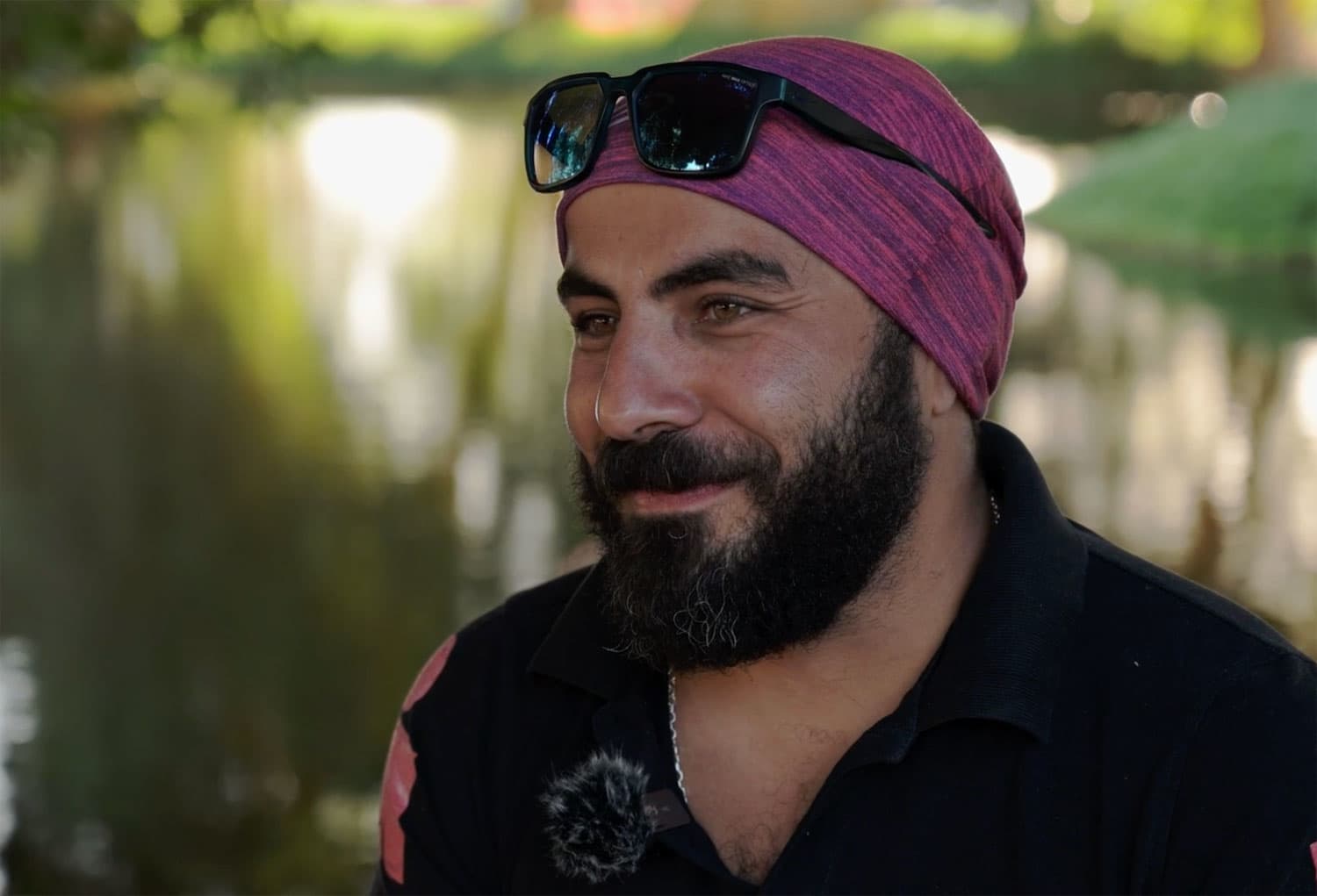
Yasser smiling as he chats about Egyptian drivers
As Yasser Mohamad, a Cairo native and a local bicycle mechanic in Egypt who was with us till Aswan to help support the clients, and I were driving, he explained the language of the road. “We have many words we can contact each other with [while driving], like ‘beep’ is like thank you, ‘beep beeeeep’ is like I’m angry from you, beep beep beep beep beep beep is like I love you habibi… some things like this,” he exclaims, laughing. This was just moments after he had honked at a car, passed it as it was honking back at him, then honked again to let them know his thanks. In just a few moments the two drivers communicated that one would pass the other, that it was ok, and then said thank you. All with a few touches of the horn. Yasser remarked that honking is part of everyday life in Egypt and makes driving much safer. “Without this, we would have many accidents on the road.” Lacking the traditionally enforced rules of the road, driving anywhere in Egypt is quite hectic and the use of the horns is a way to stay safe and aware on the busy streets.
Consider honking simply a form of social interaction; the same way that two people would make eye contact and nod to each other, is the same way two drivers honk. It makes sense. Polite people say please and thank you and ask for permission before doing something that may get in the way of others, but in a car we do not have the ability to speak this easily. Horns give people on the road a voice, a voice that people in many countries seldom use.
In Egypt, honking adds a layer of cultural richness to the chaotic song played on every Egyptian street. If you ever have the time to visit, take a moment to listen to the din of cars and trucks. Watch the skillful drivers weave in and out, taking cues from other drivers’ horns. You may just end up appreciating a sound you have been conditioned to dislike.
RELATED
TOUR

Tour d'Afrique
Our original trans-continental journey and flagship expedition crosses Africa from north to south, covering 10 countries in all. Beginning at the...
]]>
Benjamin Levin is the Content Creator on the 2024 Tour d’Afrique Cycling Expedition. He files his first report from Egypt.
The Tour d’Afrique is now leaving the moonscape deserts of Egypt for the fertile abundance of the Rwandan mountains. This shift, marked by the stark colour contrast between the yellow of Egypt and the green of Rwanda, is not the only change involving this particular Tour d’Afrique, and certainly not the most important. In fact, the most important change isn’t represented in the landscape and roads at all, but rather in the riders themselves, namely, the intrepid women of the 2024 Tour d’Afrique.
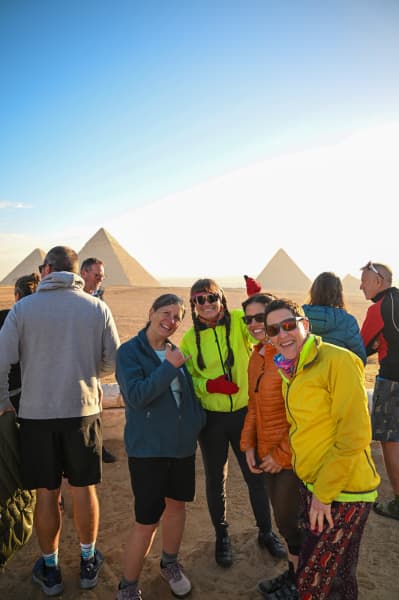
Sheila, Lois, Joanne, and Pam at the Pyramids
Although this tour has run for over two decades, this year marks a historic milestone – a perfectly balanced representation of men and women cycling the length of Africa, over 9,000 kilometres. When the tour first ran, 20% of the participants were women; 10 years later it was 34%, and now, 10 years after that, it is 50%. However awesome these numbers are, this is more than a statistical change. It is a testament to the amazing participants on this year’s Tour d’Afrique and an indication that the landscape of expedition cycling is becoming more inclusive and accessible.
So why is this shift taking place? Is it that the stereotypes that once restricted women to the sidelines of expedition cycling are being dismantled? Is it because the influx of women into this sport has motivated others to try and, subsequently, fall in love with it? Or maybe the Tour d’Afrique presents challenges that supersede gender? The truth is, it’s all of these things and more.
Cairo to Cape Town rider Margot explains how there is often a barrier to entry for women in cycling and how riders in Belgium, her home country, combat that – “For women, there seems to be a threshold to get onto that bike; We have organized a few female only backpacking weekends which is really cool…” Margot goes on to explain that these weekends empower women, new to expedition cycling, to take the leap and get on that bike. This camaraderie and encouragement is part of the process that becomes progress for women in the sport.
Sheila, a fellow Cairo to Cape Town rider, remarks that there are special things about women being on this trip – “Historically women did not have the wherewithal, the funds, or the ability to separate from a spouse… women have always been caretakers.” Sheila expressed how great it is that events like this are now more accessible to women due to the various social norms that have shifted. With progress being made toward gender equality, opportunities have opened up and women have taken full advantage of them. This TDA trip is an example of that.

Sheila joyously arriving at lunch!
The most brilliant thing about this wonderful trip and its amazing participants is that it is about more than men and women riding bikes. “The main glue that holds us together is tremendous adventure,” Sheila says. On a trip like this you do not quantify people by things like gender and age; you qualify them by their adventurous spirit, by their willingness to be brave, and by their wherewithal to struggle and struggle and struggle until they succeed. Bound by a common goal, these riders share triumph and defeat together as the trip continues. It is this shared purpose that dissolves gender barriers, bringing together individuals with a singular passion for adventure and resulting in an experience that creates an incredible bond between the riders and the ride.
This, ultimately, is what TDA is about.
RELATED
TOUR

Tour d'Afrique
Our original trans-continental journey and flagship expedition crosses Africa from north to south, covering 10 countries in all. Beginning at the...
]]>
One of the unsung joys of cycling the Tour d’Afrique is checking out the signs along the way. They can be amusing, entertaining and perplexing…all part of the African cycling experience.
Please add your own in the comments.

No scape for you

Good to know.

Make a smart investment

Great.

Leave the slaughtering to us/Sink or swim

Now, this is the place to be

Like cookies and cream

Fill ‘er up, Drac.

Just saying…

By the way…your order is ready

A little harsh


Sloppy area ahead

What flavour would Trump’s be?

Must be some tough scones

Super!

In the end….
RELATED
TOUR

Tour d'Afrique
Our original trans-continental journey and flagship expedition crosses Africa from north to south, covering 10 countries in all. Beginning at the...
]]>
Africa is where everything started for TDA Global Cycling. It remains our most popular destination and for good reason. Cycling on the continent is a unique test of mind, body, and bicycle and an incredible physical and mental challenge.

We have 4 tours in Africa – The flagship Tour d’Afrique (Cairo to Cape Town), Cape to Kili (Cape Town to Kilimanjaro), Morocco: Kingdom of the West (Casablanca to Casablanca) & Magical Madagascar (Ifaty to Antsiranana) – and all four are proving very, very popular. Here’s an update on where each tour stands:
Tour d’Afrique
The 2024, 2025 & 2026 rides are all currently sold out. Waitlists are open for the 2025 & 2026 expeditions. We have just opened registration for the 2027 Tour d’Afrique and spaces are now available.
Cape to Kili
The 2024 Cape to Kili ride is currently sold out but the waitlist is open. The 2025 ride still has a few spaces available and we have just opened registration for the 2026 expedition.
Morocco: Kingdom of the West
The 2024 Morocco: Kingdom of the West is sold out but the waitlist is still open. The 2026 tour is now open for registrations.
Magical Madagascar
The 2025 Magical Madagascar is now open for registration. The 2023 Magical Madagascar received some amazing reviews from its riders and a large number of cyclists have already signed up for the 2025 ride.
]]>
“Put a bunch of intense, competitive, goal-oriented endurance riders in the African bush for a couple of months and what do you get? A whole lot of conflict, gossip and drama – and some fantastic dirty jokes.” – Leah McLaren
When people sign up for the Tour d’Afrique, they are largely concerned with the physical challenge of cycling 12,000km across Africa. How can I do this? Can I keep up with the other riders? Will I get sick? Injured? I know that was my main concern before I rode the Tour d’Afrique in 2006! Once they get on the road, they are always surprised at how quickly they get used to riding120km/day. They are also surprised that the biggest challenge turns out to be not physical, but mental.
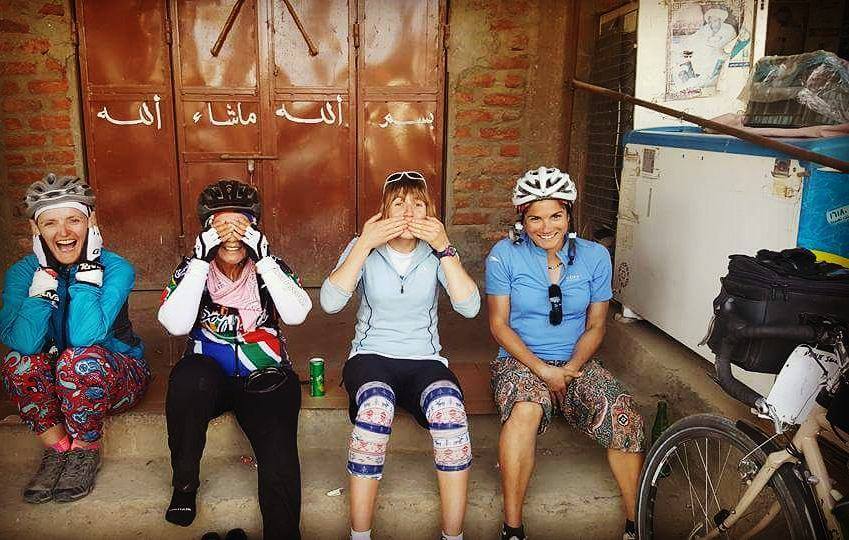
As Ms McLaren learned from her experience in 2010, “It becomes clear the most challenging thing about spending four months on the road in Africa under extreme physical duress, with little to no privacy, is the group dynamic.” When you think about it, it certainly makes sense. You are bringing together a large group of individuals from all over the world, from completely different backgrounds, with completely different goals and asking them to come together and spend 4 months in close, very close, contact with each other. Day after day. Week after week. Month after month. All while dealing with the highs and lows of cycling from Cairo to Cape Town. Something has to give, right?
Well, certainly there are tensions that arise amongst the cyclists. That is to be expected but, perhaps counterintuitively, the close quarters that may contribute to disputes also provides a safety valve that is not available back in the ‘real’ world back home. As one rider told Leah McLaren, “At home, you can retreat into your routines, into your job title, into your comfort zone. Basically you can persistently be an asshole. Out here, that’s not going to fly. Someone’s going to call you on it.”
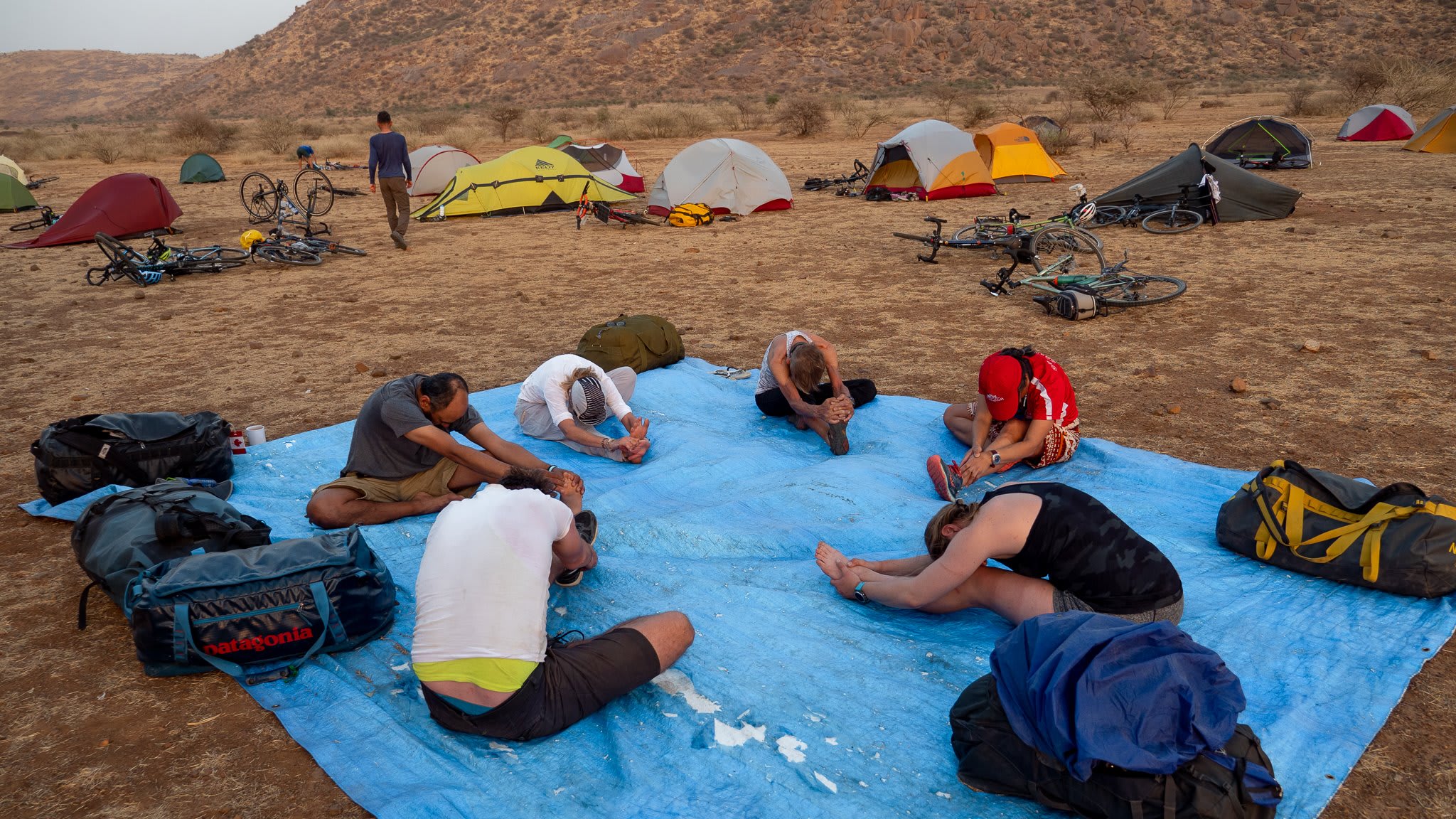
Group yoga lesson, Sudan
So instead of descending into a Lord of the Flies situation, as the days go by and the distances pile up, the riders actually begin to work together as a team with a common goal. On the 2017 expedition, staff member Brad Davis wrote, “Riders who often used to cycle half-days and be utterly exhausted of a night are now riding the full day every day then going for a wander through the local villages in the afternoons. Riders who were disheartened to learn they wouldn’t have the option of a shower tonight or would be none too impressed that the local bar’s Wi-Fi didn’t work are no longer fussed about campsite conditions, instead improvising or making the most of it. Where cuts and bruises used to be a source of distress, now they’re a source of show and tell at camp or simply shrugged off in a “shit happens” kind of way.”
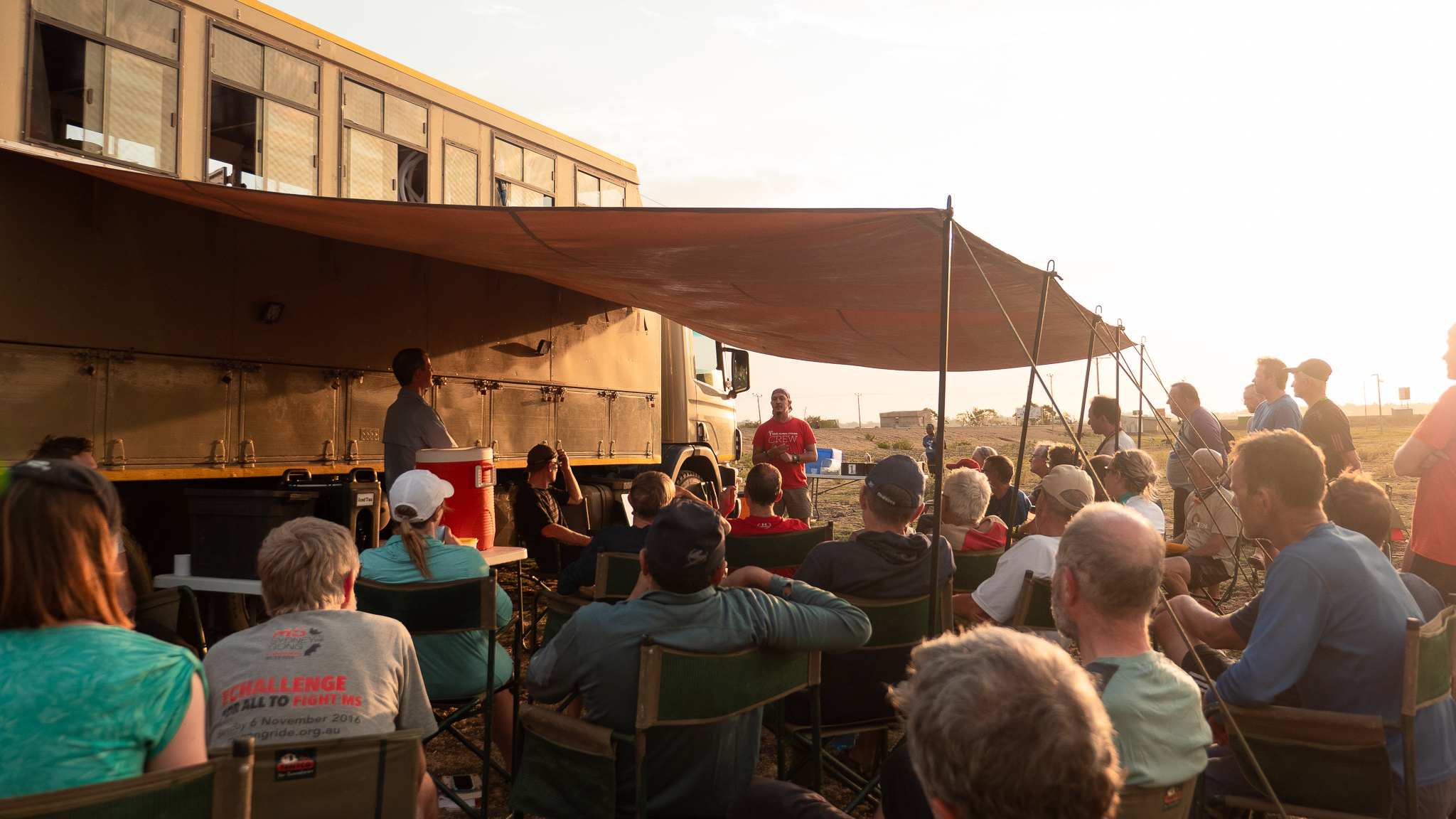
These individual transformations completely alter the group dynamic. In 2009, the dinner truck, which usually heads directly to the next campsite to get dinner ready, got stuck and wasn’t able to get to camp until long after dark. How did the riders react? Were they angry and upset? Nope. “Riders; exhausted, dirty, sweaty, thirsty, descended upon the vehicle but not to clamber on board for their tents and clean clothes but rather to assist in getting dinner prepared. The kitchen was set up in less than five minutes and platoons of riders, some still wearing their CamelBacks were jumping at the chance to cut carrots, peel onions or tip-n-tail beans. Dinner for 70 odd people was ready in a flash. While this could be simply discounted by saying “well, the people wanted their food”, what happened after dinner could not. A call went out from a staff member for volunteers to scrub pots, a call that was responded to by a mass of exhausted, dirty, sweaty but now well fed riders who chose to forgo setting up their tents or relaxing with friends to go that extra mile for the benefit of all.”
>>Related Post: How To Thrive On Group Cycling Adventures
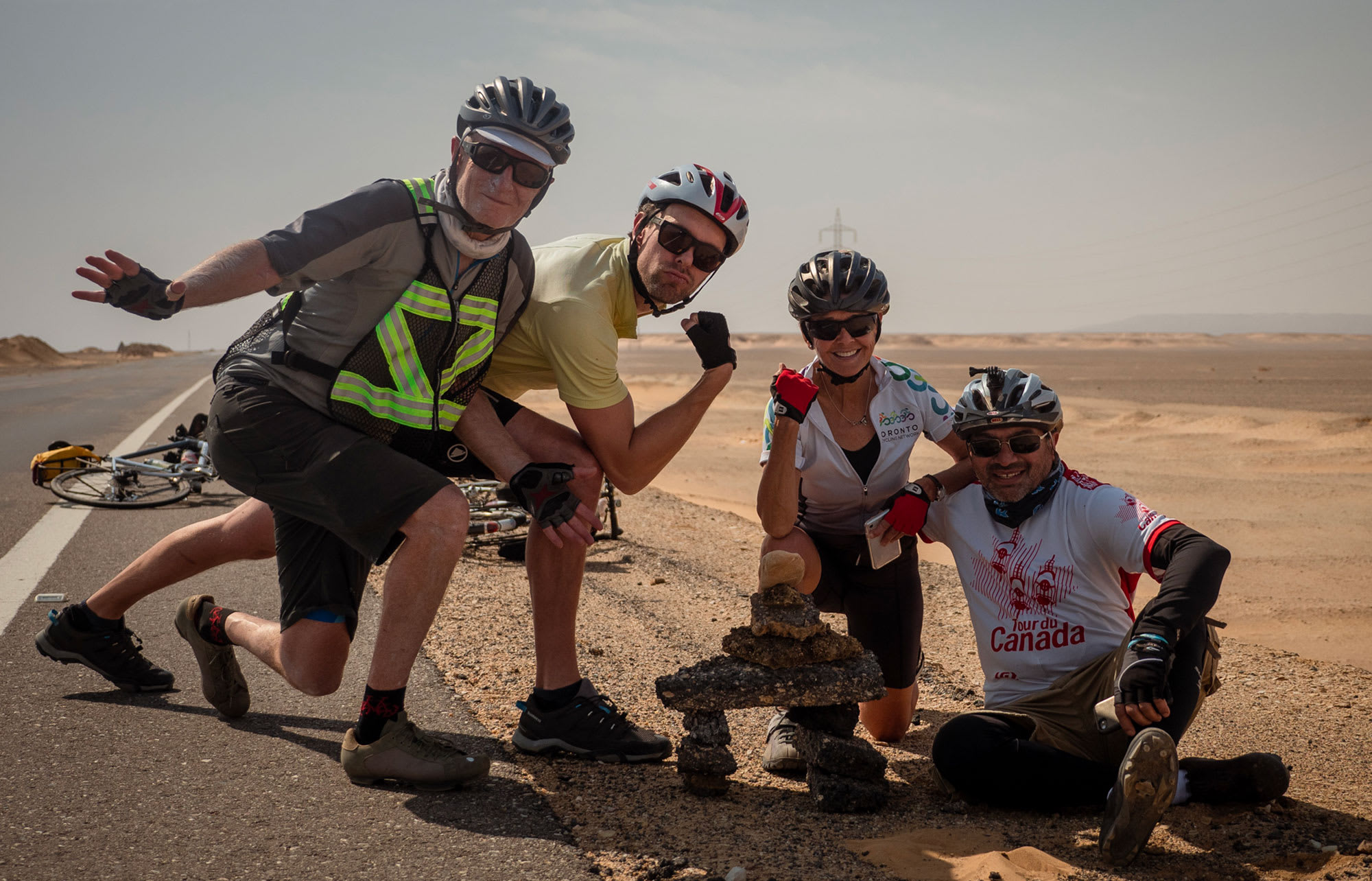
This really is quite something to see. To experience. In 2012, field staffer Catharina Robbertze was amazed to observe that, “After only one month strong friendships have already been formed between a writer from Holland, a veterinarian from England, a student from Australia and an engineer from Ireland. Retired policemen have befriended businessmen, chemists are getting along with actors and singers are getting to know zoologists better and better every day. They’ve gone from friends making small talk to people who aren’t shy to burp, fart and snore in front of each other and know more than most lifelong friends know about each other.” In a similar vein, Brad Davis wrote, “As I sit here, half a dozen riders from five different countries who would never have met each other if they hadn’t all had the insane idea of riding a bicycle 12,000 kilometres across Africa are sitting around a table drinking coffee, chatting, laughing, and squabbling over who gets the pleasure of buying everyone a slice of cake.”
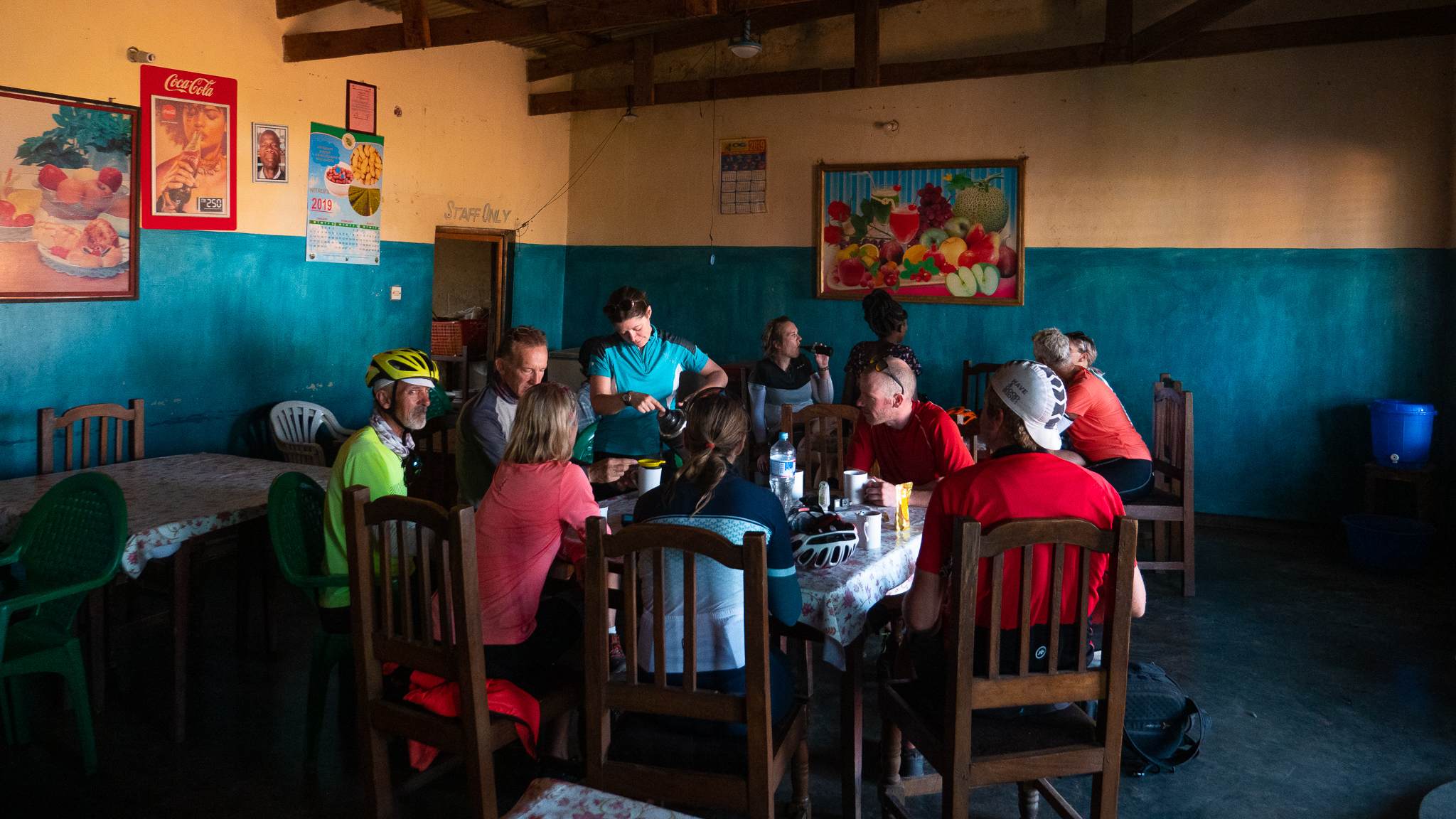
Within the larger group, riders with common interests and attitudes also gather together. In 2005, David Houghton noted that, “The eight charter members of the TDA Coffee Club rose early every morning and prodded one of the African Routes crew into putting the scorched coffee pot on the big iron burner. We sat quietly, tin coffee cups in hand, because many riders were still asleep, and watched the sun peek over the horizon, the silence broken only by a fart from a tent, or the call to prayer from a mosque in the distance, or an ambitious rooster. The Coffee Club was our secret society. It gave us time to think, and to appreciate, and to anticipate. Every camp was different, and every day on our journey was different, so the Coffee Club remained a daily ritual, dependable as clockwork. The calm before the storm.”

All this is not to say that there are not issues during the tour. Riders argue, people fall in and out of love, personalities clash and misunderstandings are not infrequent. And the moniker, ‘Tour of Freaks’ is not without validity! Over the years our field staff have noted that the 3/4 mark of the tour, just around Victoria Falls, marks the start of what they call, ‘silly season.’ Of course, the traditional ‘Booze Cruise’ on the Zambezi River likely contributes to the atmosphere but it seems that after 3 months on their bikes, the riders just need to blow off a little steam. After a while, the group generally settles back down for the last stretch to Cape Town.

So, as Leah McLaren said, the Tour d’Afrique is one of those things you have to go through to fully understand. So what are you waiting for? Join our ‘Tour of Freaks’ on their next adventure and be part of the madness!
RELATED
TOUR

Tour d'Afrique
Our original trans-continental journey and flagship expedition crosses Africa from north to south, covering 10 countries in all. Beginning at the...
]]>
Mats Fredrix is the Content Creator on the 2023 Tour d’Afrique from Nairobi to Cape Town. He sends this report from the desert in Namibia.
Gravelling through Namibia from Windhoek to the Great Orange River produced some stunning views of cyclists battling some of the toughest stretches of dirt in the world, just a week from their trans-continental finish line in Cape Town.
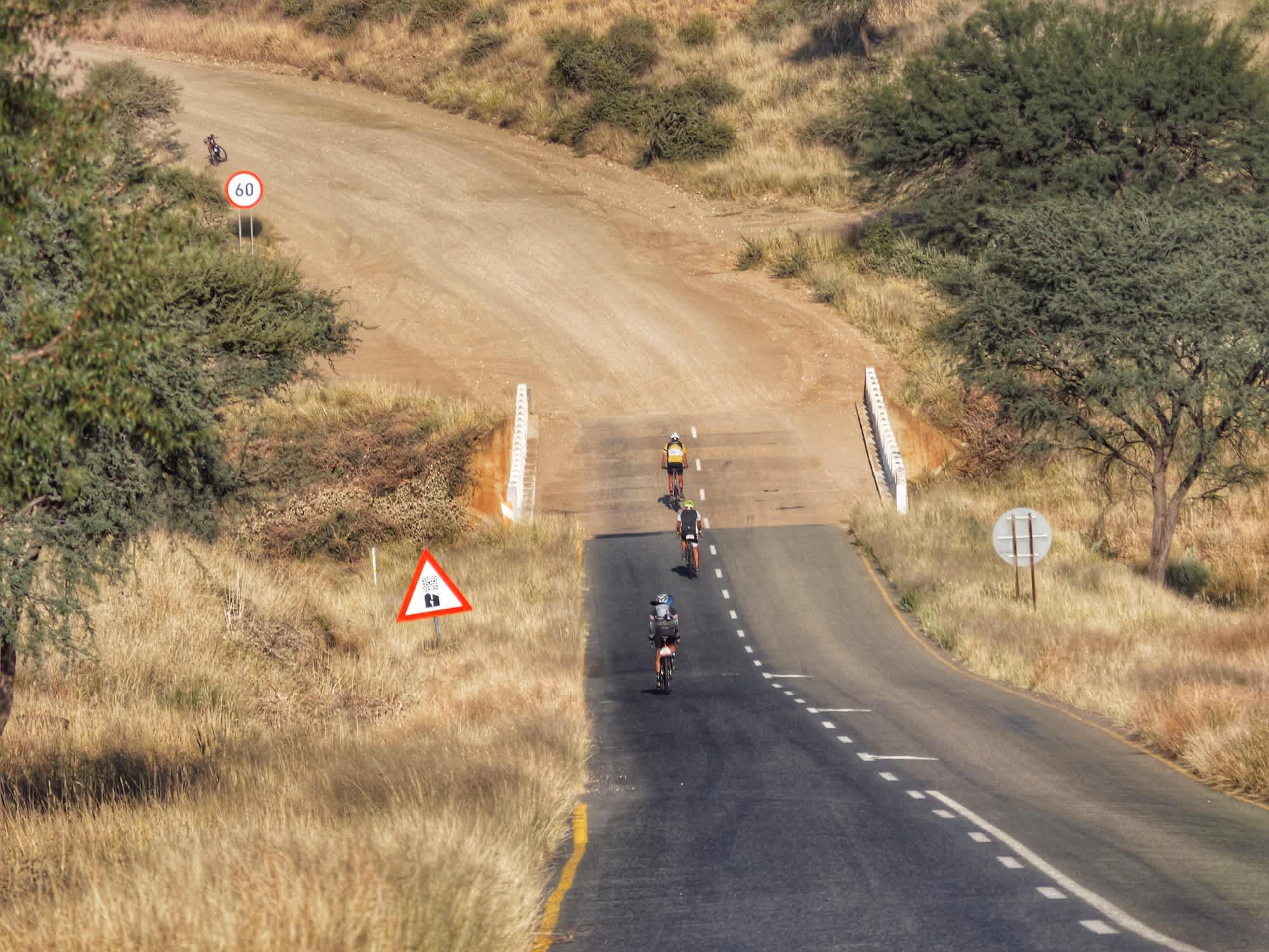
And so it begins…
Canadian rider Greg Duncan stated, “I had never done that much gravel in my life, I’m fairly new to biking long distances, and when I looked at the distances I thought, what a challenge this is going to be” while fellow cyclist Peggy Schrieber added, “Those first days were rough. Hot, deep sand, washboards… It felt a little bit like it was never going to end. Those were probably for me the hardest days of the whole tour.” Bernd Sydow from Germany noted that, “Some of those days were so hard, people would stop riding a bicycle after doing a stretch like that. But it was also my favourite section of the whole tour haha!” and American rider Jane Clark admitted, “I had been dreading it, and then after the first day, which was really tough, our ATD Britney had a little seminar. She answered a lot of my questions and offered a lot of tips, it really helped.”
By the time the Tour d’Afrique arrived in Windhoek the phrase ‘the final stretch’ was on everyone’s lips, though the actual finish line was still painfully far away. In the TDA world distances are counted in rest days and Cape Town was now just two rest days away. The actual fifteen riding days that separated them from the finish line, no one really mentioned. Botswana was in the rear view mirror at this point and the mere sight of hills at this stage was pure joy to every rider. No more long, never ending straight tar roads through the bush. Namibia was coming, and it promised to be very different.
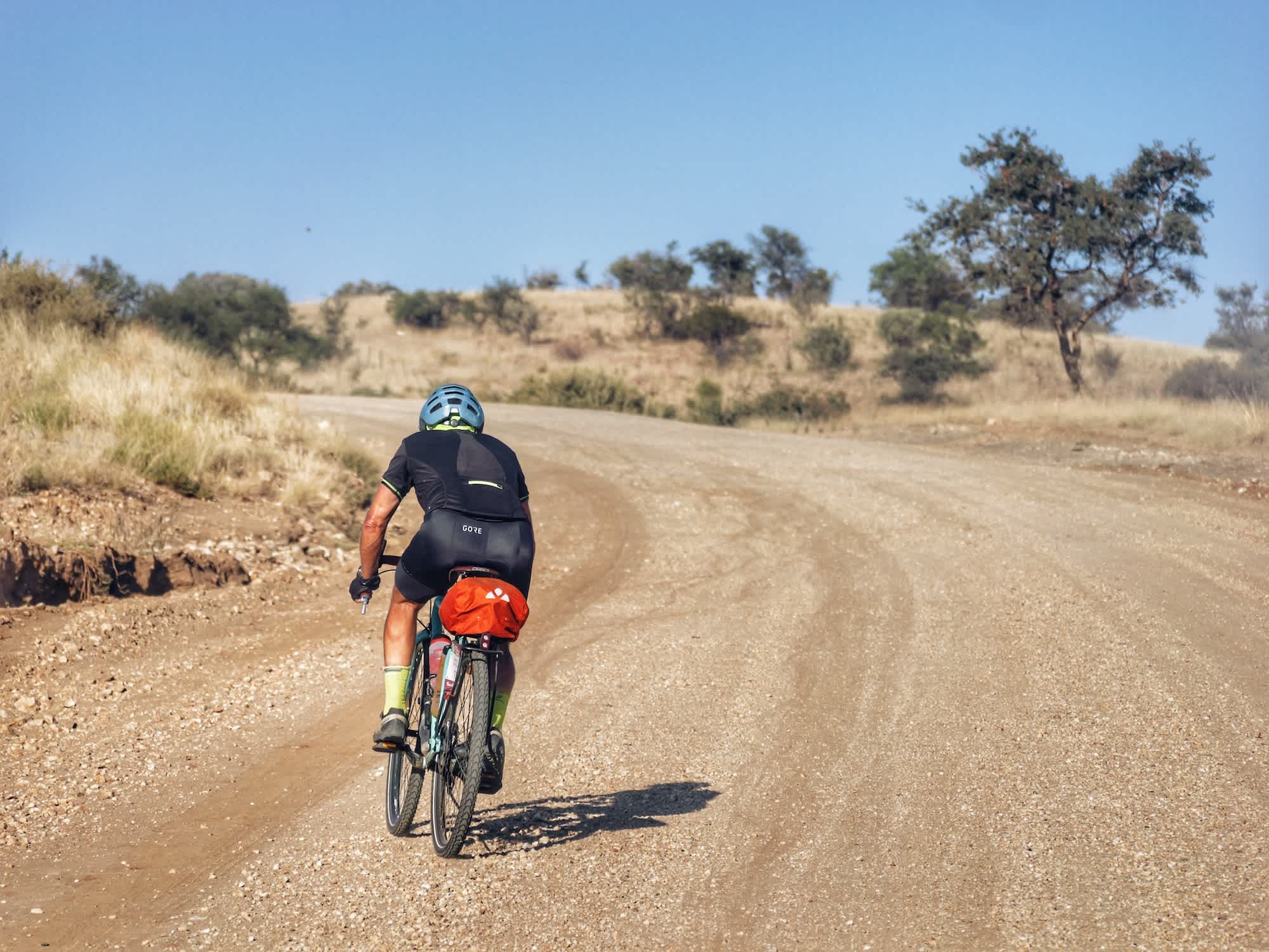
That change, as it tends to do on TDA tours, happened gradually. It started during our bus day into the Namibian capital of Windhoek. Surrounded by hills, it was a marker of change, as it is here that a new section of the tour began – Dunes & Atlantic. Urban Camp in Windhoek was the base of operations for that final segment. It’s where we prepared for what is to come: nine days of dirt. Just a tad over 1000 km, all the way from Windhoek to the border of South Africa and the Felix Unite campsite next to the Great Orange River.
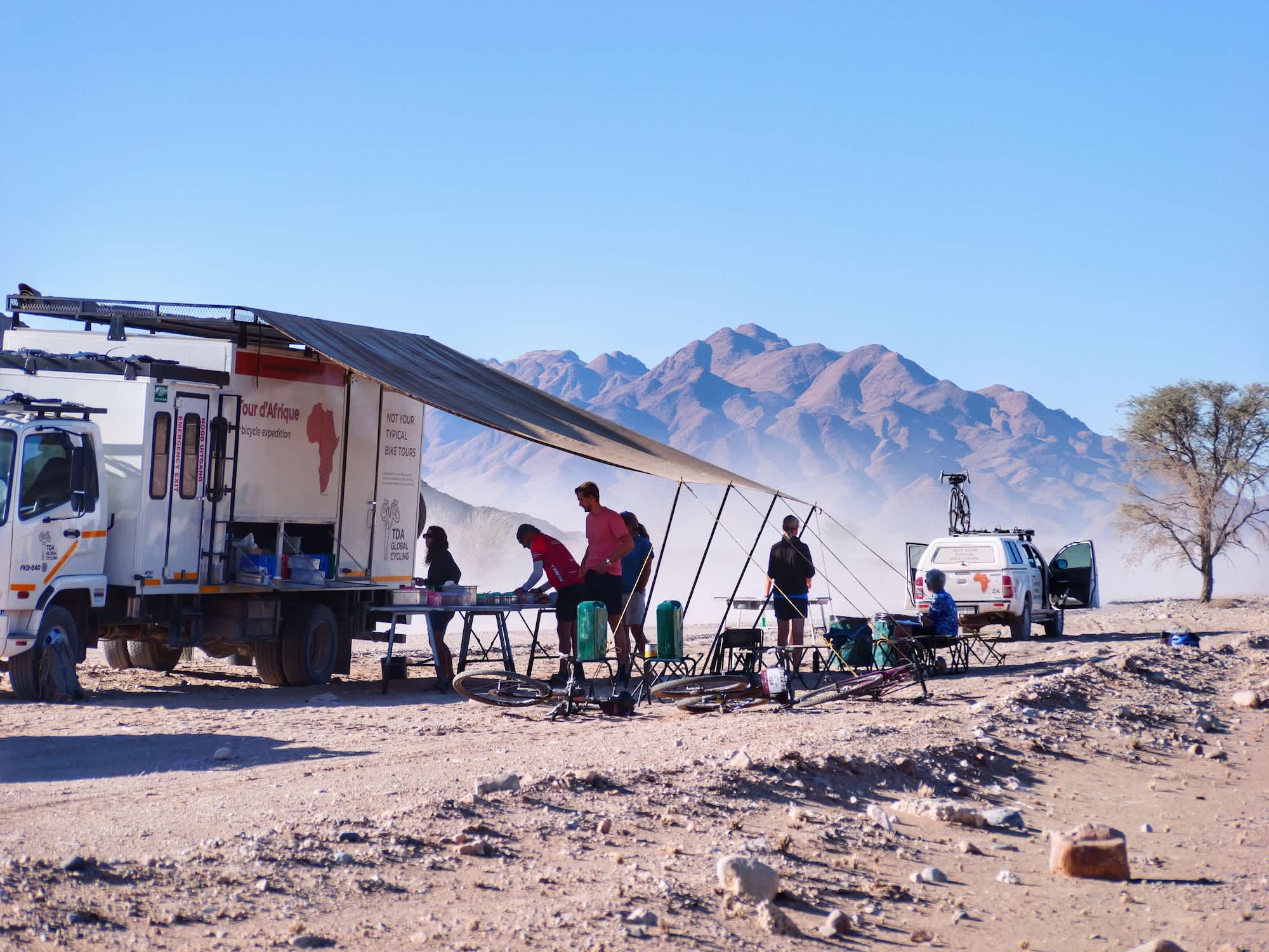
You could tell something big is in the offing by the hustle and bustle surrounding the bike clinic on the rest day. Tires everywhere. Different types of shock absorbing mechanisms being tested and scrutinized: from suspension forks to handlebar and seat post suspension. When it comes to absorbing the shocks, most still stuck with lowering the tire pressure significantly as their primary tactic to tackle the dirt. All sorts of advice on how best to handle Namibia’s infamous gravel roads was constantly being offered and received. The mechanics were working overtime. “We first started talking about the Namibia stretch on the dirt in Tanzania,” said rider Peggy, “At that point we started to think ahead of what Namibia would be like, and started comparing it with what we had heard about it.”
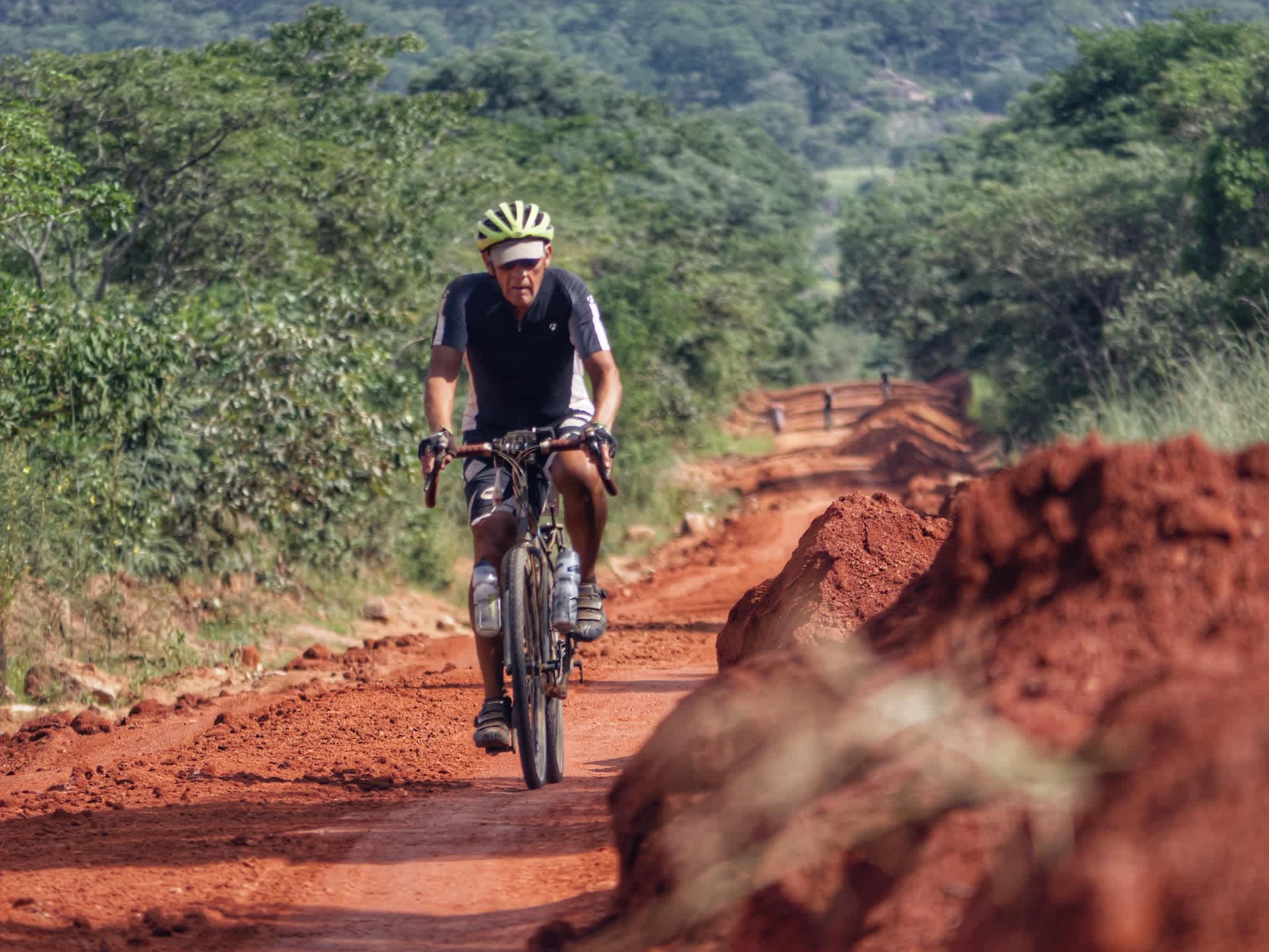
Dirt in Tanzania
The Namibia dirt road stretch is arguably the most highly anticipated section of the whole tour and possibly the most challenging one. It’s no small feat leading the whole TDA caravan close to, and even at times through, the oldest desert in the world: the Namib Desert. Hydrating and navigating correctly was at the top of the list in many rider meetings, but in the desert it really can be a matter of life and death. Bike Mechanic and TDA veteran, Doug Percival, put that message out there well ahead of time, “It’s no joke out there, I’ve really seen people crack!” His warning worked. Although it caused a bit of a stir, and no doubt some unease, nobody was going to underestimate the desert.
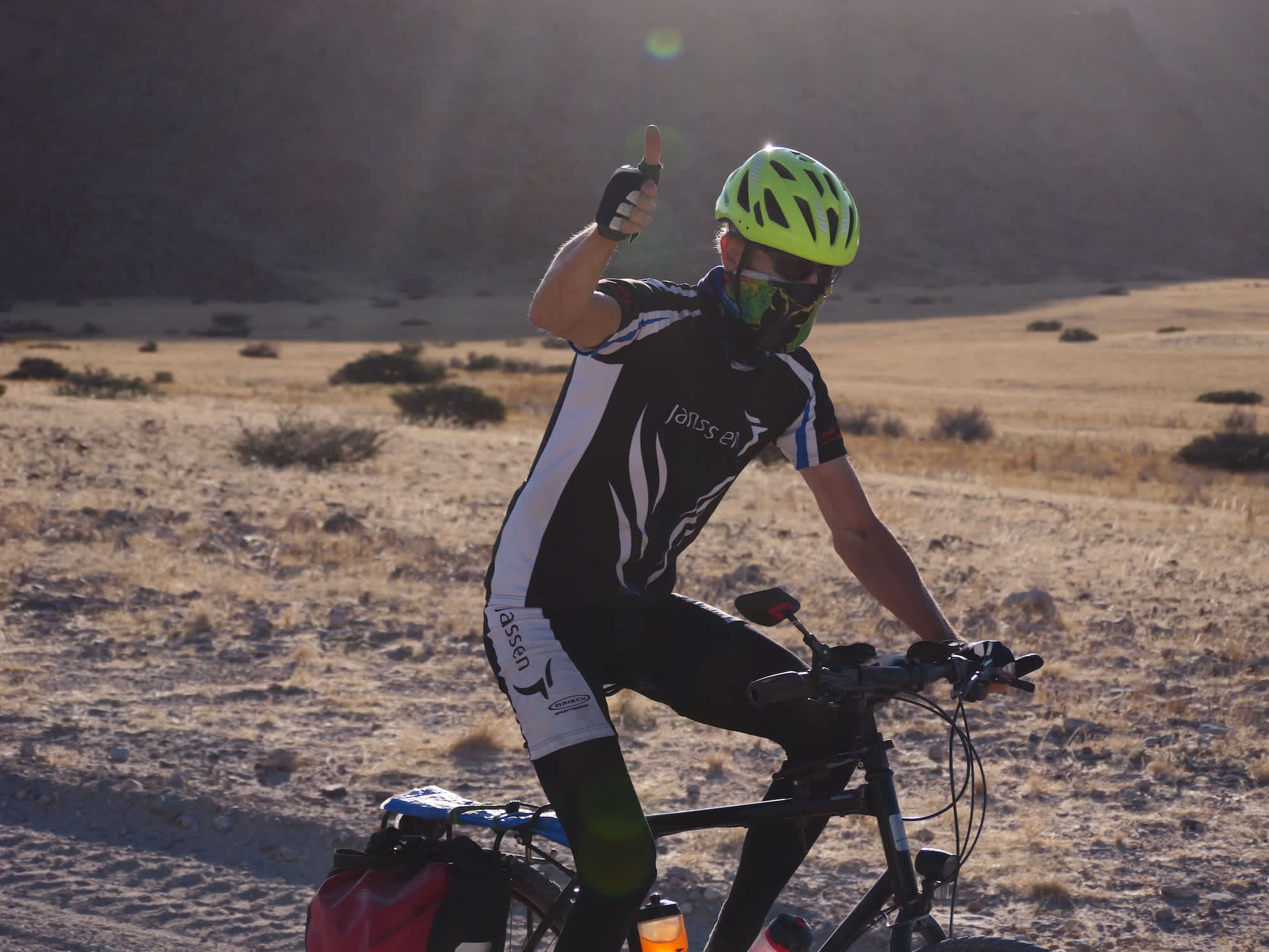
Tour Medic, Sam Covins, noted that it is a totally different style of riding, creating a lot of new challengers for the medical approach to the section. “Rough road surfaces can be hazardous, and highly increase the risks of falls. Dust clouds from passing vehicles can also irritate the lungs resulting in coughs, and breathing difficulties.” He advised the use of face coverings to avoid the excessive inhalation of particles, a tip a lot of the riders followed.
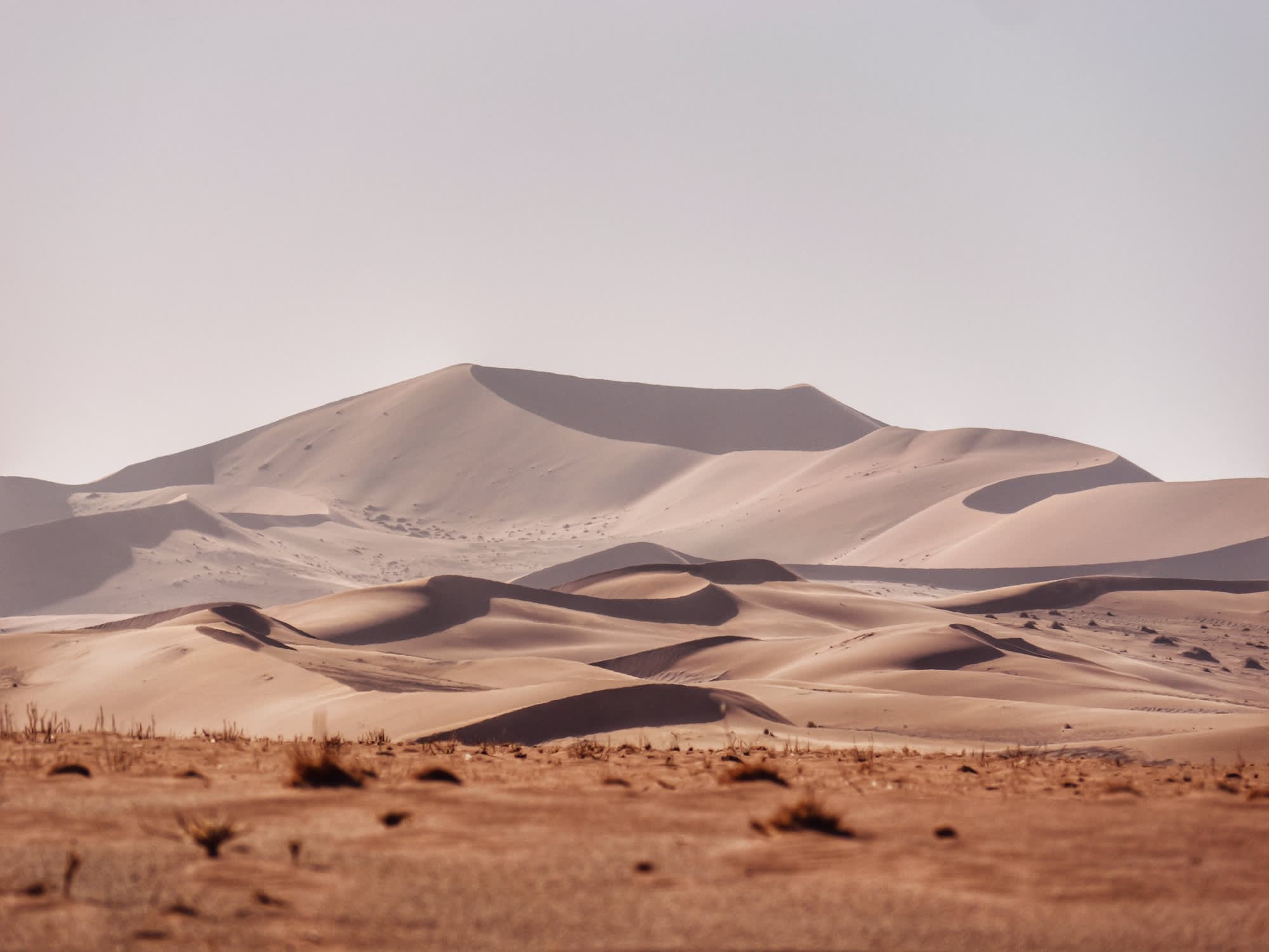
So, why do it at all? It’s a valid question and it does get asked quite regularly. Why ride a road that almost no cyclist ever rides? Well, TDA is a bicycle expedition, and the Namibian dirt stretch is exactly one of those far-out factors that makes the Tour d’Afrique the challenge it is. It is also one of the top reasons for a lot of riders to sign up for the tour, not just because they love riding the gravel but also because it offers up some of the most stunning scenery of the whole trip. “In Egypt and Sudan there was so much plastic, and so many people,” said one rider. “To me it didn’t really feel like a desert. So I was really looking forward to Namibia. And I got exactly what I expected. But I had to pay a price. Riding those gravel roads!” Those gravel roads are also the one and only way to get to one of the tour’s most famous attractions: The incredible sand dunes at Sossusvlei and the DeadVlei Valley.
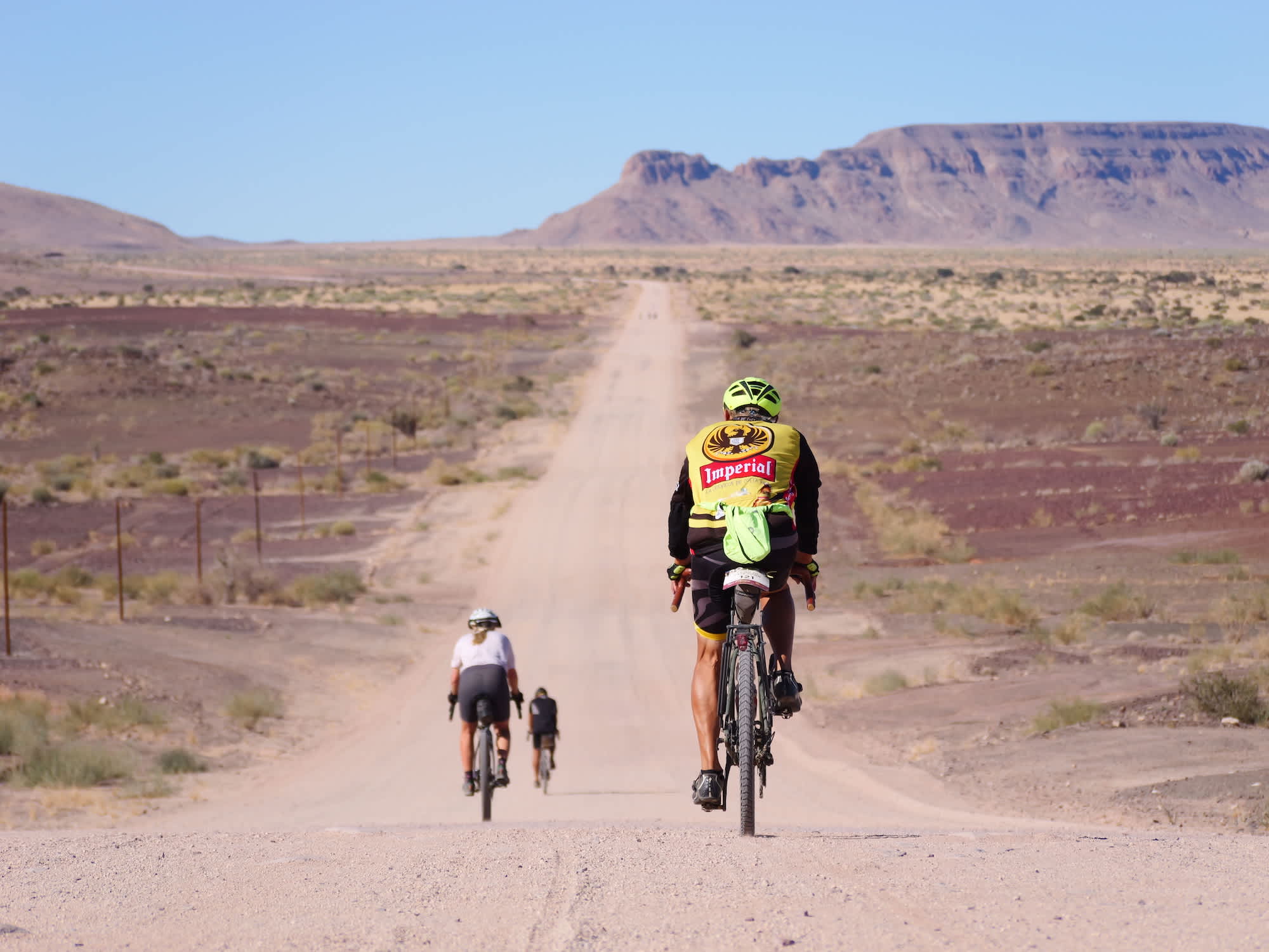
Riding on dirt roads. You either love it or hate it. It depends on who you ask. Assistant Tour Director, Britney Charme, has many years of experience guiding gravel bike tours in the US and says, “Namibian roads are what gravel dreams are made of. This type of riding appeals to those who enjoy grit and ruggedness in their cycling. It is for those who don’t mind the ever changing variables of desert dirt roads. In a single kilometre, the rider may experience deep sand pits, chunky off-camber terrain and corrugation. On the next kilometre the rider will be rewarded with champagne gravel, that smooth and freshly graded surface that allows the bike to float over the road. It is the hardest style of riding we do on this tour. Gravel road sections have a tendency to elicit strong opinions amongst the riders. It is a matter of personal riding style. Some folks prefer the predictability of paved roads. They appreciate the smooth flow of cruising along on a tarmac road. The riders can, and do, debate the qualities and superiority of gravel vs. tarmac all day long but one thing they agree on is that these gravel sections contribute to the character of the Tour d’Afrique, an extra dose of spice and the adventure that we are all here looking for.”
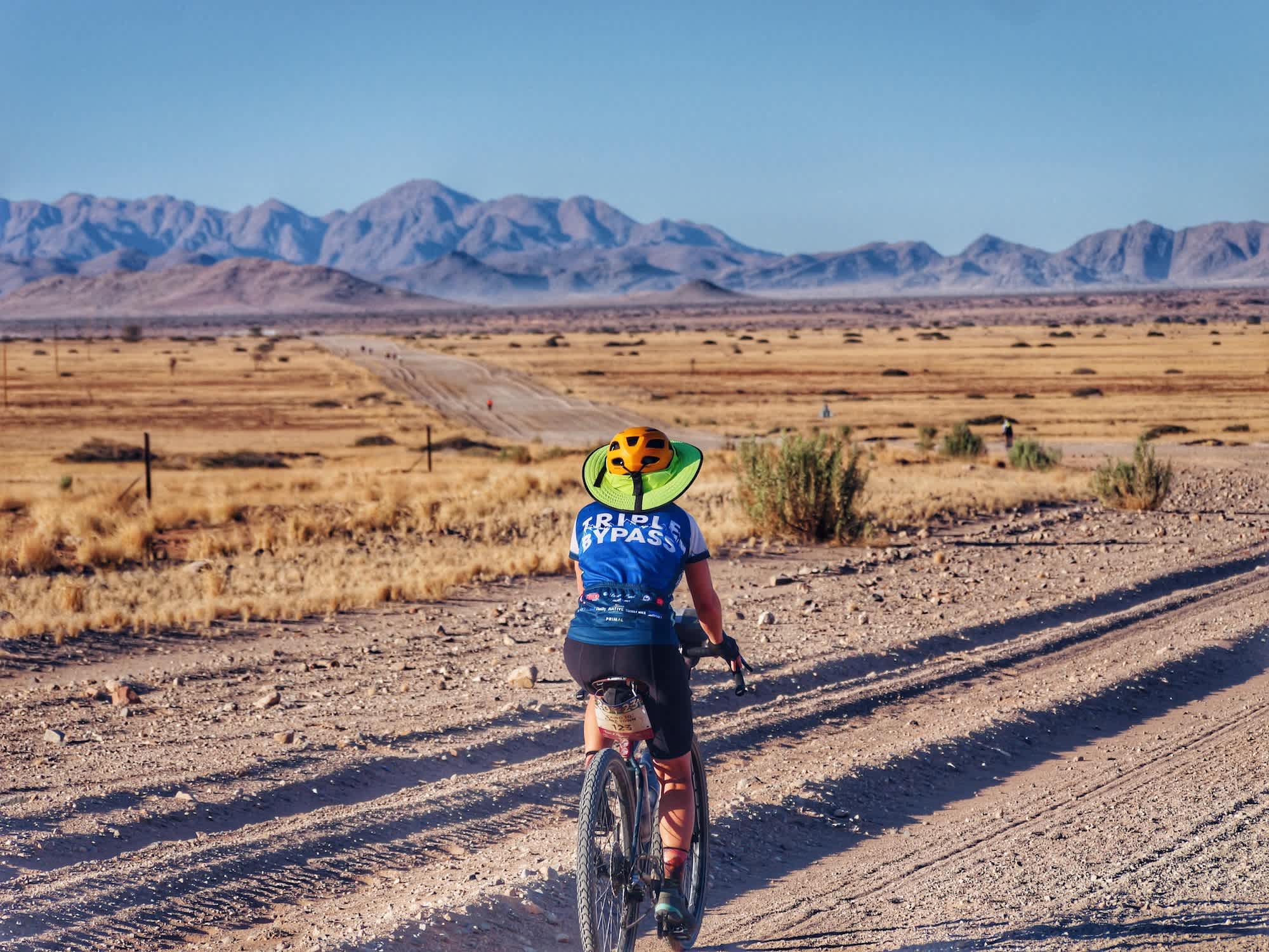
“I wanted to do as much as possible of the section,” said Jane Clark, “while also figuring out how to deal with the heat and my body tiring. I decided to do half days now and then, and that was a great decision, as I was actually able to enjoy myself out there and get a sense of accomplishment.” This was an approach a lot of riders took to heart. “I was very grateful to have the TDA set-up,” said Bernd, “I decided to just ride half-days, and this changed everything for me. I could still enjoy the desert, ride every day, but not have to ride every single meter. That made it so easy, and it made it so enjoyable.”
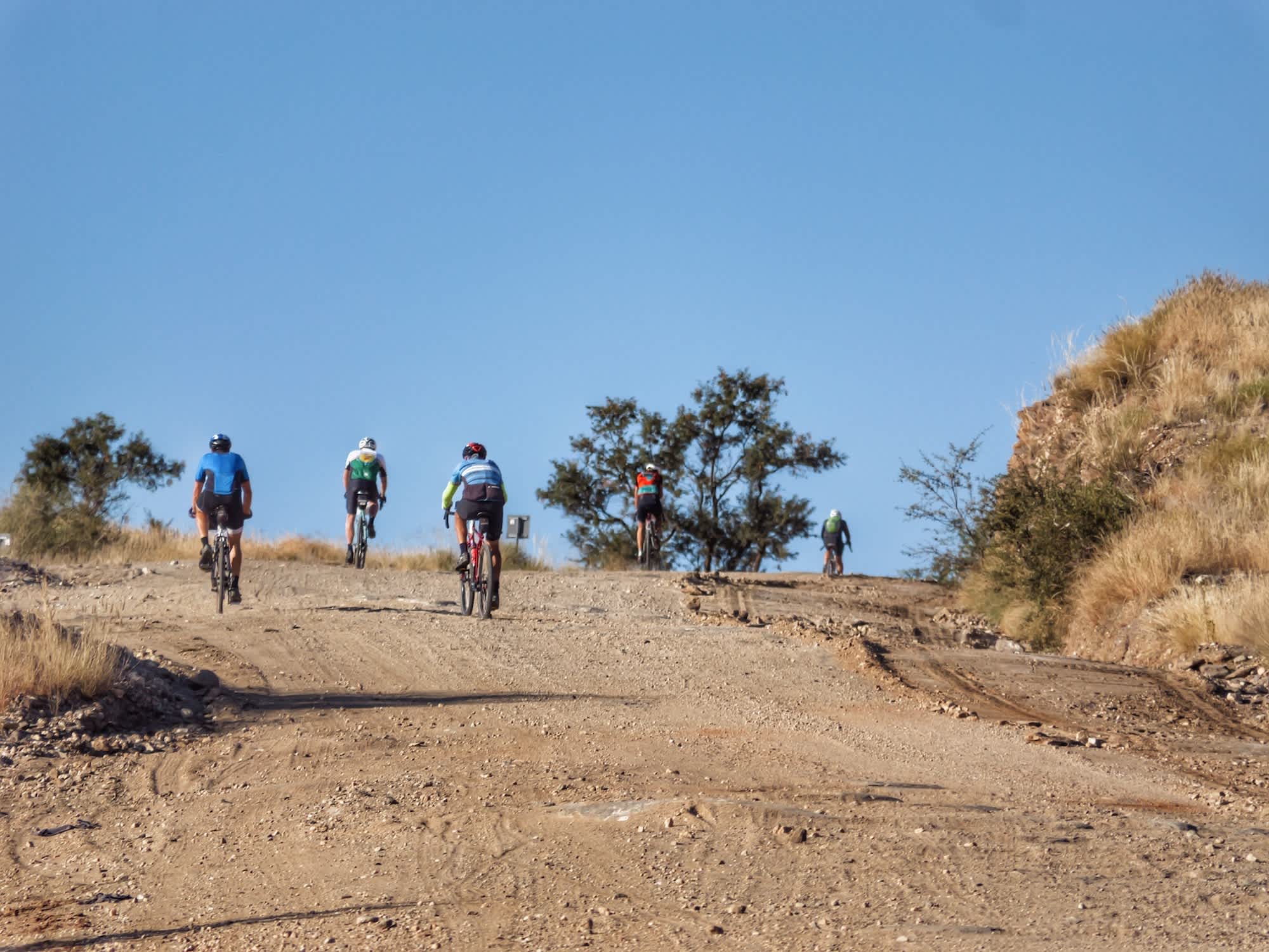
“I got a lot of tips from fellow riders, in Tanzania already,” admitted American Peggy Schrieber, “keep pedalling, high cadence, just keep going! That kind of stuff.” “My confidence only rose over time,” added Jane, “Finding a line is super important, and I got so much better at that.” Peggy added, “There were moments when I would see people ahead of me having to get off the bike, and I found a different line and I got all the way through it, and I was like: yeah! It was a confidence builder!” And then there was the reward. Those rocky mountains constantly in the background, the desolation…“The night skies were incredible,” said Peggy, “horizon to horizon, more stars than you could possibly imagine.” “I’m a stopper,” said Greg, “and the landscape was just phenomenal. It’s just so quiet. There’s no sound at all. I’ve never experienced anything like that in my life”
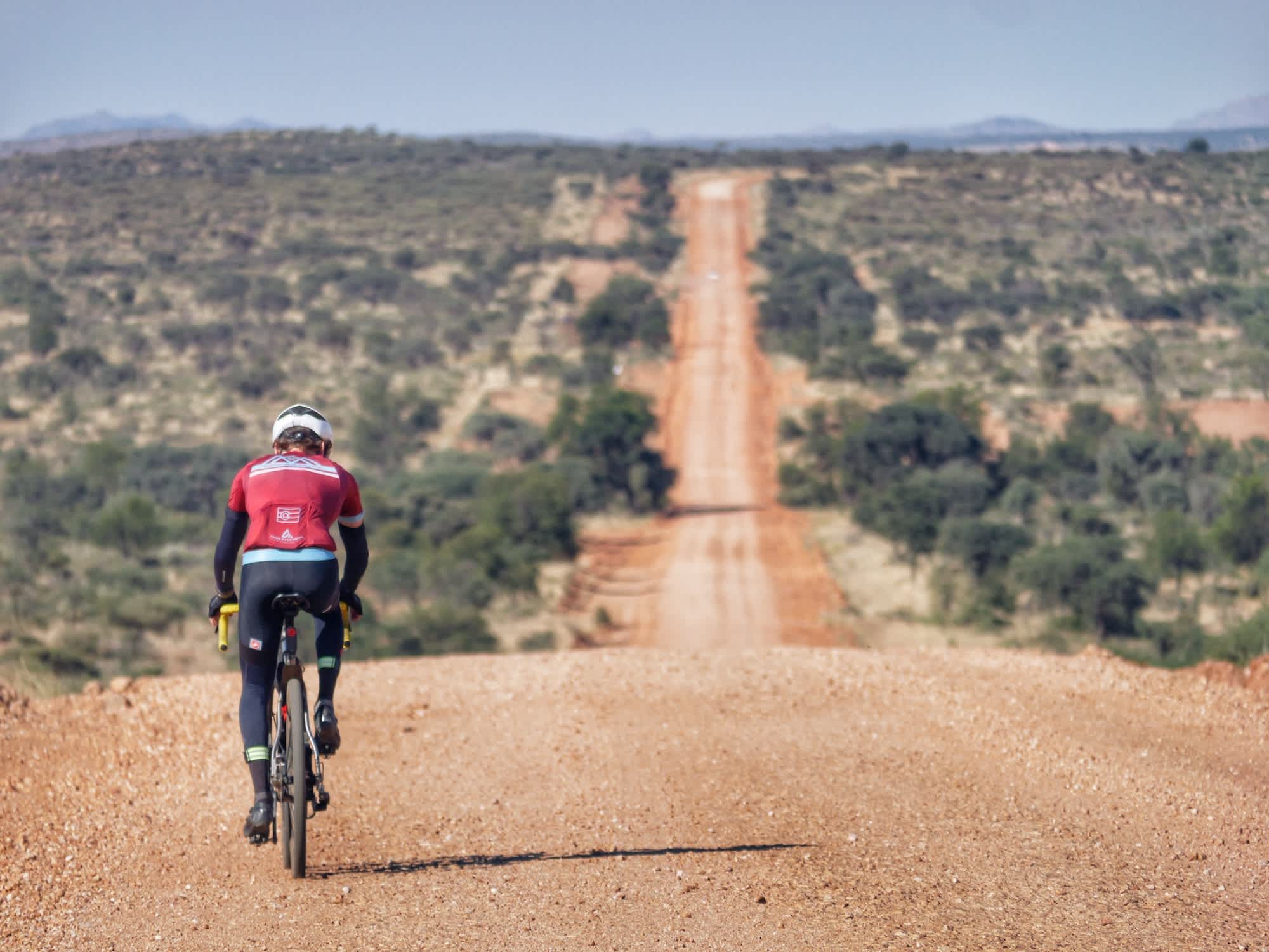
Dutch cyclist Bas summed it up pretty well while enjoying a dip in the swimming pool at the Felix Unite camp after a gruelling final day in Namibia fighting some of the strongest headwinds of the whole tour. “This was so tough, but it’s like we’ve been training for it the whole tour. Mechanically, physically and mentally we really needed every ounce of our courage and experience, but we did it! I think the tour is built really well,” added Peggy, “By the time we got to this section, we are tired, yes, but we also have the skills and the endurance to get through it. In the end, those six days were done in a flash!”
RELATED
TOUR

Tour d'Afrique
Our original trans-continental journey and flagship expedition crosses Africa from north to south, covering 10 countries in all. Beginning at the...
]]>
Every year, the riders registered for the Tour d’Afrique spend a lot of time, sometimes perhaps too much time, deciding which bicycle they want to bring on the expedition. Most riders have more than one bike at home and have to make a choice – mountain bike, gravel bike, touring bike? They agonize about tire size, gearing, suspension, brakes, and much, much more. Of course they do. They are about to pedal across Africa from Cairo to Cape Town so, obviously, some concern is to be expected.
Once they hit the road and begin cycling, they may begin to see that their fancy machines seem somewhat out of place. As a past Tour Leader put it, “We may act as role models showing the Western World that you can travel anywhere by bike, but being here we also learn that the bike is far more than an instrument of sport or recreation…. it is a tool of empowerment for the people.” After all, in Africa, especially the rural areas, a bicycle, any bicycle, is a basic need and serves many purposes – taxi, food delivery, cargo truck, ambulance, bus, whatever they can pile/load/strap onto it.
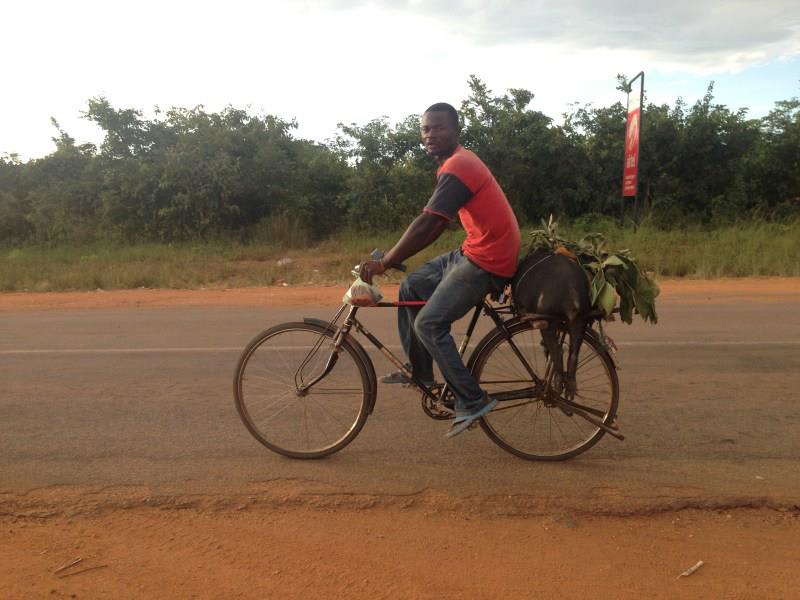
I remember cycling along in Zambia in 2006 feeling good, really good. I was now used to riding 120km/day without breaking the proverbial sweat. I was powerful and strong. Then a local man on a single speed bike that looked like it was ready to fall apart pulled up beside me. He had a pig tied onto his back rack, one that was almost his size. He smiled at me and I smiled back. Then he increased speed and pulled ahead of me. I responded in kind pulling ahead of him expecting to leave him behind. Not a chance. He went by me again and, despite my best efforts, pulled away, leaving me in his wake. A valuable lesson.
In 2014, the riders on the tour got a chance to understand the locals’ cycling experience as the result of the ‘Phoenix Experiment‘, named after the most popular brand of bicycle in Malawi and Zambia at that time. As the Tour Leader, Randy Pielsticker, noted, “the Phoenix is the typical African bicycle, a pure steel frame, with integrated rack and a kickstand that could replace an indoor trainer. They only come in one size but are complete with fenders, reflectors, a bell, pump, tire lever and wrench. Often when we see them on the road they are laden with livestock en route to the market or carrying 50 kg’s of charcoal, an entire family and their dirty laundry. They are not built for speed, they are built to be bombproof, and a few of our intrepid riders have volunteered to saddle up to these beastly cycles for the final 151 km of rolling hills leading us to Victoria Falls.”

The result? One rider got about 20km into the stage. Then his chain was not cooperating. Neither were his tires, fenders or brakes. Others decided to try to replicate the local experience by carrying a kilo of Malawi tobacco or a case of beer. Staff reported that, “We passed quite a few riders who weren’t actually pedalling their bikes, but dealing with mechanical breakdowns. As most didn’t carry the special tire lever that is about a foot long, repairs took quite a while.” Certainly a learning experience! Frustrating for the riders used to their own bikes perhaps but “The locals absolutely loved seeing everyone roll through on the same bikes as them. We got many waves, laughs, thumbs ups, and bell rings.”
So, in appreciation of the humble bicycles of Africa, here are some reminders of their endless possibilities!
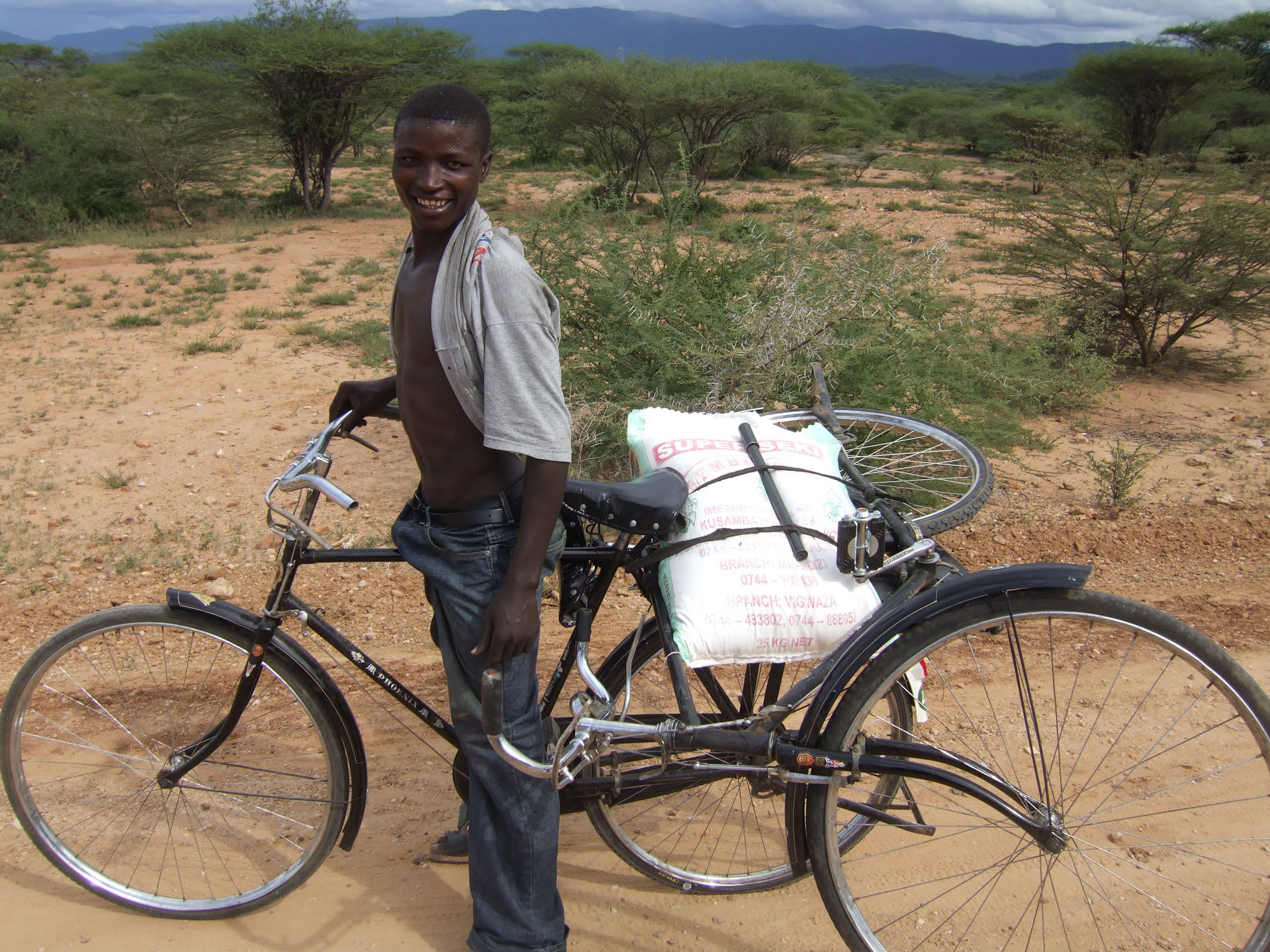
Bike ambulance
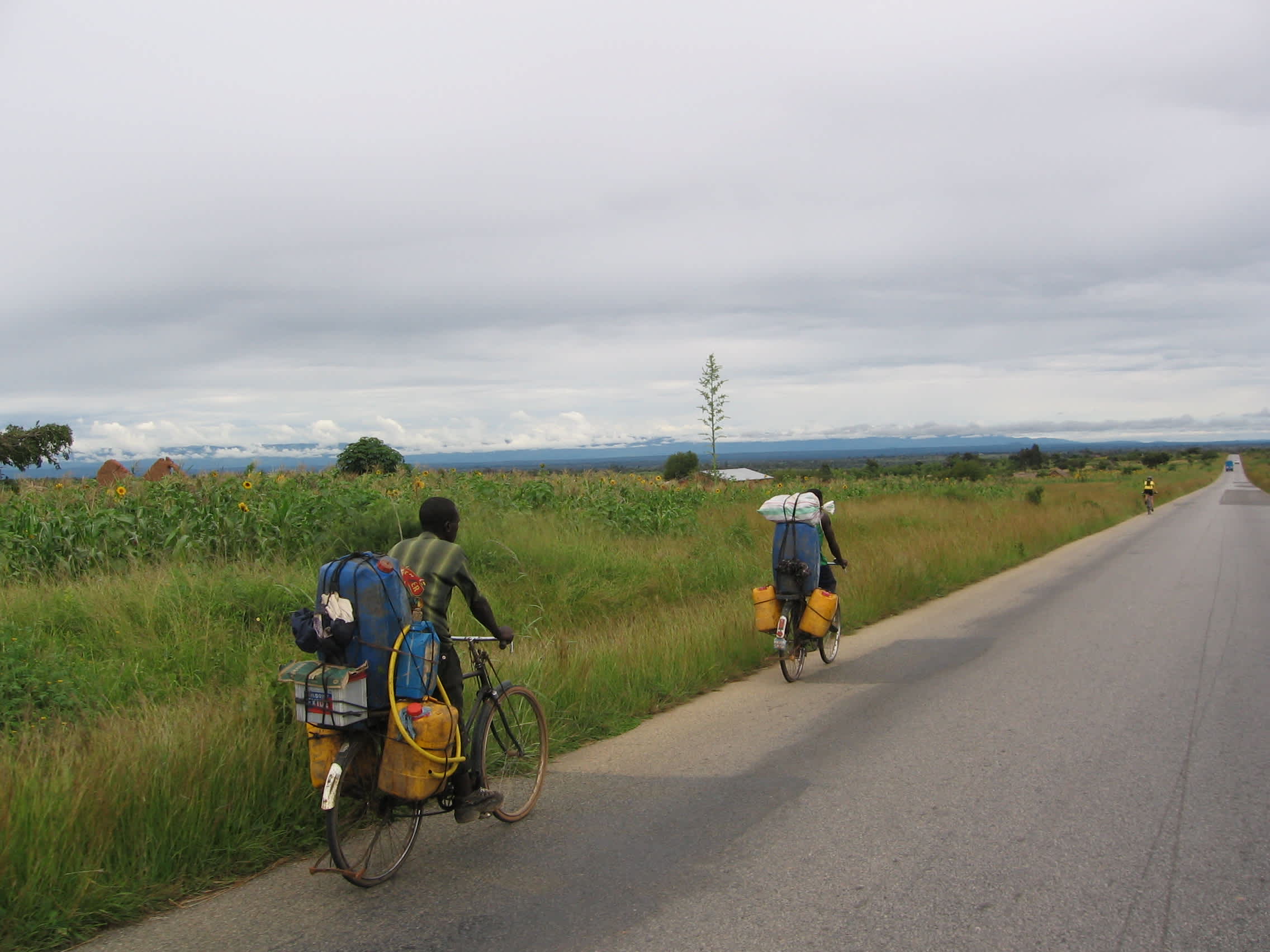
“We have seen the most bicycles in Malawi, by far. Everyone – from the youngest boy reaching the pedals only on his tip toes while hovering above his top tube; to the old woman transporting a pig on the back of her bike to the market; to the taxi driver taking a whole family downtown – are on a bike.”
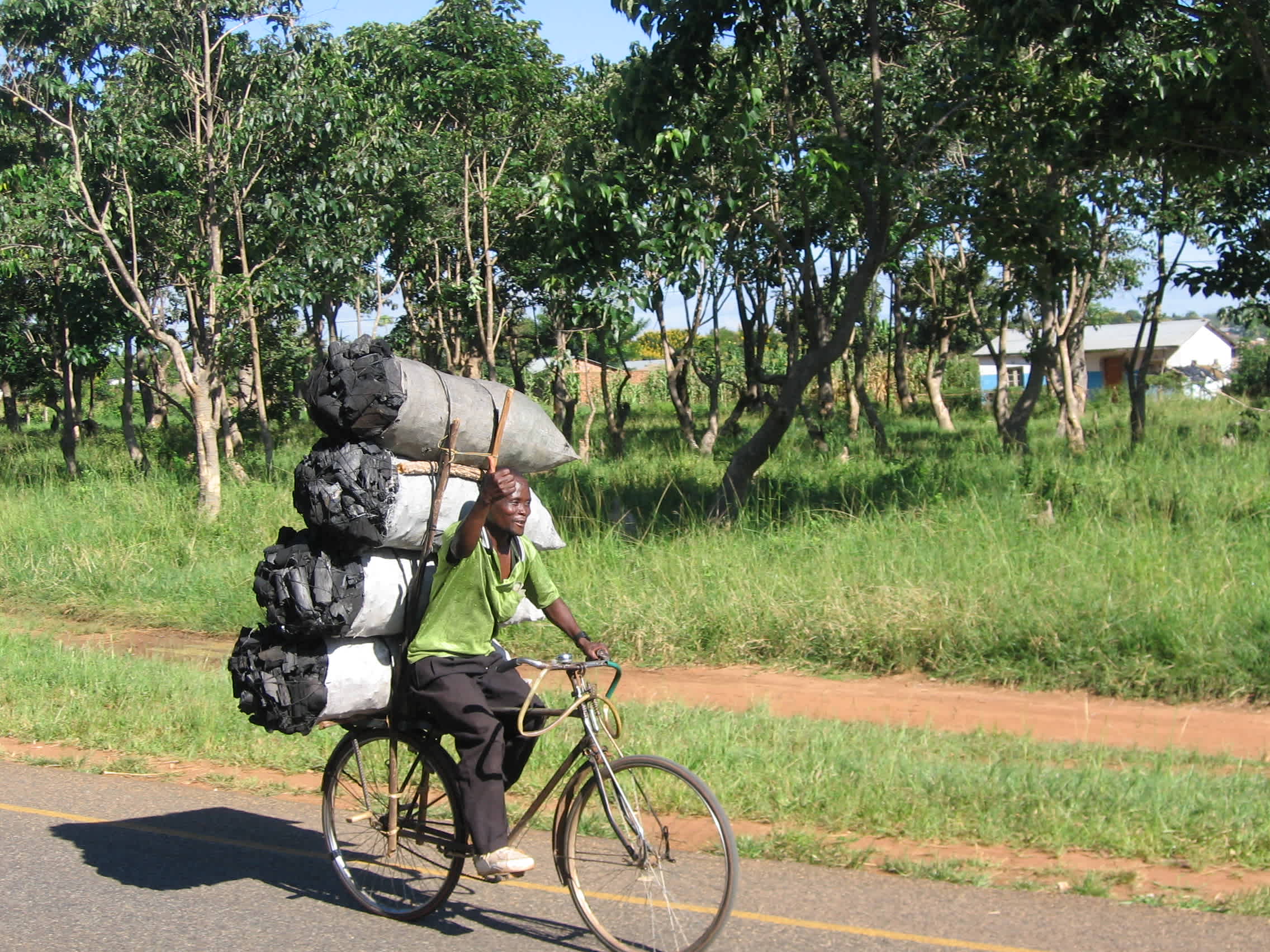
4 bags of charcoal – thumbs up!
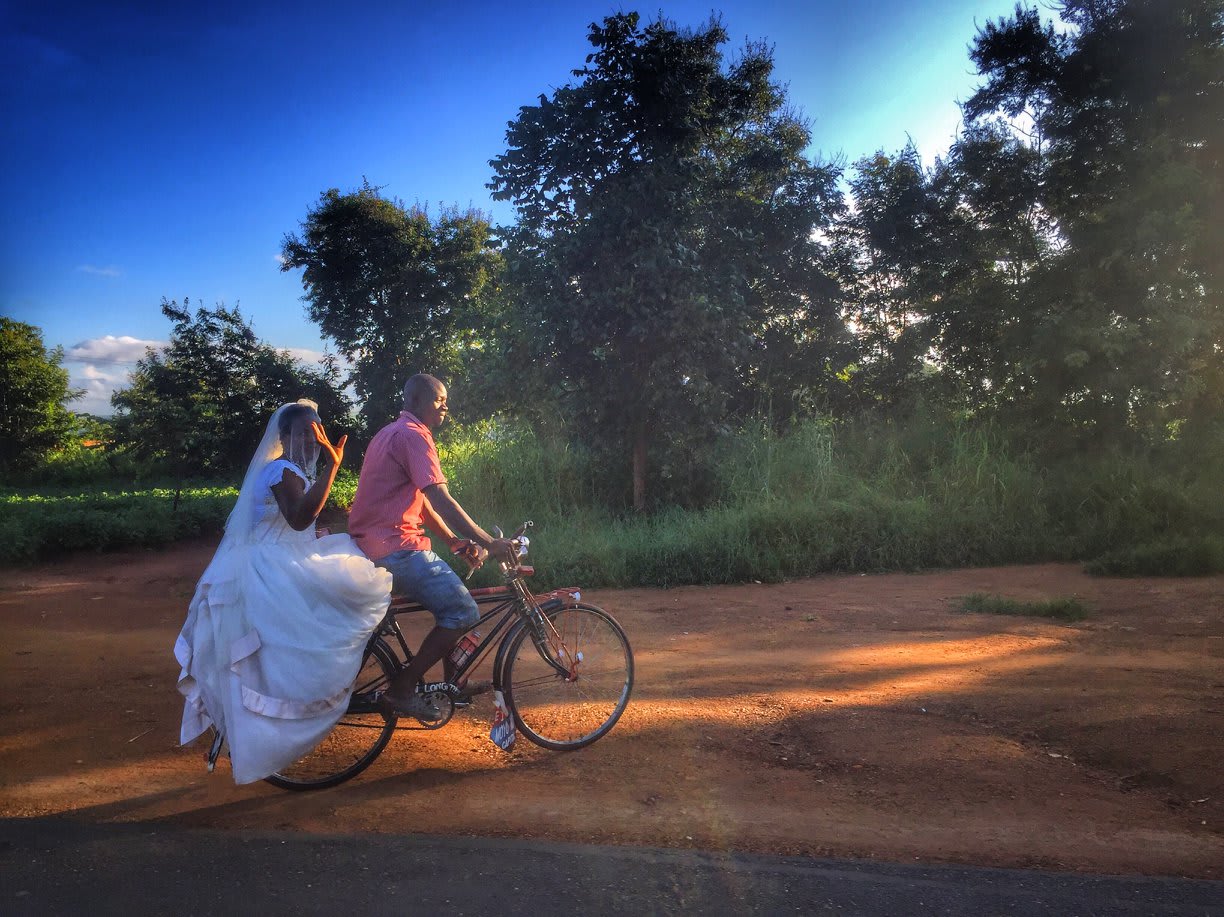
Off to the altar

Fire wood delivery
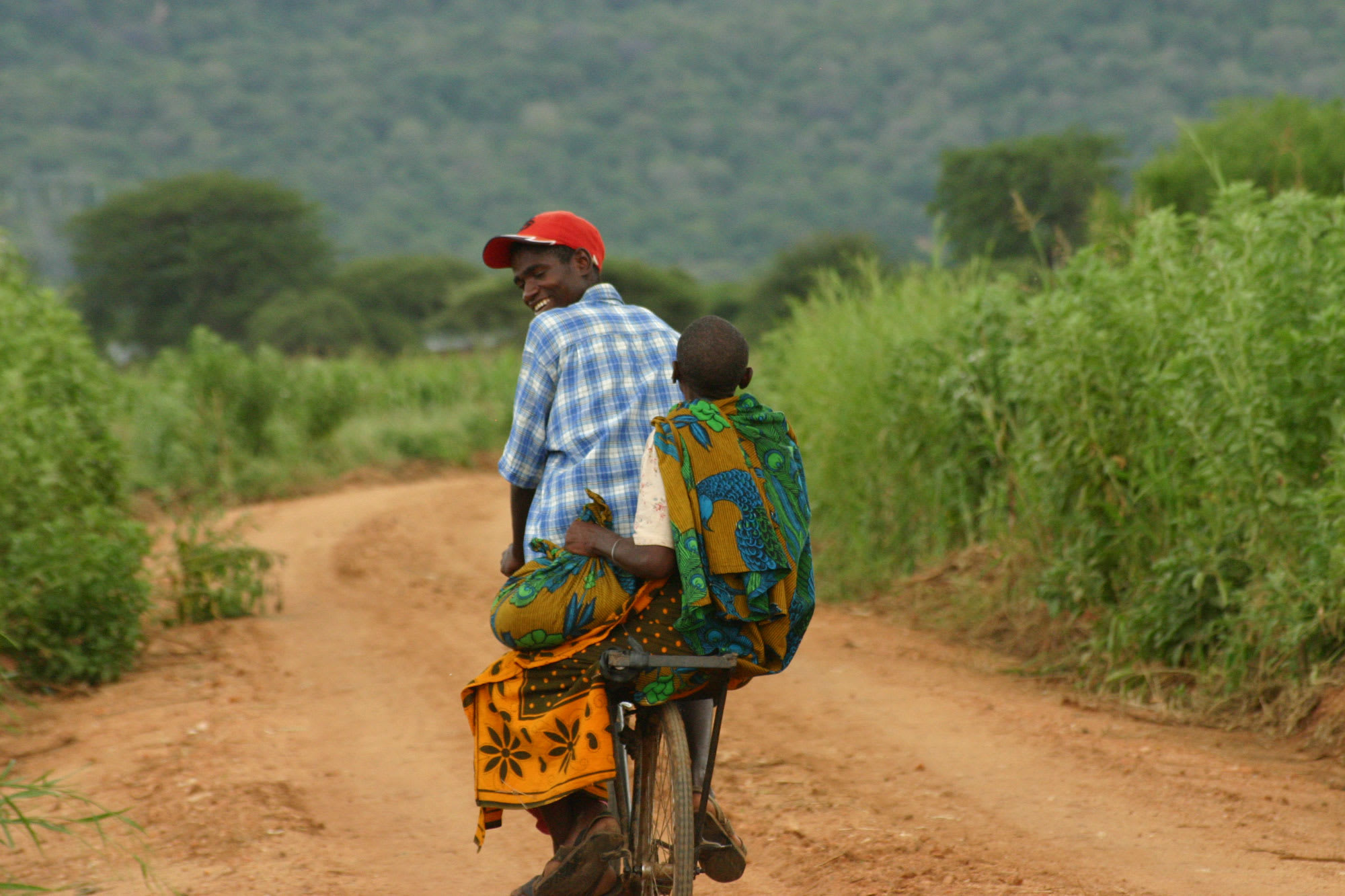
Bush taxi
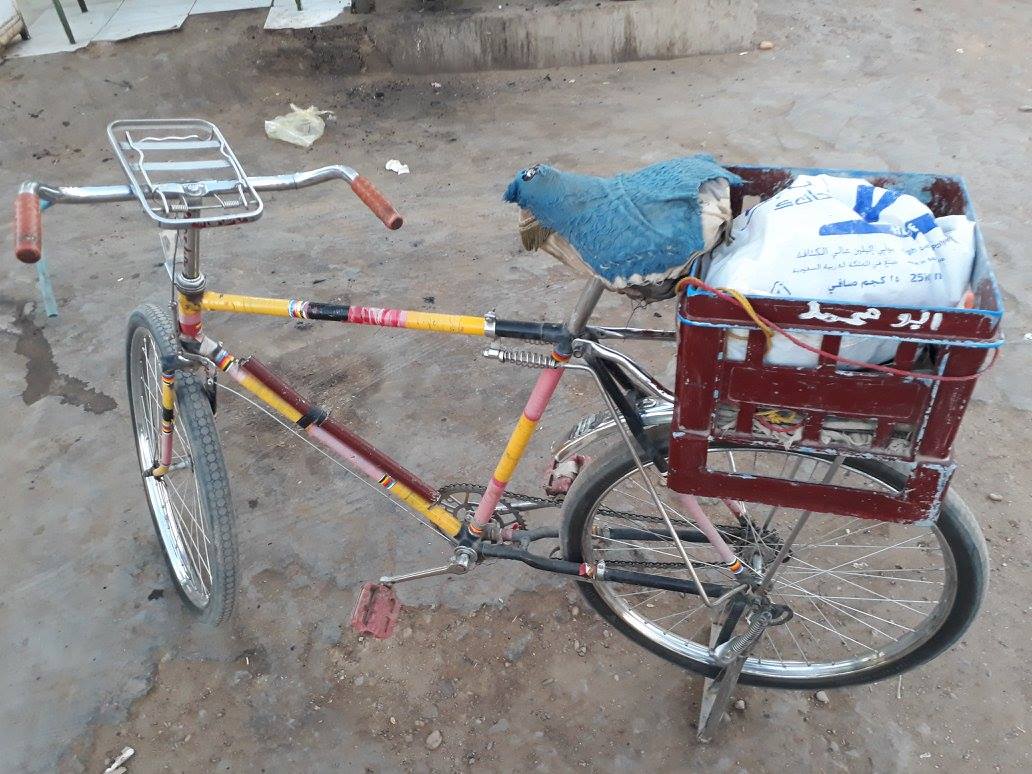
Fully equipped
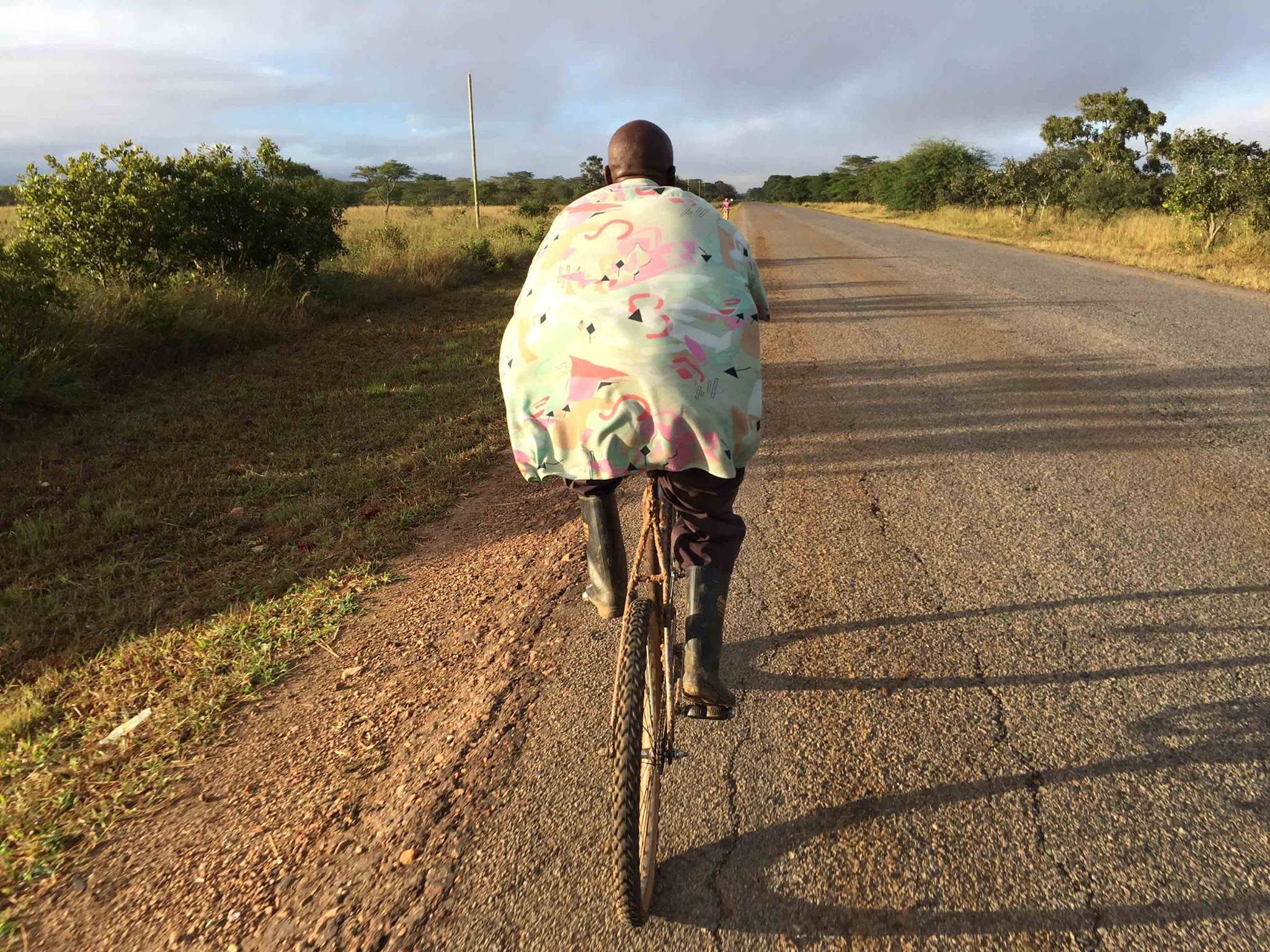
Spandex free
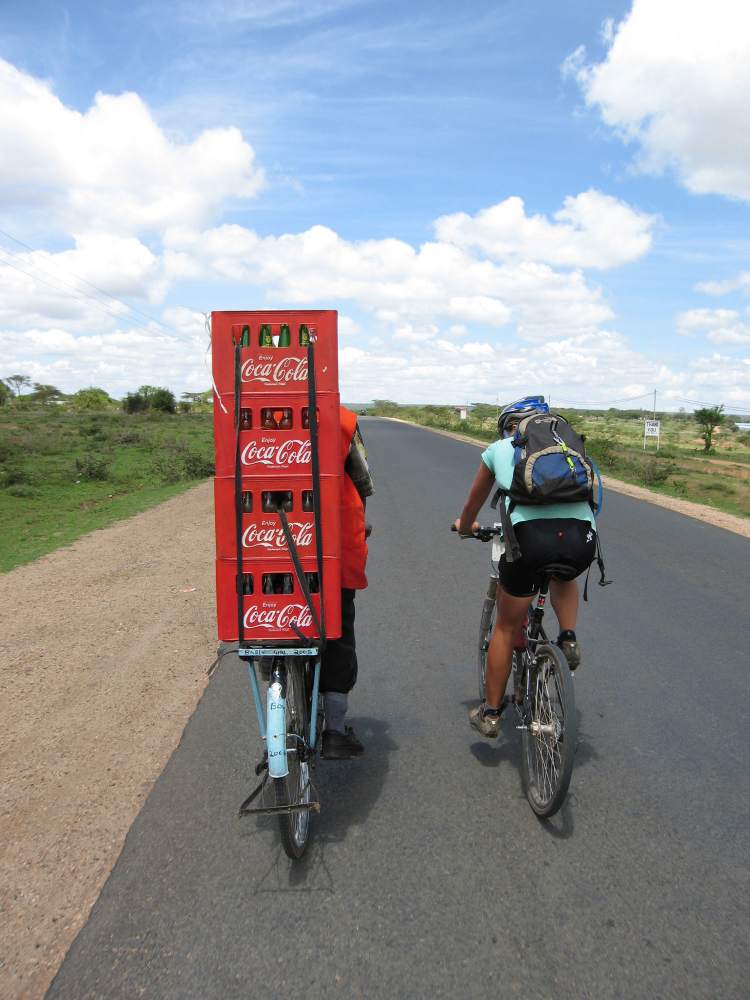
A tale of two bicycles
Mats Fredrix is the Content Creator on the 2023 Tour d’Afrique from Nairobi to Cape Town. He sends his second report from Lake Malawi .
“Vivid hues of green!” is the reply riders Patrick and Stephen give when asked what the first thing is that pops into their heads when they reflect on their time in Malawi. Before quickly adding, “water, rain and moisture.” It is quite the contrast to Kenya and Tanzania, never mind thinking back on Egypt and Sudan. This extreme change in climate and vegetation has one main cause: Lake Malawi. It’s the name you find on Google Maps, though it’s not entirely without debate, as you would expect when both Tanzania and Mozambique also border it. In Tanzania, the lake is called Lake Nyasa, as it was once called in colonial times, while the Mozambican name for it is Lago Niassa. Google has settled on Lake Malawi, to the great frustration of these nations. It is understandable as the lake plays such an integral part to Malawi, making up roughly a quarter of the whole country. Formed by the Great Rift Valley, the lake is the ninth largest in the world and the fourth deepest. On top of that, the lake is home to more species of indigenous fish than any other in the world.

It’s quite an impressive body of water to be cycling next to, as the Tour d’Afrique does for three full days. The riders also enjoy a rest day on the lake at the Chitimba Beach camp before turning inland and Malawi’s impressive “vivid hues of green”. As rider Bas said on the first riding day leaving the lake, “It was like we were cycling in Scandinavia! Never expected to see all those pine trees!”

Also closely associated with Malawi is Dr. David Livingstone according to Tour Leader Colleen during one of the chats we have every time we enter a new country. Though his influence is unmistakable all over these parts of Africa, Malawi really does bear his stamp more than any other. He was the first European to map out the lake and the country’s capital, Blantyre, is named after his birthplace in Scotland. It is also thanks to Livingstone that the lake received one of its more magical nicknames, ‘The Lake of Stars.’ That is what he called it after observing the lamps on the tiny fishing boats at night. Another, slightly more statistical, nickname for the lake is, ‘Calendar Lake’, due to its measurements. It’s 365 miles from top to bottom, 52 miles at its widest point, and 12 major rivers flow into it.

Colleen went on to explain the country’s bond with one of the world’s most famous explorers. His missionary work in Malawi is unmistakable. A 2012 study showed over 85% of the country’s 11 million people are Christian, so there’s a church or chapel in even the tiniest villages. One of the reasons he pledged himself to introducing Christianity into the area was to counteract and abolish the slave trade. In 1861 he came across the slave trade at its peak in Nkhotakota, where a Swahili-Arab slave trader called Jumbe was organizing expeditions to capture slaves and was sending them via slave routes, essentially death marches, to slave markets. Horrified by this, Livingstone managed to set up a treaty to end this practice. Although this agreement was short-lived, it is considered the basis for the complete abolishment of the slave trade in the area when it came under the British protectorate in 1891.

For one of the best views over the Lake Malawi, there is a hike up the Chombe Plateau, close to the town of Livingstonia, which one can reach by foot from the Chitimba Beach campsite. A 6-hour mountain hike isn’t exactly a recommended rest day activity for the Tour d’Afrique riders who by this time have learned to take the ‘rest’ in rest day quite literally. In any case, the view of the Chombe mountain plateau from the beach is quite impressive enough and with a staff vs. riders volleyball game planned, there’s a whole month of bragging rights on the line.
RELATED
TOUR

Tour d'Afrique
Our original trans-continental journey and flagship expedition crosses Africa from north to south, covering 10 countries in all. Beginning at the...
Mats Fredrix is the Content Creator on the 2023 Tour d’Afrique from Nairobi to Cape Town. He sends his first report from Arusha, Tanzania.
Arusha is a pretty famous place. For one thing, it sits at the base of Mount Meru, Tanzania’s second highest mountain. It also serves as a gateway for some of the country’s most popular safaris. To the west, lies Serengeti National Park, with its famous annual migration of wildebeest. Next to it is the equally renown Ngorongoro Crater. If all that isn’t quite enough, Mount Kilimanjaro, the continent’s highest peak, lies just 100 km north east. Fair to say, Arusha is used to getting a lot of attention.

The Tour d’Afrique takes a break for a triple rest day in Arusha, plenty time for something other than washing, drying and charging phones. Having had the pleasure of riding in Kilimanjaro’s shadow for almost two days, Africa’s highest peak was already a big check mark on everyone’s list. With only four days in the saddle after our lengthy break in Nairobi, most riders had plenty of energy and immediately headed out to check off more of Arusha’s big sights.
With all the natural highlights, the African Cultural Heritage Centre can feel like a supporting actor in the larger play that is Arusha. Unjustly so, however. Established in 1994, it was the first of its kind in Africa dedicated to exploring the rich treasures of Africa’s rich cultures. It is the largest privately owned collection of African Art on the continent and has acquired iconic status due, in part, to the unique structure of the buildings and the incredible treasure chest of African art it holds. At its helm is Managing Director, Saifuddin Khanbhai.

The Uhuru Peak of Mt Kilimanjaro serves as the inspiration for the design of the main building. The gallery space promoting local African artists was opened in 2010 and it is now the most extensive gallery of its kind in Africa. Its exterior resembles a drum, shield and spear: important symbols in traditional African culture. A spiral ramp at its heart flows through the interior, and encourages you to spin in and out of the staggering amount of masks, shields, spears and paintings.
With collections arranged into three areas – Wildlife, History and Soul – the space really encapsulates the true heart of Africa. The building celebrates the wonderful variety of wild animals in the country, focusing on the ones in the Serengeti, with much of artwork dedicated to the great migration of the wildebeest. It also features the largest piece of ebony in the world which took 14 years to carve out of a single piece of wood. As with so many of the artifacts, it depicts a scene drawn from Masai tradition.

If one needed another reason to visit, it is well-known for its unrivalled collection of the world’s finest Tanzanite stones, a gem which is only found in the Simanjiro District of the Manyara Region in Tanzania. As a result, it is approximately 1000 times more valuable than diamonds. The Centre promises to grow even more attractive in the future, planning to open a museum together with the famous primatologist and anthropologist, Jane Goodall, to showcase her life’s work.
RELATED
TOUR

Tour d'Afrique
Our original trans-continental journey and flagship expedition crosses Africa from north to south, covering 10 countries in all. Beginning at the...
]]>
Mats Fredrix brings us his first report from last week as riders gathered to re-start the Tour d’Afrique in Nairobi
As soon as you jump off the plane, you’ll hear it everywhere. It’s simple, clear and warm: ‘Karibu Kenya’ or Welcome to Kenya’. And the Tour d’Afrique has definitely felt welcomed ever since arriving. The caravan had to take a rather unusual break mid-tour, flying from Khartoum to Nairobi. On a TDA tour it’s strange not to see your surroundings flow naturally from one scenery into another. That’s probably what made the contrast between Sudan and Kenya even more mind-blowing. Rider Craig, 78 and the oldest rider on the tour, said, “we came from some pretty austere sand dunes straight into a lush oasis, I’m really looking forward to getting the sand out of my shorts,” while enjoying some laid-back time at the Wildebeest camp, the rendezvous point for the big re-start. The vehicles had to make the passage overland, so it was like someone pressed the pause button on the tour for a bit.

Though this new face of Africa was begging to be explored, so the riders took the opportunity and spread out across the country like an eager flock of guinea fowls. Many took the chance to go on a safari in the Masai Mara National Reserve, “I saw so many animals, you’d be better of asking me which ones I didn’t see,” said rider Coco from Spain. “I saw four out of the big five, and all in one day,” said Josie, “it was pretty eye-opening stuff”. Though for a safari you didn’t even have to take a trip that far south, just a few kilometers from the campsite, all of Kenya’s wildlife is also on show. The Nairobi National Park has the added twist of getting a glimpse of the animals against a starkly contrasting city backdrop. It is the only National Park in the world that is that close to a city.
Some others, on the hunt for some sand between their toes, took a train all the way to Mombasa, and spend some sun-lit days peering at over the ocean. “But enough is enough,” said rider Craig, “I am ready to go, I am eager to get on my bike again.” And that’s certainly the feeling around camp on the eve of the big re-start. It’s been ten days since their rears have touched their bike saddles, quite long for a bunch of biking fanatics looking to make their way all the way down to Cape Town. Tour Leader Colleen feels this is where the tour is really kick-started. She is, of course, kind of biased. A South-African native, she has been leading tours in this part of Africa for over ten years and she’s very eager to show it off to the riders. “Now the real adventure starts, now the dirt roads start, and the camping really gets into another gear,” she said.

It was a beautiful mix of fresh faces and riders and staff who had been on the road all the way from Cairo convened for the riders’ meeting on the eve of the re-start. The air was full of excitement, and tasted a little bit like a reunion already. The main takeaway, and it’s a big one: ‘LEFT IS THE NEW RIGHT’, as all the way down to Cape Town the riders will be sticking to the left side of the road. Day 19 of riding on the tour is no easy joyride though. 140.7 km will bring the pack from the bustling and traffic laden streets of Nairobi to a bush camp near Mashuru. With a couple of sections dubbed ‘unrideable’ and some ‘please guys, walk!’ warnings from Colleen still ringing in their ears, everyone went to their tents.
RELATED
TOUR

Tour d'Afrique
Our original trans-continental journey and flagship expedition crosses Africa from north to south, covering 10 countries in all. Beginning at the...
Ethan Weil, content creator for the first part of the Tour d’Afrique, shares this post before he flies home from Khartoum (Mats Fredrix is now in Nairobi and will be posting photos and words for the rest of the tour as it winds its way down to Cape Town).
Starting from the northern tip of Sudan after crossing the border, the flat paved roads take you through a beautiful Nubian desert between pockets of mountainous dunes blanketed by black rocks. It’s a peculiar place with a changing landscape to let the eyes wander.
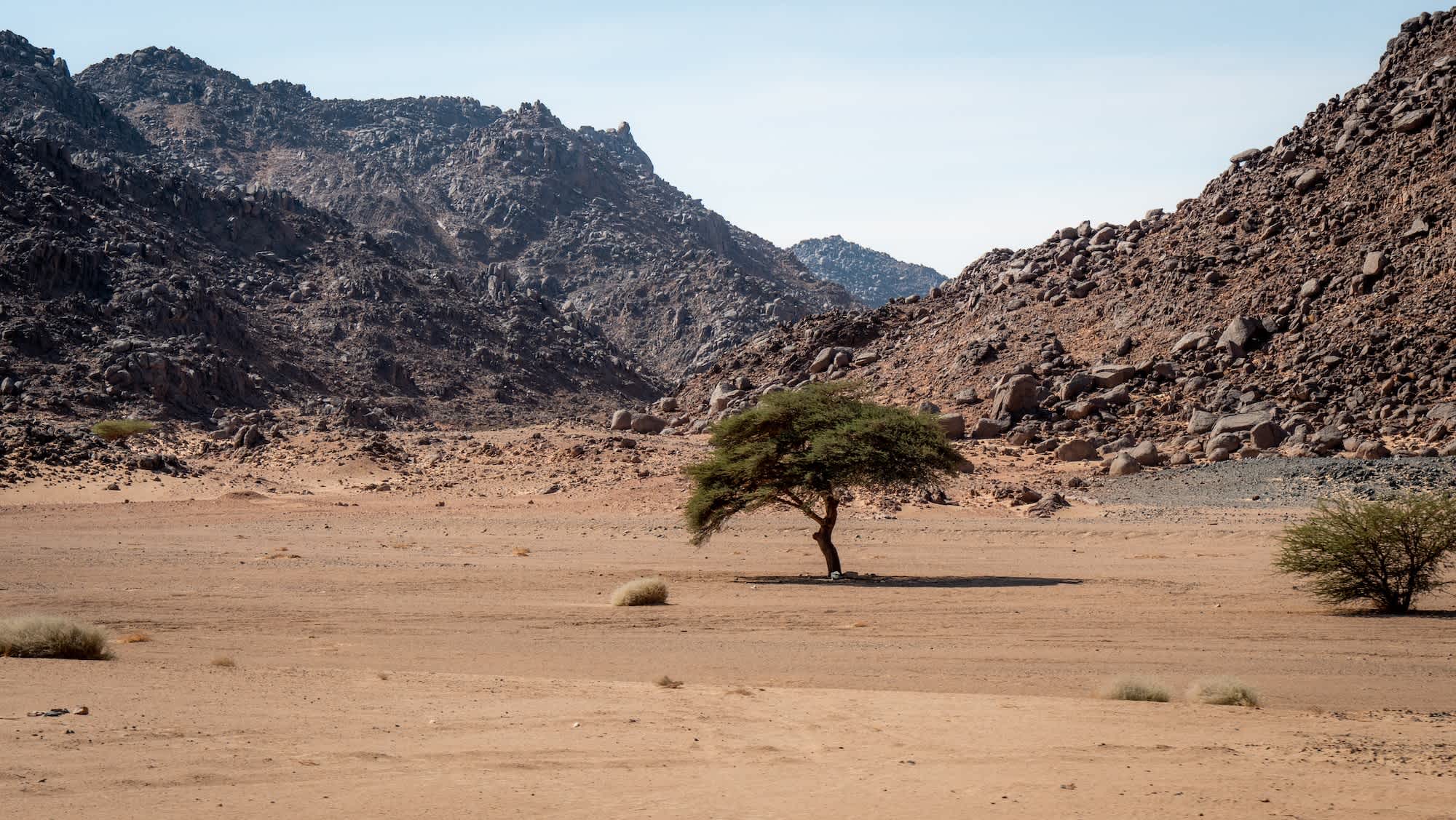
Sudan has many different kinds of rocks and minerals throughout the country with an interest between locals and foreigners alike to explore mining deposits of those resources. What’s mostly being mined are petroleum resources for fuel but Sudan is also in the top 10 countries for gold mining. Riders can expect to cycle through small mining villages and operations along with meeting local or foreign gold seekers. While visiting one of the villages for a coke stop some of the riders, Emily, Jan, and Sharon got a photo with almost the whole village!
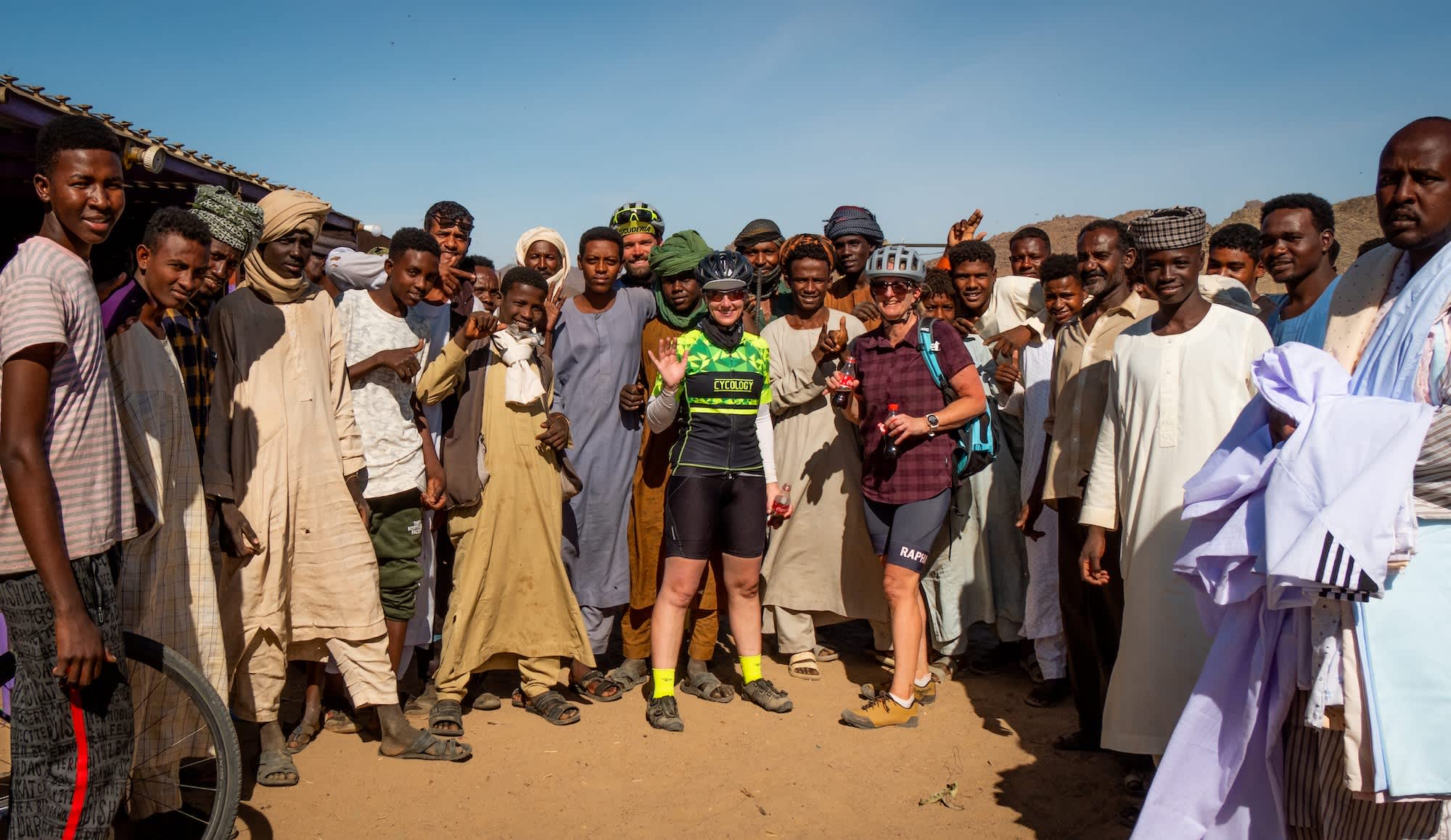
The first camp we head to is Wadi Halfa. It’s just us out in the desert and at night it’s a great spot to see the stars. Wadi Halfa is an area that is known to be one of the hottest places on Earth. Luckily for us the temperatures are more reasonable in the winter, but at night it can get quite cold too.
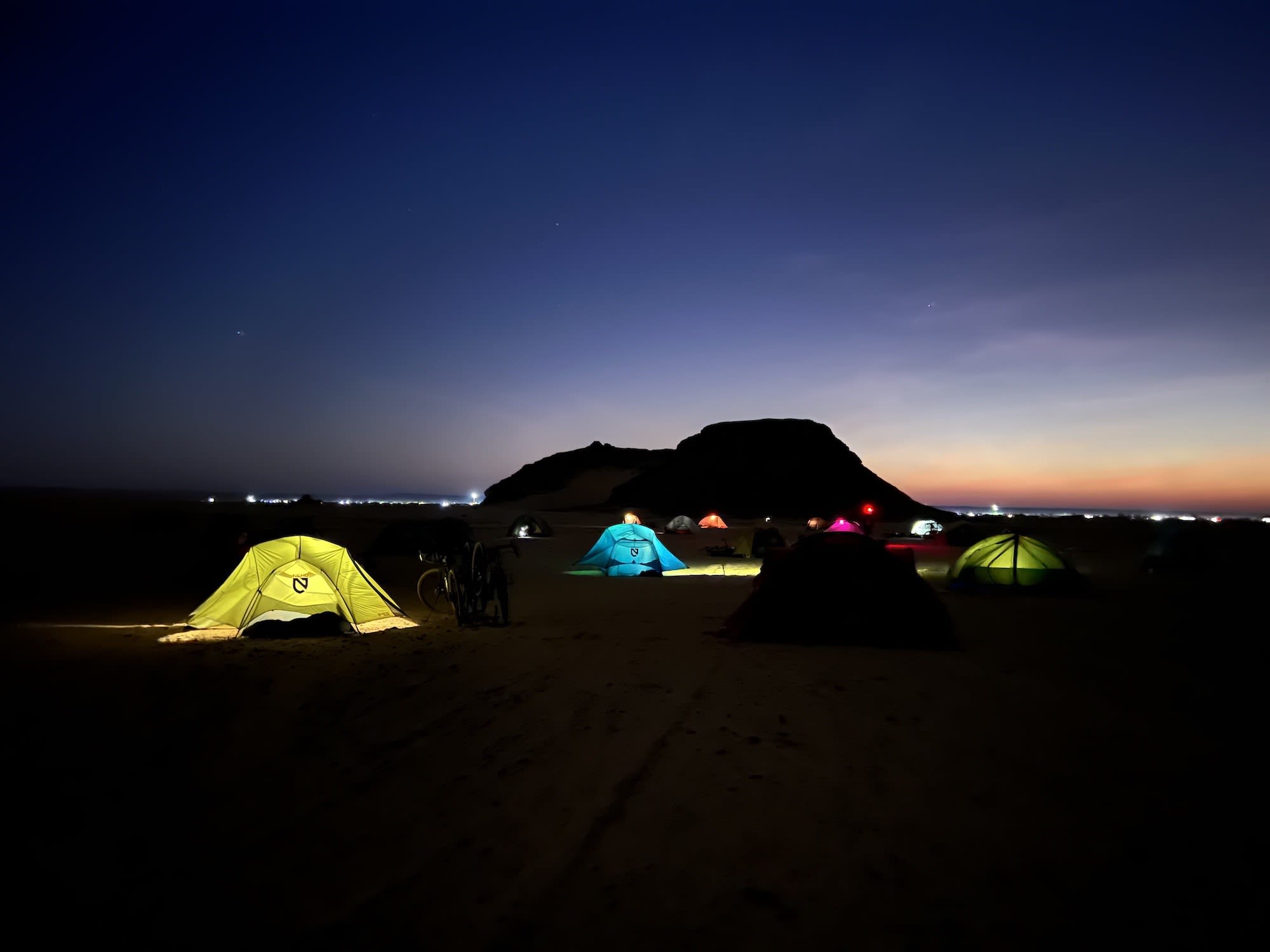
One thing to watch out for is what I call the ‘desert stampede’, which is a caravan of tour buses that fly down the small roads at high speeds. They come by in a group in the mornings and late afternoons as they start their day. Riders particularly need to be cautious when they come through. One rider on our tour, Bernd, captured a great image of fellow riders Peter and Vlademir that depicts the reality of the buses passing by.
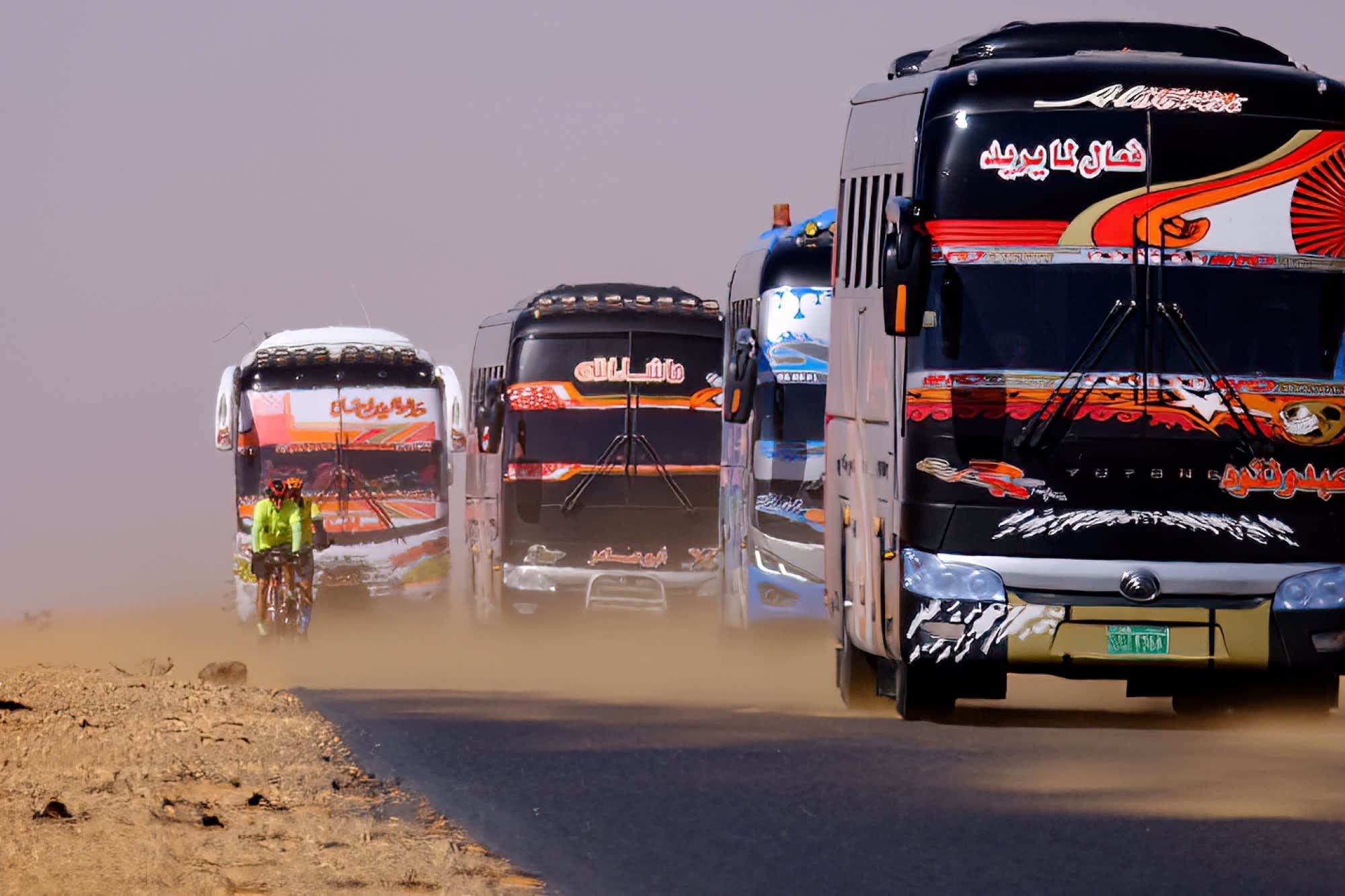
As for animals to see while riding, there’s a high chance of seeing camels, both wild and not, as well as donkeys! Camels roam the desert and eat off the native Acacia trees that are scattered across the desert!
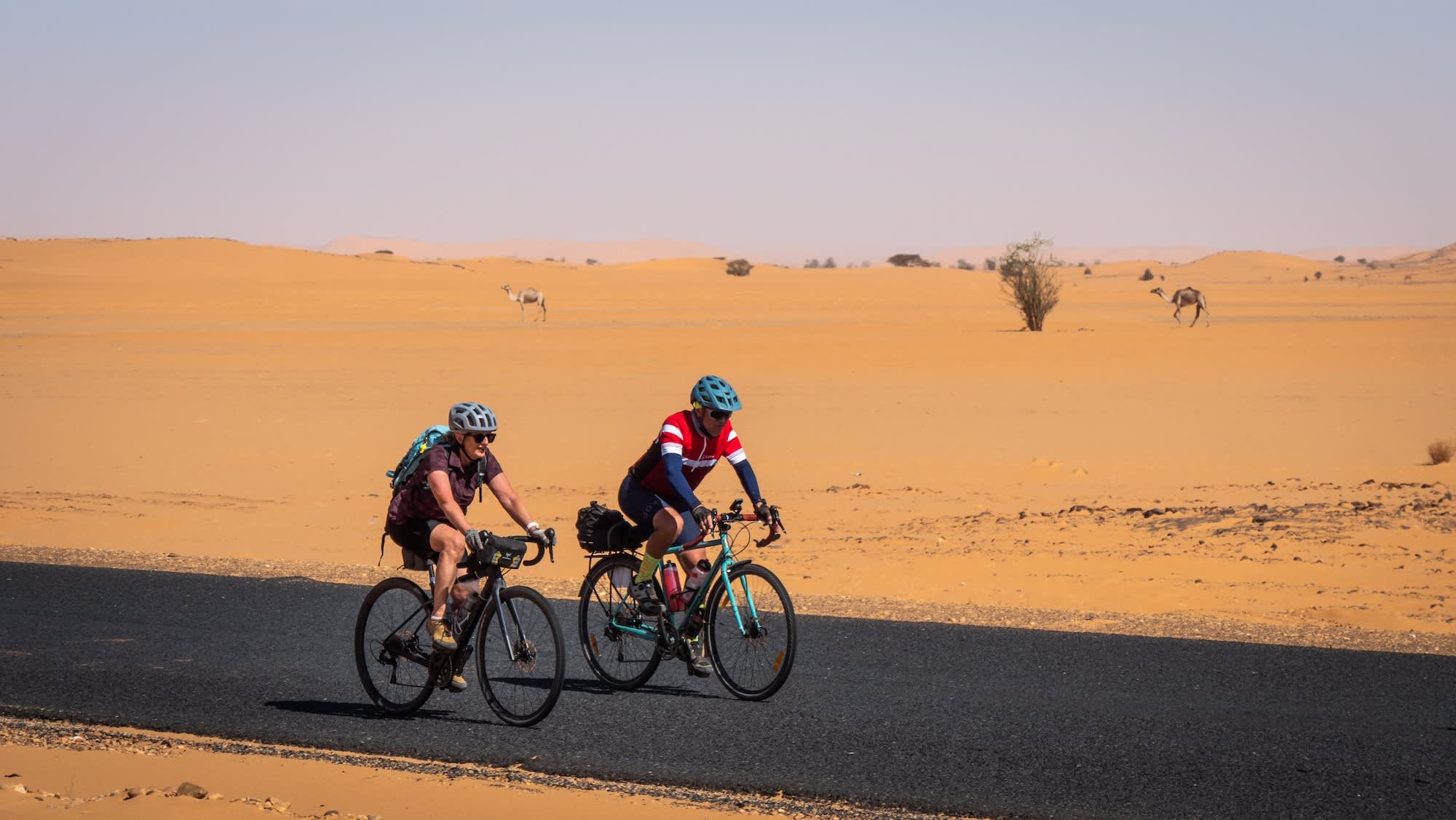
Sometimes if you’re lucky you’ll come across a Bedouin riding a camel as he navigates the desert. We met this guy who came by as we were packing the lunch truck!
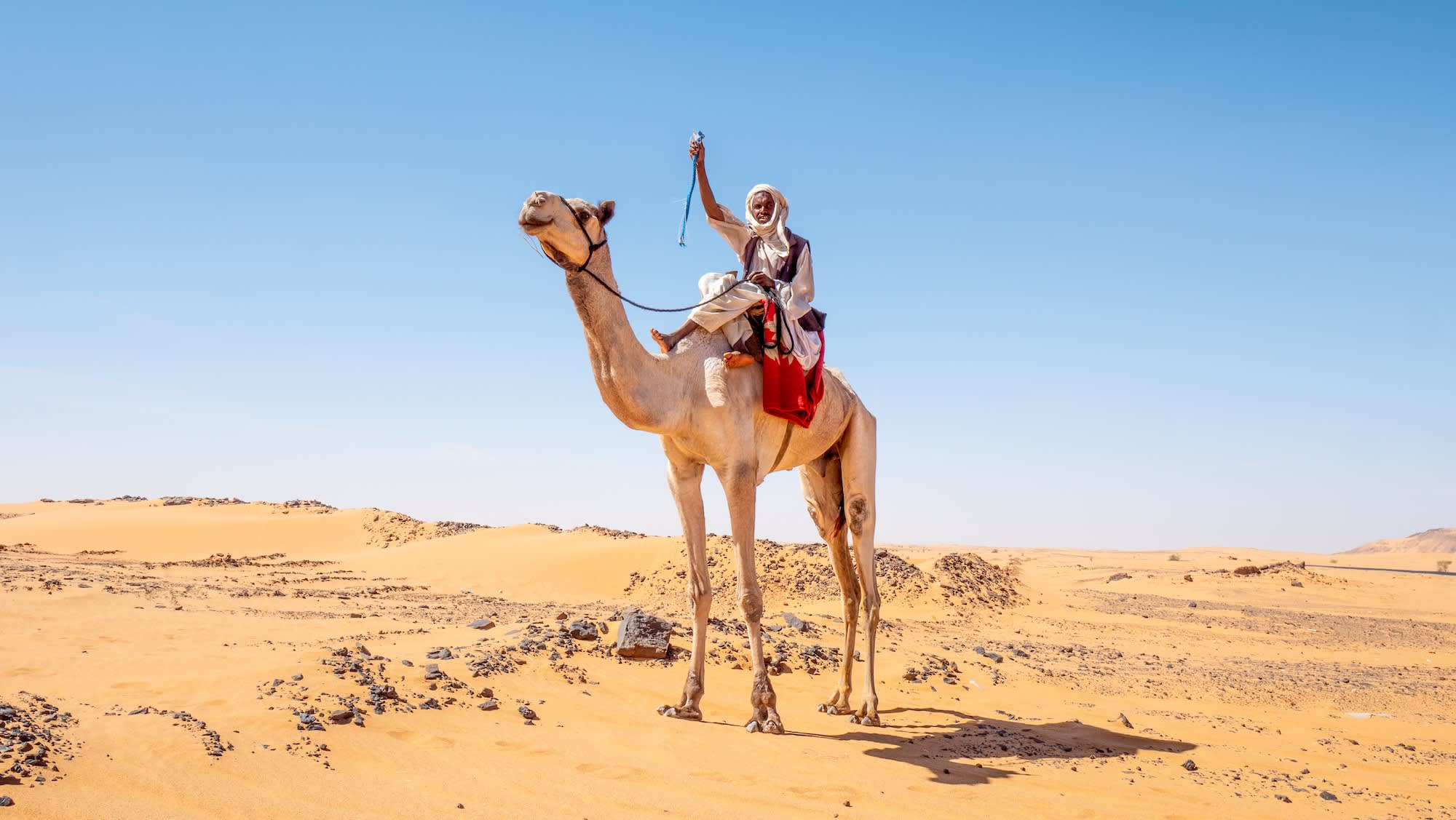
Like anything there are positives and negatives but all in all Sudan is full of natural beauty as well as rich history that is still very much unknown to the western world. The cuisine is good, especially the Sudanese bread and falafels. The people are friendly, and curious to learn more about you. The history is interesting, from Nubian Pyramids to the relations between the Egyptian and Nubian Societies, there’s a lot to learn about the culture and history of Sudan.
RELATED
TOUR

Tour d'Afrique
Our original trans-continental journey and flagship expedition crosses Africa from north to south, covering 10 countries in all. Beginning at the...
Ethan Weil is the content creator for the Cairo to Khartoum section of the 2023 Tour d’Afrique. He sends his second report from the shores of Lake Nasser.
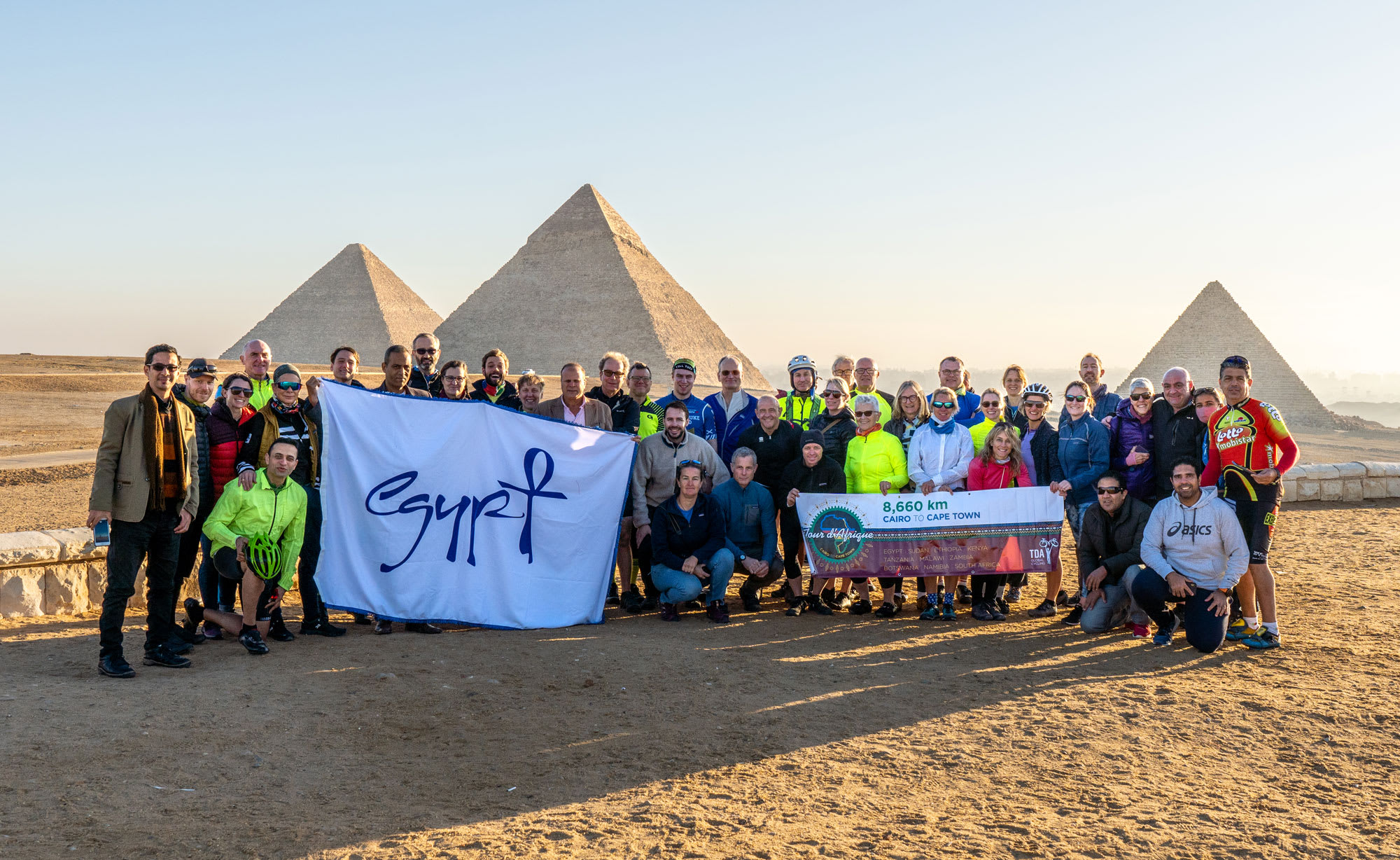
Group Photo of the 2023 Tour d’Afrique at the Great Pyramids of Giza
From the early morning call to prayer to the hustle and bustle of Cairo’s city streets, it is an organized chaos of traffic and car horns that somehow works within a dense city. Full of rich, ancient history, Cairo’s cityscape is highlighted by the Great Pyramids of Giza as a backdrop while one wanders the streets full of food carts, markets and shops. These are just a glimpse of the things you’ll notice when you first land and prepare for your tour from Cairo to Cape Town. The riders are currently gearing up to take the ferry across Lake Nasser in order to enter Sudan so I thought I would try to describe what the experience is like to cycle the length of Egypt in 2023.
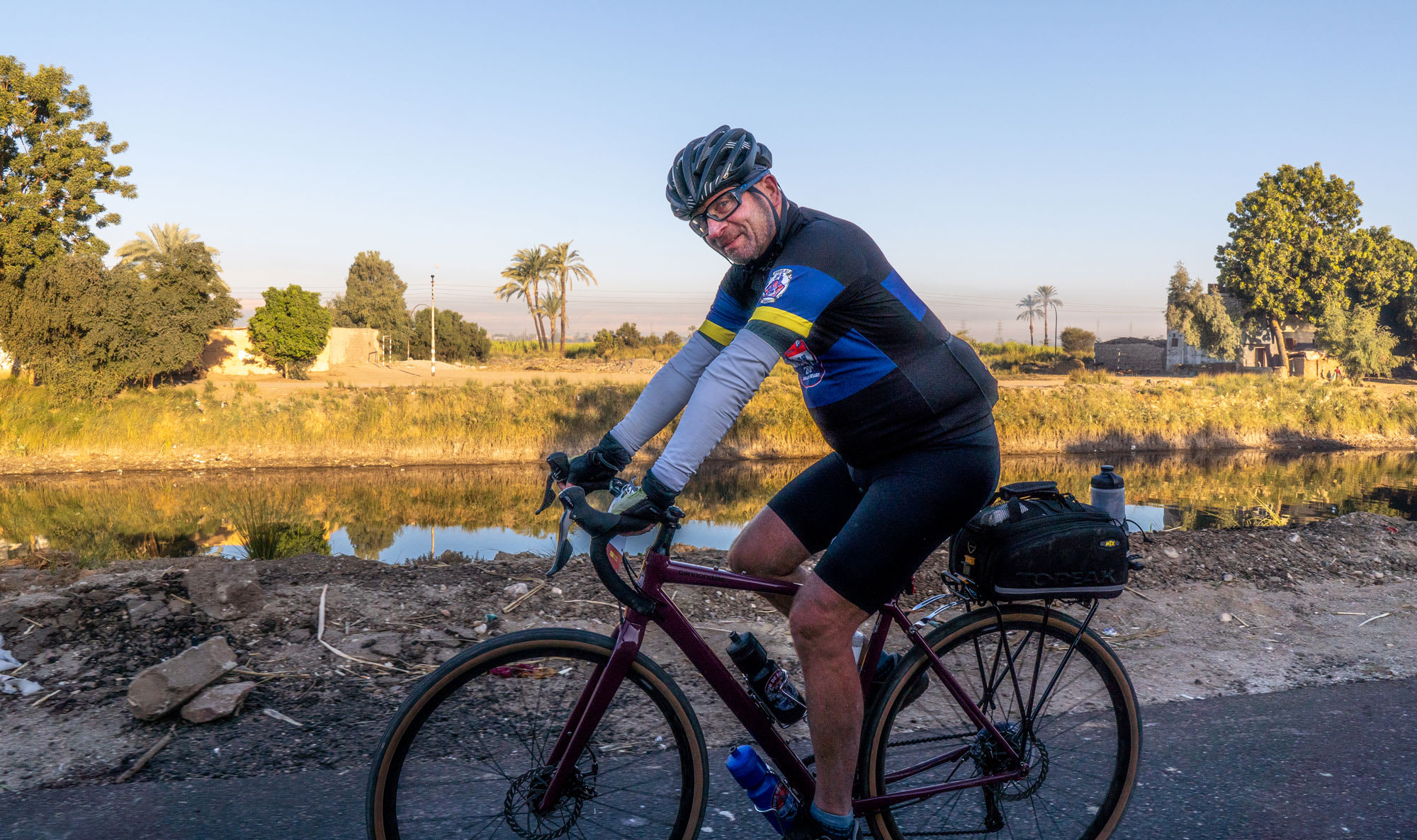
Yosef smiles at the camera while riding through villages from Luxor
Most of our riders on this year’s Tour d’Afrique brought either gravel or touring bikes, a mix of custom built and brands like Trek, Canyon, Cannondale, Kona, Specialized and more. These bikes tackled the roads of Egypt with minimal difficulty but there were some flats along the way. These were quickly sorted out, ensuring the riders could continue their ride. The route through Egypt took us along some great smooth-riding roads to some rough patches of pavement intermixed with sand and dirt. Speed bumps, humps, strips and dips are also something that riders must be on the lookout for, especially while biking at speed, as some may be hidden or not clearly labeled . Some other cautionary tips while riding in Egypt are more relevant to cities and villages where a little donkey, motorbike, dog or kid could step in front of your path and take you by surprise. It’s best to go with the flow of the traffic, cycle in groups when necessary and be alert to your surroundings.
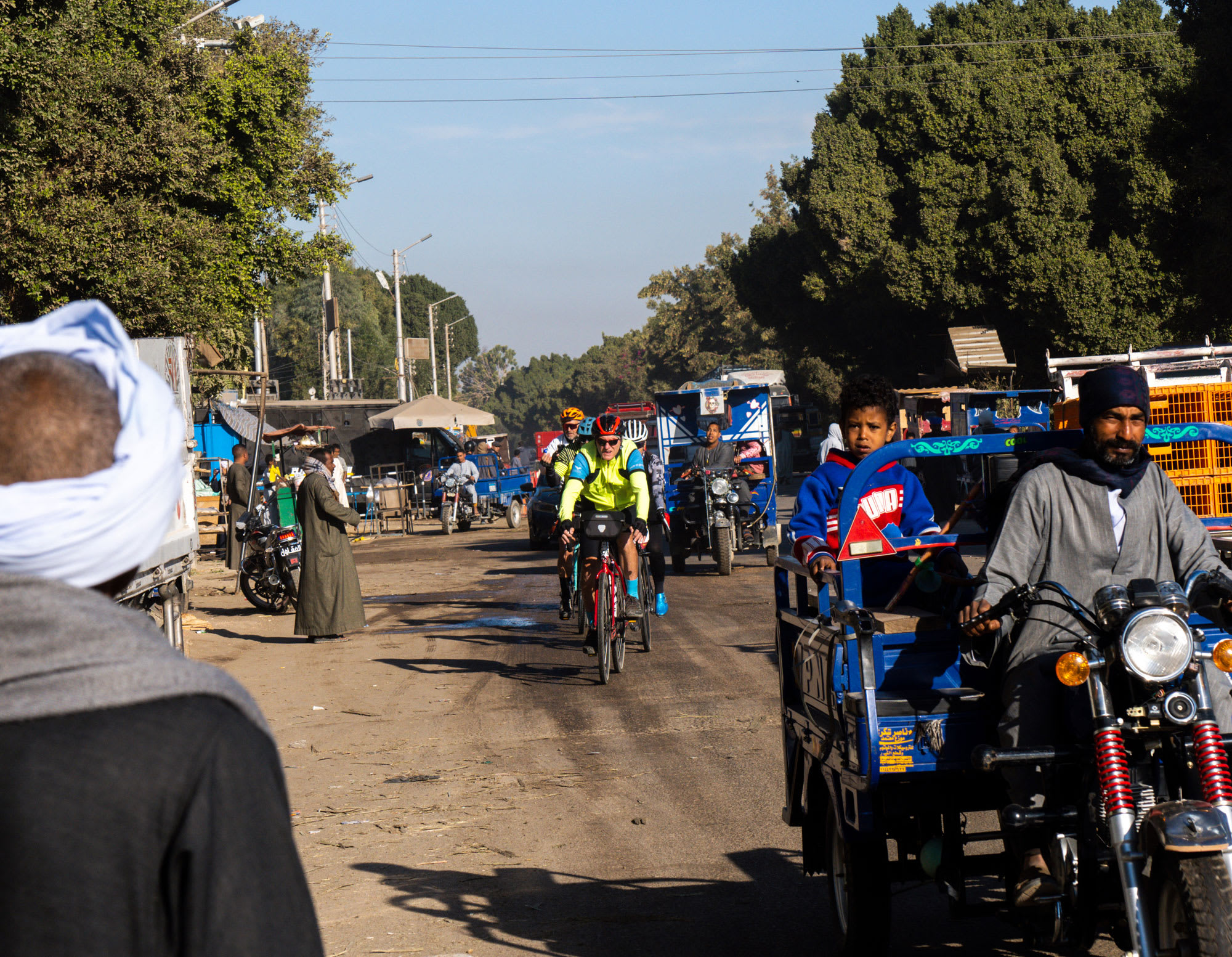
Peter navigating the busy streets of Villages along the Nile in route from Idfu to Aswan
There is great cycling to be had and some amazing views along the way; the Great Pyramids of Giza, riding along the coast of the Red Sea, navigating the Red Sea Mountains, exploring the Valley of the Kings and the Luxor Temple Ruins, cruising downhill next to the Nile, enjoying the charm of coastal towns and Nile villages on our way towards the Egyptian border with Sudan. The riders shared the love of coke stops, often getting tea, coffee, coke and falafels as they pedalled through Egypt. We now prepare to enter Sudan, thus setting off on the next part of our journey in a new country! Thanks Egypt for a great experience!
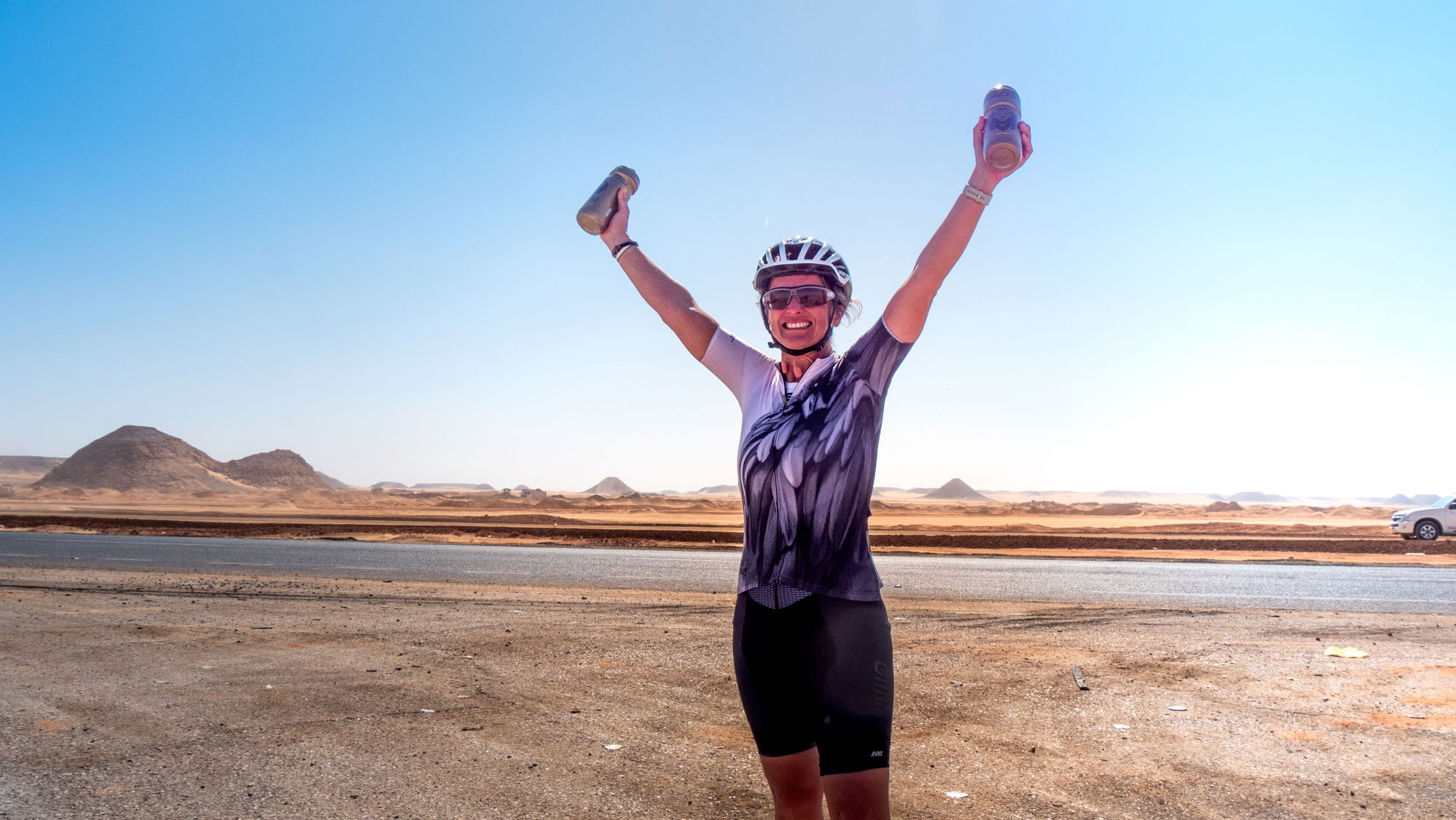
Excited to have completed another morning of riding on the first century ride of the Tour
RELATED
TOUR

Tour d'Afrique
Our original trans-continental journey and flagship expedition crosses Africa from north to south, covering 10 countries in all. Beginning at the...
Ethan Weil is the content creator for the Cairo to Khartoum section of the 2023 Tour d’Afrique. He sends his first report from Luxor, Egypt.

The Red Sea Mountains
“The best ride of my life, and I’ve done some rides!” Craig, our oldest rider on the tour, had been ecstatic with the ride on day five. With a big smile on his face he rode through the Red Sea Mountains. The route started in the beautiful coastal town of Safaga, then threaded through the mountains on the way to our desert coke stop camp.

Craig smiling
Craig wasn’t the only one either as many riders rode into lunch with faces of joy due to great road conditions, a tailwind, beautiful scenery and a nice downhill after the first hill climb of the tour. Many cyclists, like Craig, have been preparing and training for months ahead of this journey from Cairo to Cape Town and each have unique stories on how long they’ve been cycling, why they cycle, and what got them to join the tour. One cyclist in particular, who happens to be one of our guest riders from Egypt, tells his story about why he cycles.

Ashraf
After coming in for lunch from a long ride in the desert, Ashraf came up to me and we talked about how the ride was going which led to me asking why he enjoys cycling along with what got him into it? He responded that, “Cycling as a sport in Egypt is not as big as it is in Europe and when I ride, I have other Egyptians ask me why I do it or why do I ride with a tour, I ride for health and for happiness. Cycling keeps me healthy and makes me very happy.” His love for cycling is easily seen as he talks about it. I connected with him and his answer as it’s also why I ride. We talked about how cycling is also a great way to see things you wouldn’t otherwise see by car, as it doesn’t have such a constrained view.
Riding a bike is a slow enough speed to take in the senses and scenery around you but it also a great form of transportation. Ashraf’s love for cycling runs in the family. When I asked why he cycles with the tour in his home country of Egypt he said, “My son also cycles and is ranked number two in Egypt, He is 16 and TDA Global Cycling doesn’t allow anyone to join the tour until they are 18 years old. When he turns 18 I plan to cycle from Cairo to Cape Town with him on the Tour d’Afrique.” I loved how he not only cycles for fitness and enjoyment but also to create a strong bond with his son. He even told me that he let his son know when the tour was driving out of Cairo so his son could cycle alongside our vehicles.

Ashraf’s son racing the tour vehicles outside Cairo
The bond Ashraf has with his son over cycling resonates with me as it was my own father who got me into cycling too. I have fond memories of him nudging me to get some exercise and join him on a ride to enjoy the outdoors. Cycling brings happiness that can be shared between generations, thus creating a cycle of happiness.
RELATED
TOUR

Tour d'Afrique
Our original trans-continental journey and flagship expedition crosses Africa from north to south, covering 10 countries in all. Beginning at the...
]]>
Tate Drucker was the Content Creator on the 2022 Tour d’Afrique. In this report, she takes a look back at the end of this year’s expedition.
On one side of the TDA truck, heavy storm clouds rolling towards us from the horizon. On the other side of the TDA truck, the distant, warm glow of city lights – the lights of Gqeberha.
Throughout the Tour d’Afrique, the end of certain stretches of the trip have been marked by the arrival of sights specific to that chapter of the expedition. In Botswana, a distant baobab tree poking its head above a sea of thorny acacia trees guided cyclists toward it, as they would soon camp under its overarching branches that night. In Namibia, small swatches of sand slowly appear alongside the road, eventually giving way to deep, red oceans of sand dunes, looking like mirages spread across the arid landscape. In South Africa, it was Table Mountain, the quintessential silhouette of the Western Cape appearing on the horizon and guiding the cyclists towards the Mother City.

Normally, the Tour d’Afrique ends on the white-sand shores of Cape Town but this year the cyclists had an additional stretch to conquer. For the first time ever, the expedition carried on from Cape Town and headed east along the spine of the mountains of the Karoo, eventually leading the cyclists to the Garden Route.
 South Africa’s Garden Route is a 300 kilometre stretch of wild coastline, known for its dense rainforests, rocky beaches hugging jagged cliffs, sleepy, small towns boasting charming ma-and-pa shops and blue mountains poking their peaks out from the thick blankets of fog that roll off the ocean. Most notably though, are the dazzling blankets of wildflowers that cover the rolling hills.
South Africa’s Garden Route is a 300 kilometre stretch of wild coastline, known for its dense rainforests, rocky beaches hugging jagged cliffs, sleepy, small towns boasting charming ma-and-pa shops and blue mountains poking their peaks out from the thick blankets of fog that roll off the ocean. Most notably though, are the dazzling blankets of wildflowers that cover the rolling hills.
These bright wildflowers and unique plants are called “fynbos” (meaning “fine bush” in Afrikaans). The flora that qualifies as fynbos is found only in this area of the world, and is known for is exceptional biodiversity. Fields of pink heather-like shrubs, pockets of blooming proteas, and twisting, neon-green vines have made this part of the world known as the Cape Floral Kingdom, and is how the Garden Route got its apt name. This breathtakingly beautiful, postcard-ready landscape is disturbed only by the snaking roads the Tour d’Afrique cyclists have been pedalling along; stopping to pump air into their tires or have a roadside peanut butter sandwich amongst one of the world’s most fragile and unique ecosystems.
As the traffic began to pick up and the end of the expedition grew closer and closer, the riders arrived at Jeffrey’s Bay — their final night all together while on the road. While waves rich in bioluminescence broke on the shore just past the campground, the cyclists and crew all sat together to share their final remarks on the trip; swapping stories, snacks and Tour d’Afrique jerseys. Meanwhile behind them all, those heavy rainclouds sat in the distance, reminding the riders that their final day on the road would be as windy and drenched as their first day leaving Livingstone was, almost two months ago (Most cyclists found this funny, seeing, the tour as coming full circle). And on the other stretch of horizon, sat the warm, dulled lights of the now- not-so-faraway city they’d been peddling towards for 4,655 kilometres.

Arriving in Gqeberha and crossing the finish line was a surreal experience for many of the cyclists. After seven weeks of being glued at the hip with other people who all shared the the same goal of making it there on two wheels from Victoria Falls, ending the expedition felt both like an exceptional accomplishment and incredibly bittersweet. They arrived at this city, a monumental, enormous achievement, but for now, there are no more sights on the horizon to pedal towards anymore.
For many of the cyclists, however, this is only the beginning. Some now want to cycle all the way around the world. Some still want to complete the whole Tour d’Afrique, taking on places like Egypt and Ethiopia. Some are taking some time out of the saddle, while some are already itching for the next adventure. All are in agreement, though, to keep peddling on, wherever they end up next in the world.
RELATED
TOUR

Tour d'Afrique
Our original trans-continental journey and flagship expedition crosses Africa from north to south, covering 10 countries in all. Beginning at the...
Tate Drucker was the Content Creator on the 2022 Tour d’Afrique. Here she looks back on one of the quirkier stops on this year’s tour.
Brilliantly orange sheer cliffs flank the edges of a winding road, guiding the cyclists of the Tour d’Afrique through deep, scenic gorges that cut through the landscape like scars. Red mountains painted with lime green lichen, small streams glinting in the morning sunlight, and twisting, curved rocks which tell the story of a landscape that abruptly changed and shifted over the course of millions of years has been the backdrop for this stretch of the trip.

As the riders moved inland from the coast and into the Karoo — a semi-desert region in the Western Cape of South Africa — the towns they passed through mirrored the history-steeped landscape that envelopes them. There’s the sense that every passing place has a story, and a foregone history attached.
After three days of cycling up steep mountain passes and down spiralling switchbacks, the cyclists landed in Oudtshoorn for a rest day — an unassuming, sprawling town sitting in the centre of the windswept Karoo. It doesn’t take visitors too long to realize what makes Oudtshoorn so unique: there’s something that almost every storefront, every restaurant, every shop, and every guesthouse has in common. There’s always — always — a mention of ostriches.

Oudtshoorn is known as the ‘Ostrich capital of the world’. Ostrich farms flank the edges of the highway as one approaches this Karoo town, with its famous giant, whimsical birds craning their necks towards the cyclists pedalling past. But why did a small town in the desert become the world’s epicentre for these gangly creatures?
In the 1800s, ostrich feathers were seen as high fashion by Europeans, and the demand for their feathers in Britain was skyrocketing. The extremely arid, hot, and dry climate of Oudtshoorn — which already existed as a town under South African British rule — made it the perfect location to establish ostrich farms and feed the demand of the European market. Ostrich farming became so lucrative and successful that many farmers around Oudtshoorn tore up their agricultural fields in order to rear birds instead.
Although the demand for ostrich feathers has decreased dramatically over the years, Oudtshoorn has carried on the tradition of ostrich farming. Ostrich meat is considered to be some of the leanest meat available and their skins are often used in lieu of traditional cow leather. Multicoloured ostrich-leather purses, bags, and belts line storefronts along Oudtshoorn’s main touristic street. For curious visitors, there are countless ostrich farms around the town that offer activities such as ostrich safaris, ostrich meat tastings, ostrich hatchery visits and even ostrich riding.

The fact that Oudtshoorn has taken advantage of its ostrich reputation is evident: images of ostriches are plastered all over the town and almost every single restaurant and gift shop offers a selection of ostrich steaks, biltong, droëwors, or even ostrich-shaped candy.

The long, wide avenues of the town also reflect the riches of its ostrich-centric past. The opulent homes of feather salesmen and farmers built in the 1800’s still sit on the street corners behind wrought iron gates and manicured gardens. Whether or not visitors agree with the ethics of a town founded on the farming and rearing of South Africa’s iconic bird, its influence and significance in the Karoo is difficult to ignore.
So, a piece of ostrich biltong, anyone? When in Oudtshoorn…
RELATED
TOUR

Tour d'Afrique
Our original trans-continental journey and flagship expedition crosses Africa from north to south, covering 10 countries in all. Beginning at the...
Tate Drucker is the Content Creator on the 2022 Tour d’Afrique. Her fourth post comes to us from the Atlantic Coast of South Africa. Be sure to follow their progress on Instagram.
There it is on the horizon: a thin veil of blue. After cycling through Namibia for two weeks, the riders on the Tour d’Afrique have traded oceans of sand and gravel for the immense blue waters of the Atlantic Ocean. The arrival at the coast, however, didn’t come without the riders first being challenged. Long days on the Northern Cape’s busy roads, relentless climbs, and occasional clouds of desert flies and locusts greeted the riders, day in and day out, but the promise of peddling towards the Atlantic pushed them on. After careening over the hill where the ocean came into view for the first time, many of the riders remarked on how cathartic it was to see the ocean.

As the riders arrived one by one into Strandfontein — the first beach campsite of the trip — they were greeted by all the normal sights of a TDA camp: the Tour d’Afrique truck with its sprawling canopy outstretched, early- arriving riders washing their bikes or setting up their tents, staff chopping mushrooms and dicing onions for dinner. But this time, the backdrop of what has become so familiar to them was what made this day different: brilliantly blue crashing waves, wild ocean swell, dolphins surfing the breakers as they chased schools of fish, and misty cliffside bluffs. Laughter seemed to ring through camp more than usual, and riders jumped into the sea — some still in their lycra and cycling gloves. It was as if everyone on the trip collectively exhaled, as if something celebratory was taking place. As if this was any different from any other day.
 Studies have shown that there may actually be a scientific reason behind why our moods change so dramatically when we reach the sea. Negative ions — a small molecule naturally occurring in nature — are found in extremely high quantities near the ocean. These ions pass through our bodies mostly through the air we breathe; so the more you inhale and exhale while next to the ocean, the more ions enter your lungs and bloodstream. Negative ions are created by atoms breaking apart, which happens through natural occurrences that involve some kind of turbulence; such as in rainstorms or in strong gusts of wind. However, studies have found that at the ocean in particular, there is an average of 2000 negative ions per cubic centimetre. This is as opposed to a crowded city, which has an average of less than 100. In fact, a recent study published in the Journal of Alternative Complementary Medicine suggests that negative ion therapy could be used to treat symptoms of depression and anxiety.
Studies have shown that there may actually be a scientific reason behind why our moods change so dramatically when we reach the sea. Negative ions — a small molecule naturally occurring in nature — are found in extremely high quantities near the ocean. These ions pass through our bodies mostly through the air we breathe; so the more you inhale and exhale while next to the ocean, the more ions enter your lungs and bloodstream. Negative ions are created by atoms breaking apart, which happens through natural occurrences that involve some kind of turbulence; such as in rainstorms or in strong gusts of wind. However, studies have found that at the ocean in particular, there is an average of 2000 negative ions per cubic centimetre. This is as opposed to a crowded city, which has an average of less than 100. In fact, a recent study published in the Journal of Alternative Complementary Medicine suggests that negative ion therapy could be used to treat symptoms of depression and anxiety.
The benefits of being by the ocean may be undeniable. But what does this mean exactly, and how does it benefit riders as they cycle past beach towns and along oceanside roads? Negative ions directly impact the serotonin levels in our brains, creating an overall feeling of wellbeing and calmness. For some riders, the shift was so significant that many of them often remarked how they were feeling more positive and excited for the day than usual. There were still long days, still headwinds, still stretches of relentless corrugation. The only thing that had changed was the stretch of blue and the white noise of waves constantly in the background. Turns out that cycling on the winding roads that hug South Africa’s coastline may just be healthier and better for us than we realize.
RELATED
TOUR
Tate Drucker is the Content Creator on the 2022 Tour d’Afrique. Her third post comes to us from beautiful Namibia. Be sure to follow their progress on Instagram.
An old VW Beetle left to disintegrate on the side of the road, rusted and burnt-orange against the dusty landscape. A sign creaking as it sways in the hot breeze, advertising homemade apple strudel made from a decades-old family recipe. A passing desert outpost town where both German and Afrikaans are spoken by the locals; all of whom seem to have either settled in Namibia in pursuit of its wide empty spaces, or have roots in this sunburnt country dating back hundreds of years.

These relics of times-past dot the Namibian landscape, and have caught the attention of the 2022 Tour d’Afrique riders as they pedalled 1,355 km through the country. The vastness and consequent strangeness of Namibia has been palpable, and oftentimes difficult to ignore. As the riders left Botswana, the narrow stretches of road flanked by tall Kalahari grass gave way to spectacular expanses of landscape which are both beautiful and harsh at the same time. While riders got a brief taste of modern Namibian life in Windhoek — even though most them were busy with tasks such as changing their tires to prepare for the sand and gravel ahead, restocking bug spray and sunscreen, or touring some of Windhoek’s humble museums and quiet parks — the majority of the route has been through Namibia’s remote interior.

The beginning and end of each blisteringly sunny day has been flanked by campsites that often appear on the horizon like a mirage, slowly creeping into view. With each passing place, and with each casual conversation with a campsite manager who has their own history to tell and apple pie to offer, more and more of the riders have come to question how these people ended up living out in the desert in one of the most sparsely populated countries in the world.
Namibia’s story isn’t much different than the histories of other African countries that were also swept up in the 1800s by eager European nations. Namibia ultimately ended up under the rule of Germany, and was given the name German South West Africa up until its independence in 1968. At first glance Namibia may not seem like it would offer much for settlers in terms of fertile land or easy access — rolling green hills are replaced by building-sized sand dunes, and its inhospitable coastline is famous for its fog, shipwrecks, and towering walls of sand. However, what’s underneath Namibia’s surface is what attracted foreign eyes and interest: diamonds.
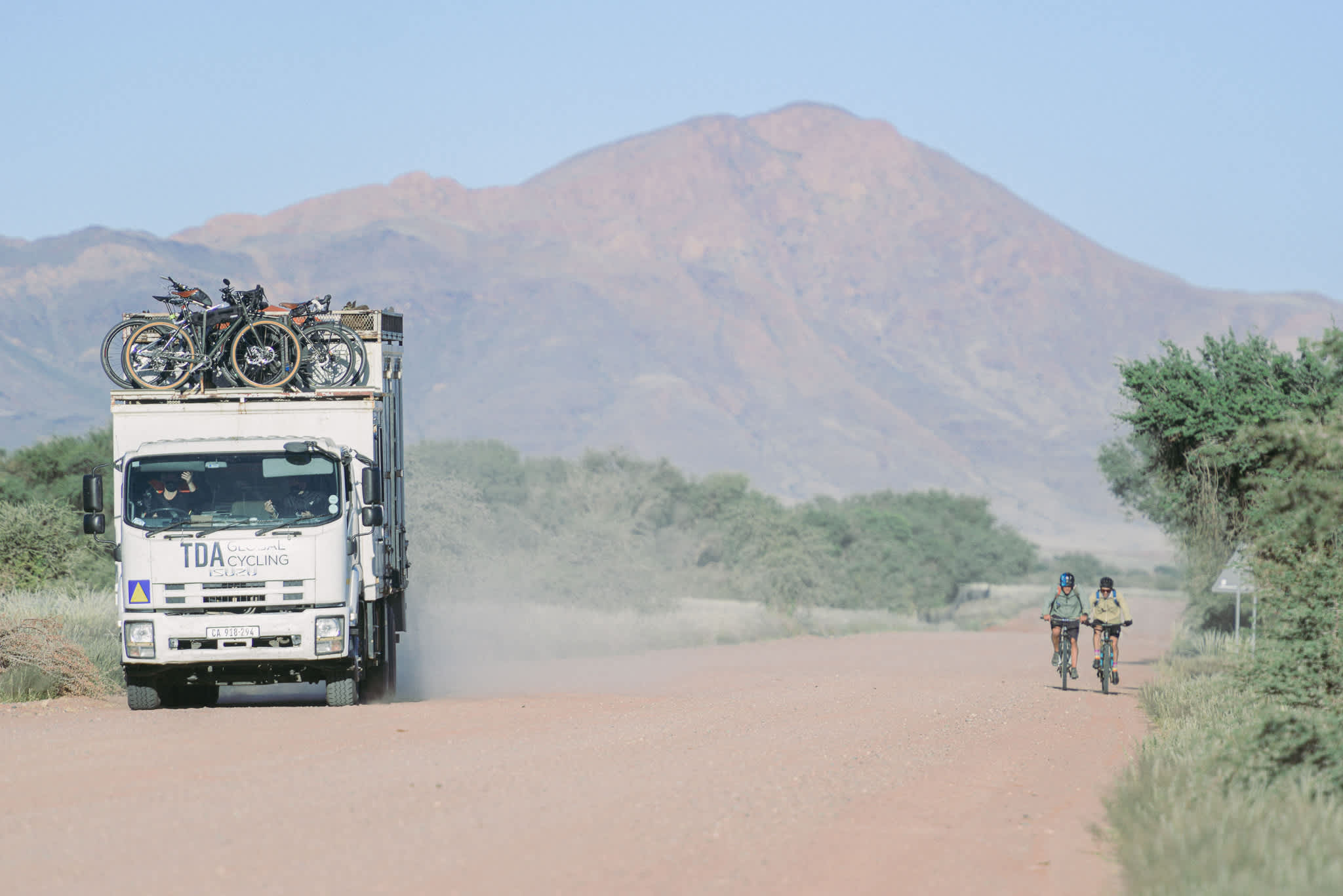
Namibia’s harsh landscape lays like a blanket draped over scores of diamond mines, and in 1908, with the discovery of diamonds underneath its craggy mountains, Germany brought its own citizens into the country to dig up all the precious stones they could find. Nearby in British South Africa, people with diamonds on their mind also made their way across the border, establishing mines and small outpost towns throughout the Namib Desert. This mix of people from Germany and British South Africa is felt today, as some villages boast their German heritage, while others are run by South Africans who either have ties back to the mining days in the 1900s, or simply wish to live faraway from a fast-paced modern life.
Indigenous Namibians who had San or Himba roots were driven away from cities and towns during colonial times, either under the threat of violence or forced labor. Today, the separation can still be felt, as small towns that range from German to South African or local Namibian. Between them, a sea of sand makes these different outposts feel as if they’re their own islands, and each day the cyclists arrive there on their bikes, unsure of what they’ll find, like ships coming to shore.
]]>
Tate Drucker is the Content Creator on the 2022 Tour d’Afrique. Her second post comes to us from the savanna of Botswana with the tour now well underway. Be sure to follow their progress on Instagram.
When traveling throughout Botswana, there’s an endless number of unique and foreign sights which pull the attention of visitors. Elephants moving in a slow-moving mass of gray throughout the Kalahari; herds of zebra trotting alongside the road with their clumsy foals; colourful hornbills calling to each other; the tangled branches of acacia trees.
However, there’s one unique entity in this sun-drenched corner of the world that cranes the necks of visitors as they stand at its base, looking up, trying to grasp the sheer size and immensity of it. This thing, while not an animal moving its way across the plains, is no less impressive. And certainly when you stand next to it, it feels no less alive.
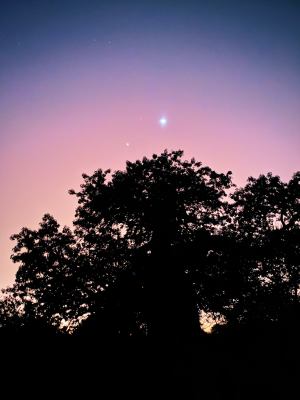 It’s hard to imagine a tree more steeped in history and honoured for its useful properties than the mighty baobab tree. Baobabs can be found in Australia and Madagascar, though they are mostly found throughout the mainland African continent. This prehistoric tree is thought by most experts to be able to live up to 5,000 years, and many of the enormous trees that pinprick the plains of Zambia and Botswana are estimated to be between 1,000 to 2,000 years old. Many first-time visitors to Africa ask how they’ll be able to identify a baobab tree before they’ve seen one, but once they do, it’s obvious that this tree stands out and is something significant.
It’s hard to imagine a tree more steeped in history and honoured for its useful properties than the mighty baobab tree. Baobabs can be found in Australia and Madagascar, though they are mostly found throughout the mainland African continent. This prehistoric tree is thought by most experts to be able to live up to 5,000 years, and many of the enormous trees that pinprick the plains of Zambia and Botswana are estimated to be between 1,000 to 2,000 years old. Many first-time visitors to Africa ask how they’ll be able to identify a baobab tree before they’ve seen one, but once they do, it’s obvious that this tree stands out and is something significant.
Although baobab trees are not the tallest trees on earth, their squat, wide width is what makes them so distinctive. The trunk of a baobab is thought to be able to grow up to 14 meters in diameter, and the trunk itself — which consists of multiple stems — creates a unique, hollowed center. Anthropologists have found that the indigenous San tribes in Namibia and Botswana often use the hollow baobabs as shelter; there are even reports of baobabs being used as jail cells and, in the 1800s and early 1900s, as post offices and pubs by colonial settlers.
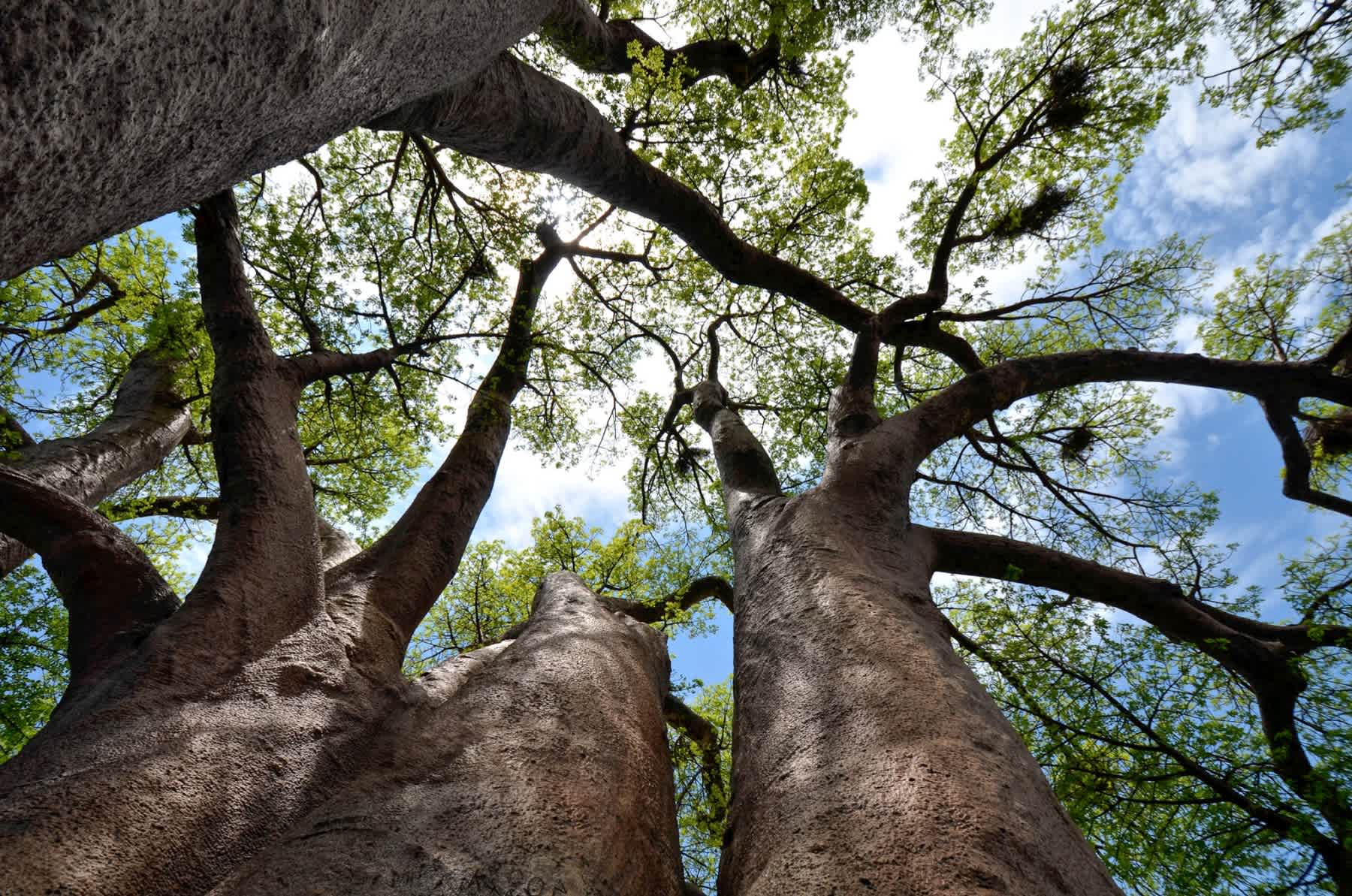 The baobab tree is Africa’s “Tree of Life,” and is known as this for a good reason. A baobab behaves essentially as a giant succulent, absorbing an impressive amount of water and holding it in its trunk (approximately 80% of a baobab is, in fact, water). To put that into perspective, a single tree can hold up to 1,189 gallons. This is why it’s not uncommon to see animals such as elephants and elands chewing on the bark of the trunk during times of draught, and the baobab has also been a source of water for people who live in rural, draught-ridden areas.
The baobab tree is Africa’s “Tree of Life,” and is known as this for a good reason. A baobab behaves essentially as a giant succulent, absorbing an impressive amount of water and holding it in its trunk (approximately 80% of a baobab is, in fact, water). To put that into perspective, a single tree can hold up to 1,189 gallons. This is why it’s not uncommon to see animals such as elephants and elands chewing on the bark of the trunk during times of draught, and the baobab has also been a source of water for people who live in rural, draught-ridden areas.
Baobabs also have one of the most nutrient-dense fruits on the planet. These mildly sweet, oblong, velvety gourds contain some of the highest concentrations of vitamin c, calcium, iron and potassium compared to other fruits around the world. For communities in remote corners of Southern Africa where access to fresh fruits may be slim, baobab seeds offer valuable nutrition that would be otherwise exceedingly difficult to obtain.
The bark of baobab trees are flame retardant, making them almost invincible to wildfires and lightning strikes; something almost unheard of in a corner of the world that isn’t a stranger to drought and electrical storms. Its soft and fibrous bark has been used to make fire-resistant clothing and rope for indigenous communities, as well as for early colonial settlers.
Every inch of the baobab tree seems to have something to offer, making it a symbol of wellness that stands stout and strong in a sea of bramble across the savanna.
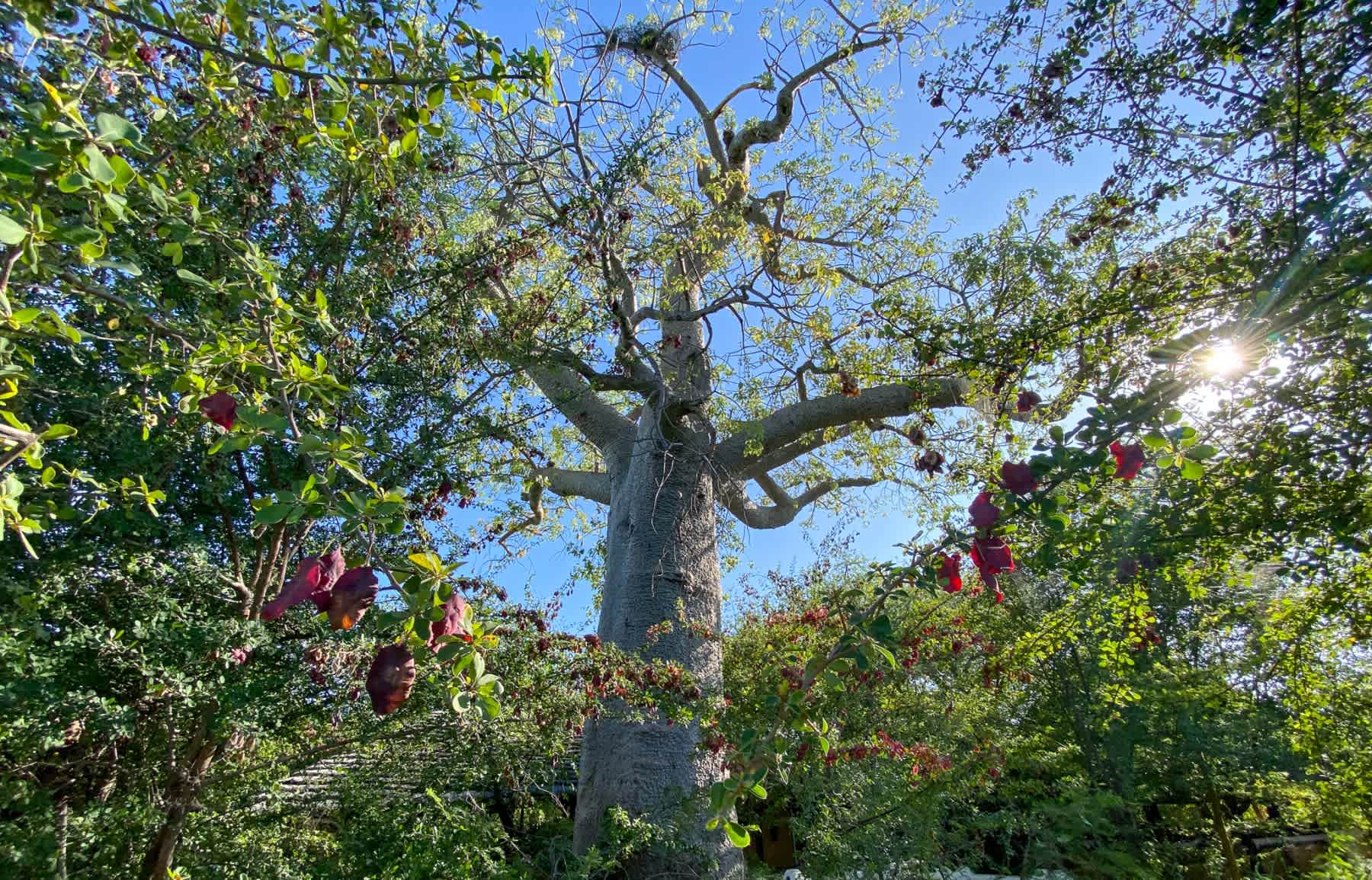
RELATED
TOUR

Tour d'Afrique
Our original trans-continental journey and flagship expedition crosses Africa from north to south, covering 10 countries in all. Beginning at the...
Tate Drucker is the Content Creator on the 2022 Tour d’Afrique. She checks in from Livingstone, Zambia at the start of the tour.
For a moment, as the plane descends over Livingstone, Zambia, it looks like the savanna is on fire. Grey clouds of smoke billow from the ground in enormous, engulfing plumes. Passengers lean with their faces pressed against the airplane’s windows, murmuring to each other, wondering about what it is they’re looking at. Then the pilot comes on the intercom and announces that it isn’t smoke from some great wildlife that they’re seeing. Instead, it’s Victoria Falls.
There couldn’t be a more iconic and awe-inspiring way to mark your arrival into Africa than catching that first glimpse of Victoria Falls from your airplane’s window. And for the cyclists arriving in Zambia taking part in this year’s Tour d’Afrique, which runs 4,655km from Livingstone to Gqeberha, this World Heritage Site sits ever-present in the background, never allowing its spectacular size and ferocity to be ignored or forgotten.

As the riders unbox their bikes, stretch their legs after their long flights spanning the globe, and learn about everything from identifying an elephant’s mood to how to create a toilet in the bush with just a shovel, the sound of the falls serves as a constant, distant white-noise. Its background presence adds to the feelings of excitement and adventure for the trip ahead, which is already palpable and buzzing amongst the group. Even heavy storm clouds and relentless rain aren’t bringing people down. Instead, many of them are shrugging at the mud, at the mist, and instead see it as a special challenge for an already enormous undertaking ahead.
Victoria Falls — which is locally known as “Shungu Namutitima” (meaning “Boiling Water”) or “Mosi-oa-Tunya” (meaning “Smoke That Thunders”) — is one of the World’s Seven Natural Wonders. While it’s not the tallest or widest waterfall in the world, Victoria Falls is considered the largest due to its sheer volume of water. On average, 500 million litres of water cascade over the falls every minute. That’s roughly the equivalent of 200 Olympic-sized swimming pools plunging over a sheer cliff every 60 seconds. And for people visiting the falls, this fact — while seemingly outlandish — is undeniable.
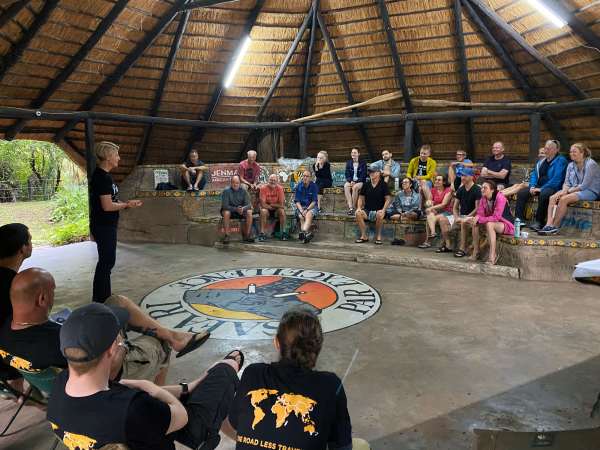
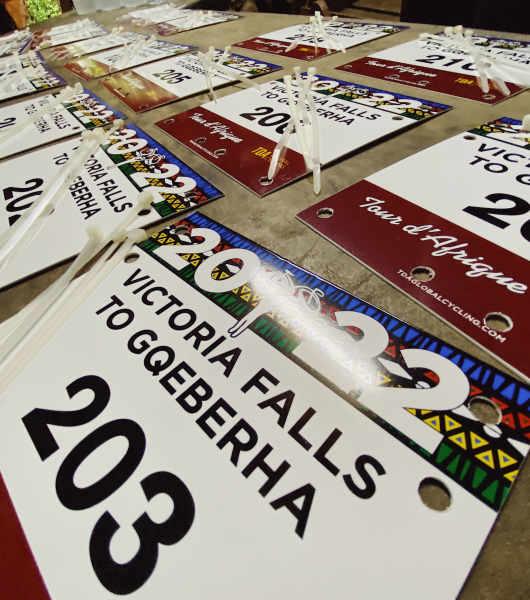
The winding path along the fall’s rim is constantly showered in what seems like heavy, constant, whipping rain. The power of the water once it falls and hits the river creates enormous, towering plumes, drenching the forest and anyone and everything that surrounds it. It seems to be the only place in the world where everything feels flipped upside down; where it rains from the ground up.
From where the Tour d’Afrique begins, the proximity to the falls allows for riders to embellish their days with microlight flights, white water rafting, hiking along the fall’s rim, or bungee jumping. Even sitting on the lodge’s verandah, frosty Mosi lager in hand, watching the swollen, heavy red sun sink below the misty horizon is an experience unmatched anywhere else in the world. Some spend their mornings fine tuning their gears and brakes, followed by a helicopter flight. Some spend their mornings comparing electrolyte powders and protein bars, followed by a sunset river cruise past lolling hippos and the billowing mist. And the fact that soon they’ll pedal away from Livingstone, with seven weeks and four countries ahead of them, is as ever-present and adrenaline-pumping as the raging falls that sit as the backdrop to this all.
RELATED
TOUR

Tour d'Afrique
Our original trans-continental journey and flagship expedition crosses Africa from north to south, covering 10 countries in all. Beginning at the...
As you can imagine, we get a lot of questions from riders before they set out on the Tour d’Afrique. I mean a lot! One question that, suspiciously, is not answered in our FAQs is, “What about Showers? How will I stay clean?” Well, that is a really good question…
 Our Rider Bulletin warns that, “During the TDA we will go through stretches where water becomes our most precious resource. Typically these areas are in Botswana and Namibia. However it can happen at any time of extreme heat. There should never be a shortage of drinking water. However, where water resources are limited, rations on using water for cleaning oneself (in bush camps) will take effect. At times this can mean that everyone is allowed 1 water bottle full to rinse themselves off. Other times we will need to keep all of our water for drinking and cooking, and so no water will be allocated for washing.”
Our Rider Bulletin warns that, “During the TDA we will go through stretches where water becomes our most precious resource. Typically these areas are in Botswana and Namibia. However it can happen at any time of extreme heat. There should never be a shortage of drinking water. However, where water resources are limited, rations on using water for cleaning oneself (in bush camps) will take effect. At times this can mean that everyone is allowed 1 water bottle full to rinse themselves off. Other times we will need to keep all of our water for drinking and cooking, and so no water will be allocated for washing.”
To prepare, 2013 cyclist Philip Howard suggested, “It is very difficult to properly prepare for the levels of dirt that you and your clothes will be exposed to. I would advise that for 8 days straight, you should not shower, you should exercise for many hours every day and wear the same clothes. You may lose some friends and get some funny looks especially in work and on public transport but at least you will be prepared mentally for the task ahead. You will be allowed use a limited supply of baby wipes in this period though.”
One 2019 cyclist pointed out, ‘Dirty’ and ‘clean’ take on a new meaning here. If it’s not visibly covered in dirt or grease from your chain you’ll likely wear it again.”

In 2008 one rider wrote about the Cyclical Levels of Cleanliness in the Sudan:
Day 1: Shower. Wear 1 set of clean clothes for day, fresh t-shirt to bed. Brush teeth twice. Copious use of hand sanitizer.
Day 2: Return to day clothes, same night t-shirt. Brush hair. Use baby wipes to shower. Good use of hand sanitizer & toilet paper. Brush teeth morning & night.
Day 3: Day clothes back on, but after dinner is spent cleaning & repairing bike, too tired to change into night T. Brush hair out of ponytail. Brush teeth twice. Remembered to wash hands for lunch only.
Day 4: Still in same clothes for riding & sleeping (minus spandex). Continue to brush teeth twice. Hair in same style as previous day, too dirty to move, plastered to head w/ helmet, anyway. Brushed teeth. Scrubbed w/ clean desert sand to get grease off fingers after dinner.
Day 5: Plan to wash sleeping bag liner on rest day, b/c still sleeping in same clothes. No need to put clean clothes on dirty, sweaty, unwashed body. Grime accumulating under nails. Forgot about the baby wipes. At least able to brush teeth & rinse toothbrush. Hair hasn’t moved in 3 days.
Day 6: As soon as we make it to Dongola, we’ve got water & a rest day so no need for day’s ablutions I’ll take care of things then.
Day 7: Shower at last – a partially-clothed rinse with a public hose, scrunched in a bath in a red box. Due to degradation and desperation levels, we’re quite happy to be this clean!
Of course, there are other ways of dealing with this issue…
Donkey shower

“On the last night in Sudan, we were offered the opportunity of a bucket shower. This consisted of entering a galvanized sheet iron hut with a mud floor and no lights. I entered just at sundown so tried to do my best in the light of dusk. Then I was given a tub with about 15 litres of cold, muddy water into which I stepped. I was able to wash my hair by using a water bottle from my bike to pour the muddy water over my head. I ended by grabbing the wash basin like bucket filled with muddy water and pouring it over my head. Only then did I notice the nearby generator with exposed live wires. Most interesting shower I have ever had. Total cost? About 50 cents for one bucket. I needed a second bucket just to get the mud out of my hair and off my feet.” – Don Holshuh, TDA 2018
Pros: Personal service
Cons: Currently only available in Sudan & Ethiopia
A Swim in the River
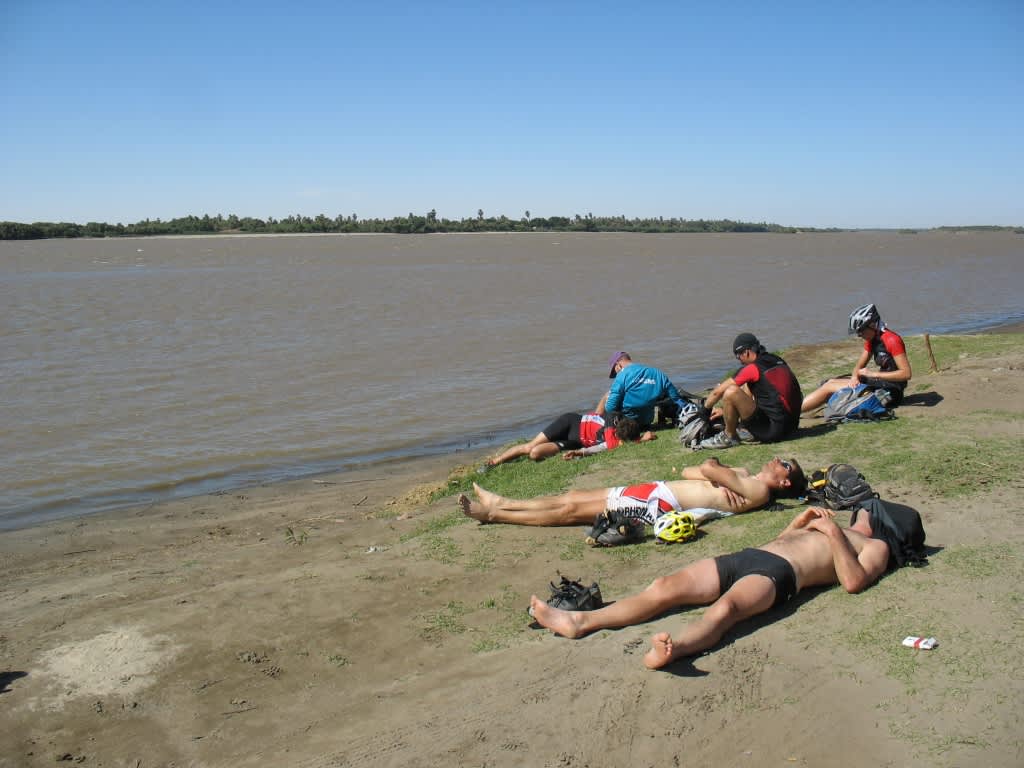
Drying off along the Nile
Pros: Easy access
Cons: Crocs. The Nile and the Zambezi Rivers feature crocs but the Chobe River adds in some cranky hippos, just for fun.

A Swim in the Lake
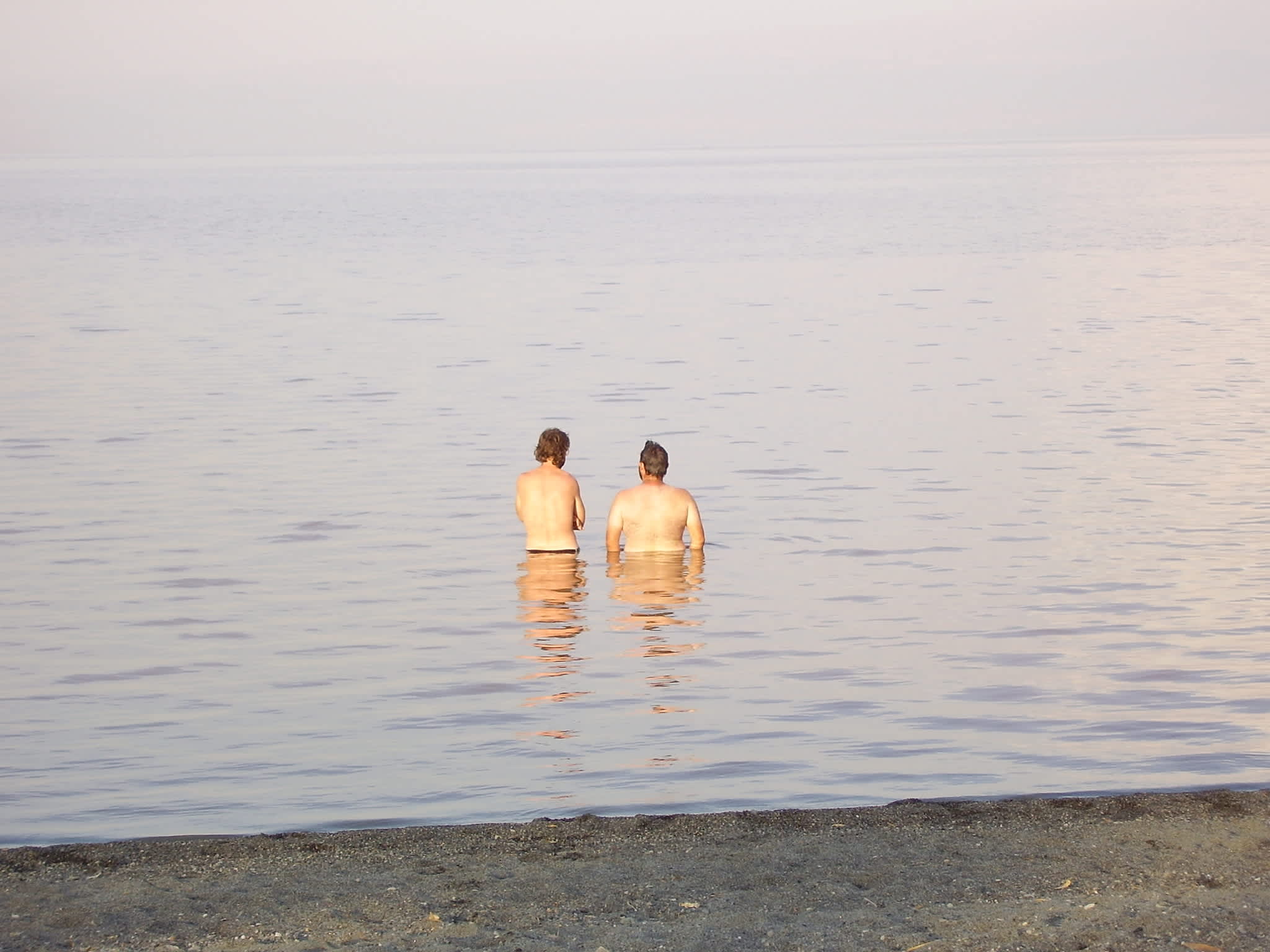
Enjoying the view
Pros: Beautiful beaches/Great views over Lake Malawi
Cons: Urogenital schistosomiasis (Yes, as gross as it sounds)
A Swim in the Ocean
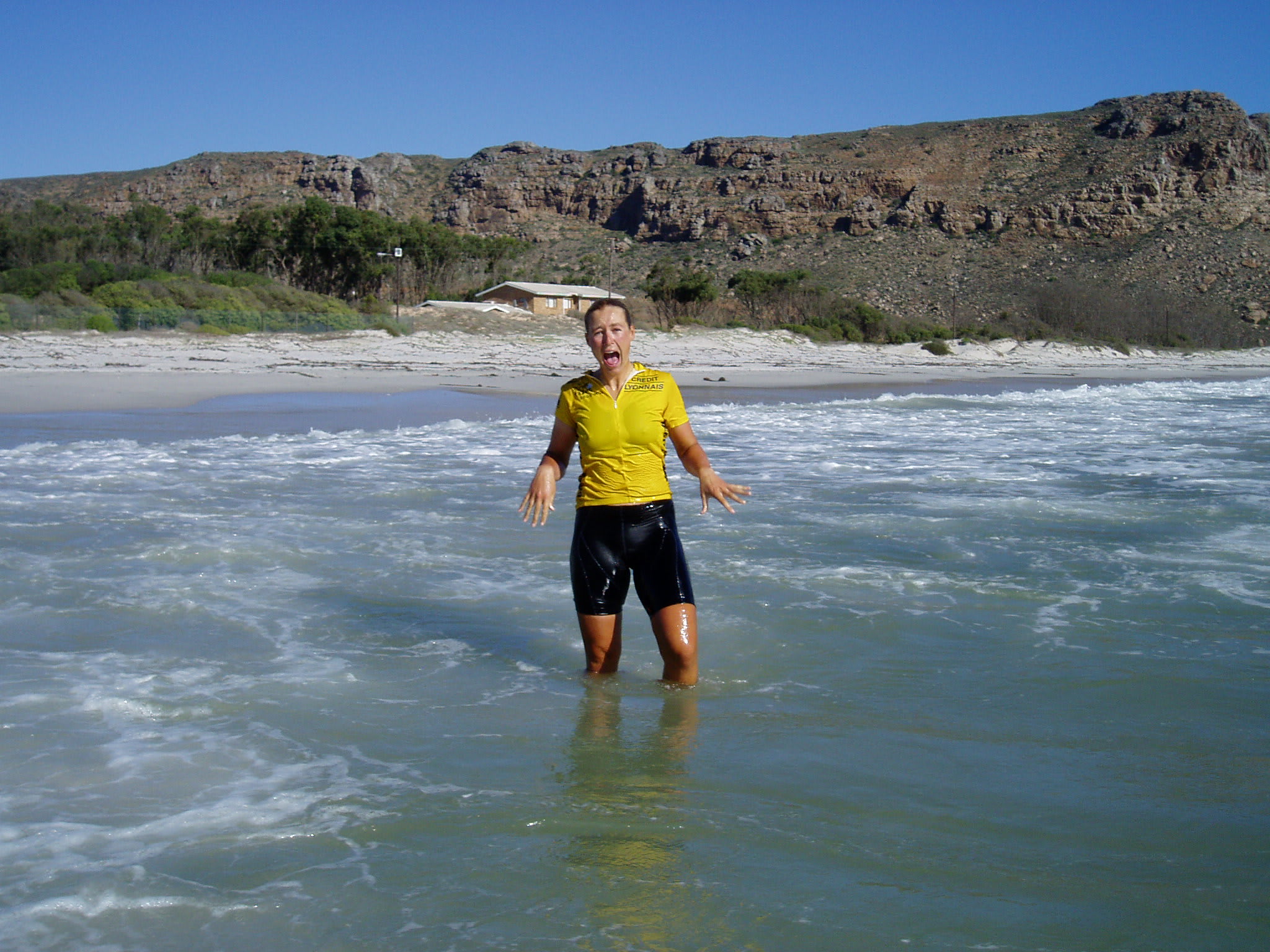
A dip in the Atlantic in South Africa
Pros: No Crocs or Urogenital schistosomiasis
Cons: Freezing cold/Only available the week before the finish
Bottle showers & Baby wipes
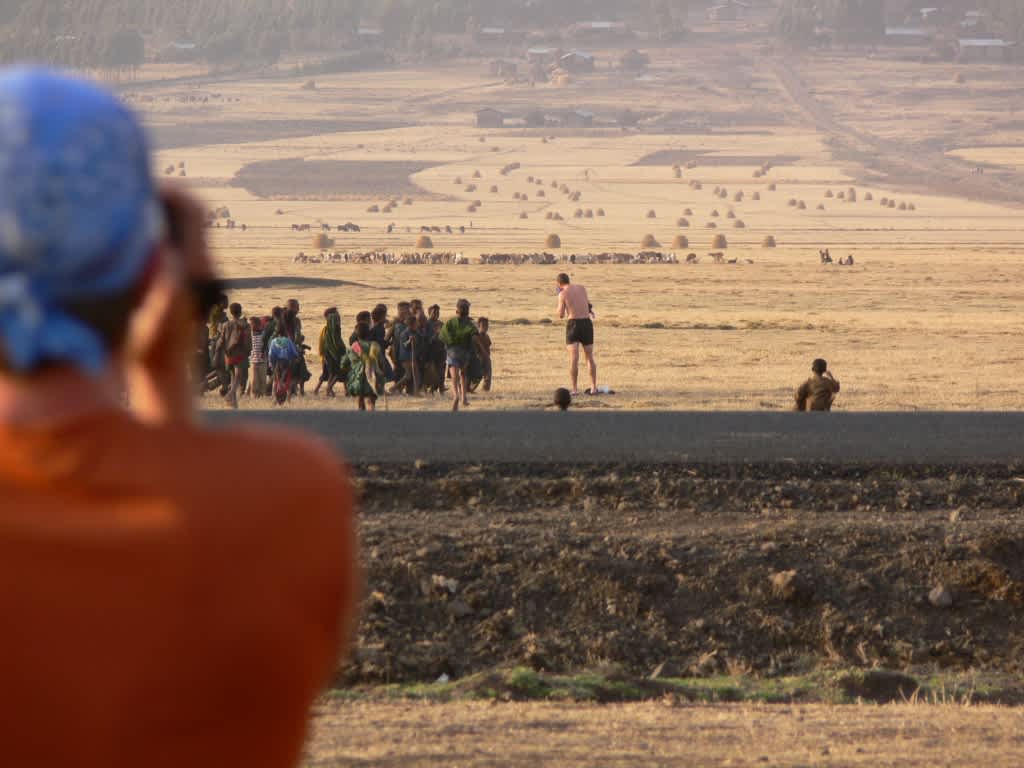
Curious kids in Ethiopia
Pros: Controlled cleaning
Cons: No privacy, especially in Ethiopia
“One particularly hilarious incident that made this clear occurred in Ethiopia when Kevin, one of the riders, went off into a field to have a water bottle shower. Within a few minutes, all you could see was a pale white speck being converged on by scores of tiny kinetic black dots, as the excitement was almost too much for the children to handle. Kevin stood painfully unaware as everyone at camp laughed and watched the spectacle unfold until he finally noticed the avalanching army of children and struggled to quickly put back on his clothes in time.” – Danny Gold (2006)
Idfu Stadium Hose
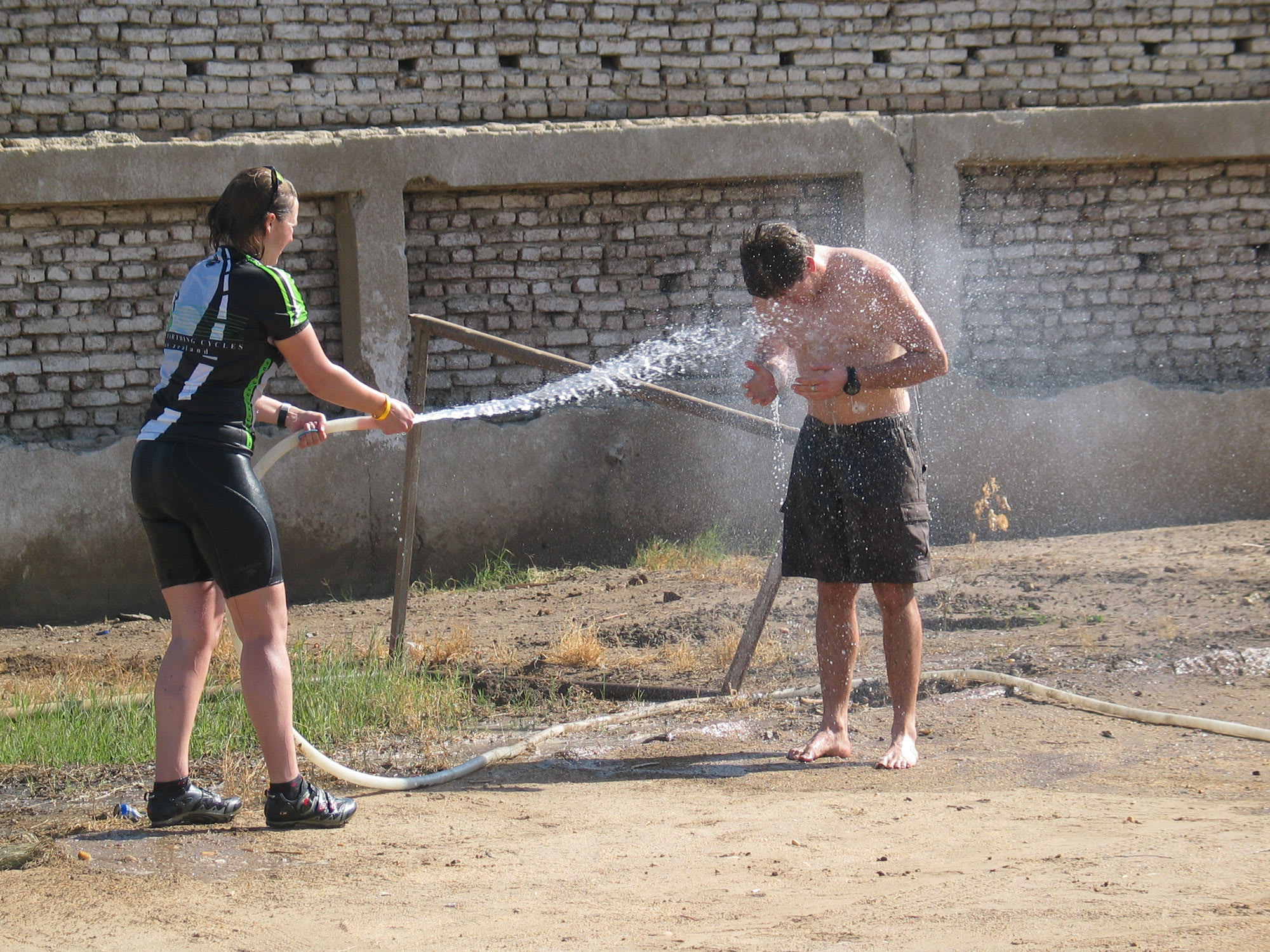
Pros: Wonderful water pressure
Cons: Discontinued due to multiple mosque wake-up calls at 04:00
Waterfalls
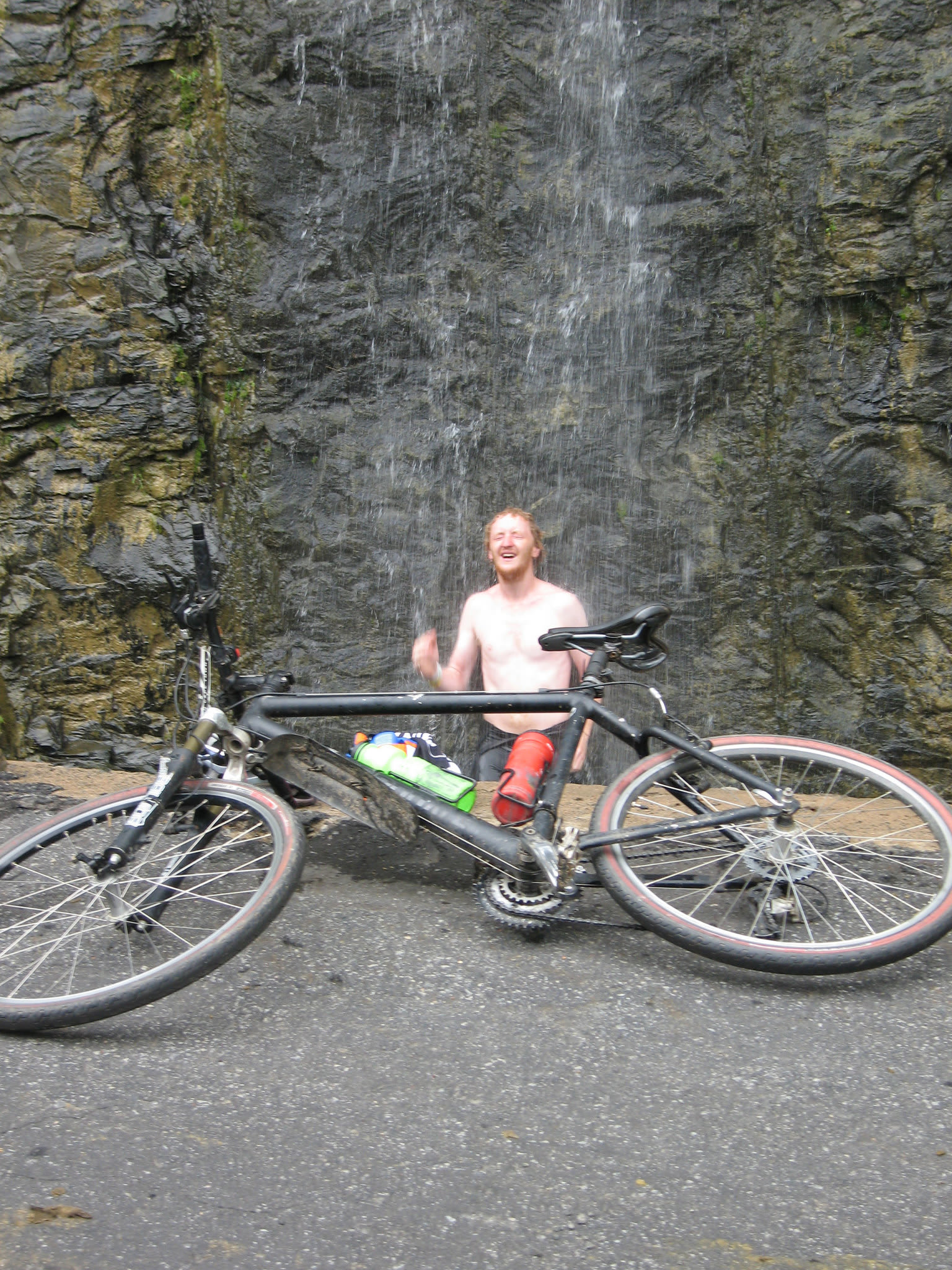
Washing off in Malawi
Pros: Clean water
Cons: Limited supply
Red Boxes
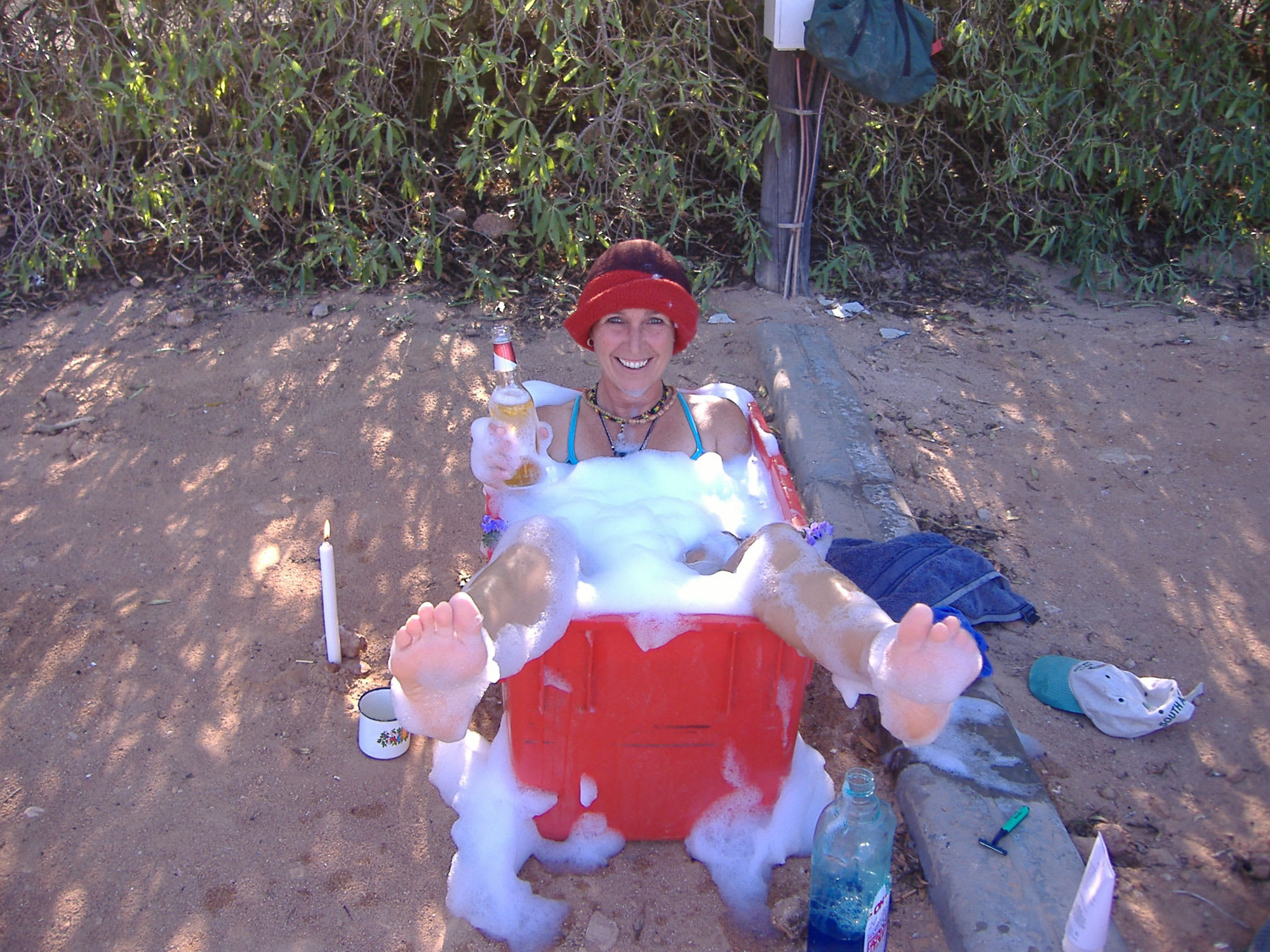
Pros: Soaker tub
Cons: Discontinued in 2009
Swimming Pools
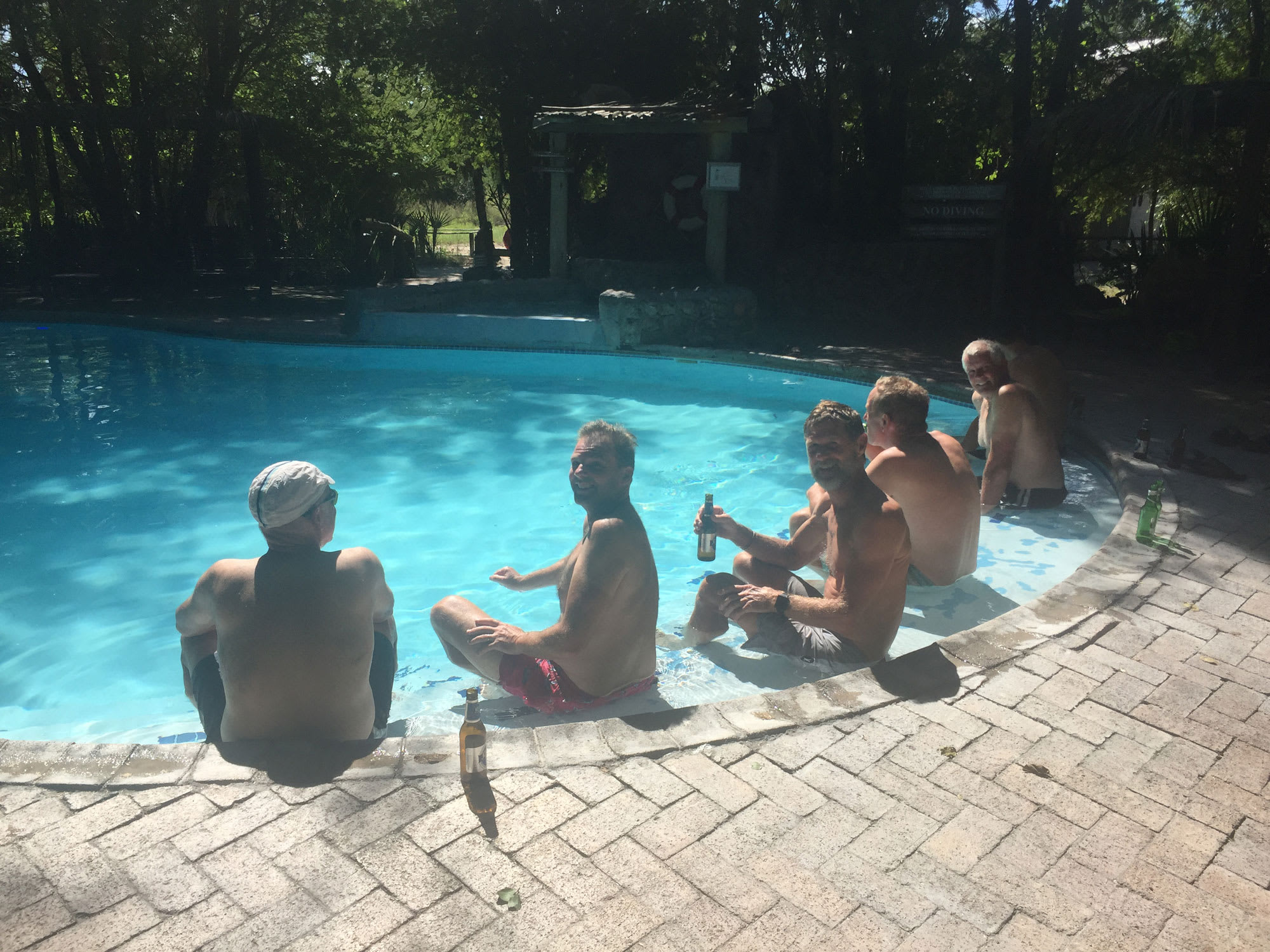
Pros: Chlorine
Cons: Pee pee/Limited availability
During my ride across Africa in 2006, I very much appreciated even a single bottle of water at the end of the day so I could wash off the accumulated sweat and grime that is inevitable after cycling 120 kms on dusty roads in the hot sun. It is amazing what you can do with just 12 oz of liquid when you have no other options. I also remember that baby wipes were considered more valuable than gold. I swam in the Nile River (no crocs!) and floated lazily in the warm waters of Lake Malawi (no Urogenital schistosomiasis). I got hosed in Idfu and dipped my toes in the frigid Atlantic Ocean. I leapt off my bike on the climb up out of Chitimba Beach and stood under an amazing waterfall. I enjoyed the swimming pools in Sagana, Kenya and Luangwa River Camp in Zambia but it was the unexpected pool that we discovered at Planet Baobab in the middle of nowhere in Botswana that will always be one of my fondest memories. You turn left down a dirt lane at the giant pink aardvark and follow the signs for just over a kilometre where you will be amazed to find, set amongst 4,000 year old baobab trees, a funky bar and refreshing swimming pool!
]]>
“There are strange things done under the Namibian sun
By cyclists who ride the continent for glory;
The African trails have their secret tales
Most would sound like a crazy story;
The Southern Lights have seen queer sights,
But the queerest they ever did see
Was that day on the road outside Solitaire
I got naked, just my friends and me.“
– (Sincere apologies to Robert Service)
The Tour d’Afrique’s tradition of the ‘Naked Mile’ was perhaps inspired by the World Naked Bike Ride which was started in 2003 to draw attention to “oil dependency and celebrating the power and individuality of the human body.” (Wikipedia). It took a few years to manifest itself on the tour. Cycling across the African continent was certainly an obvious method of drawing attention to oil dependency, not to mention the power of the human body.
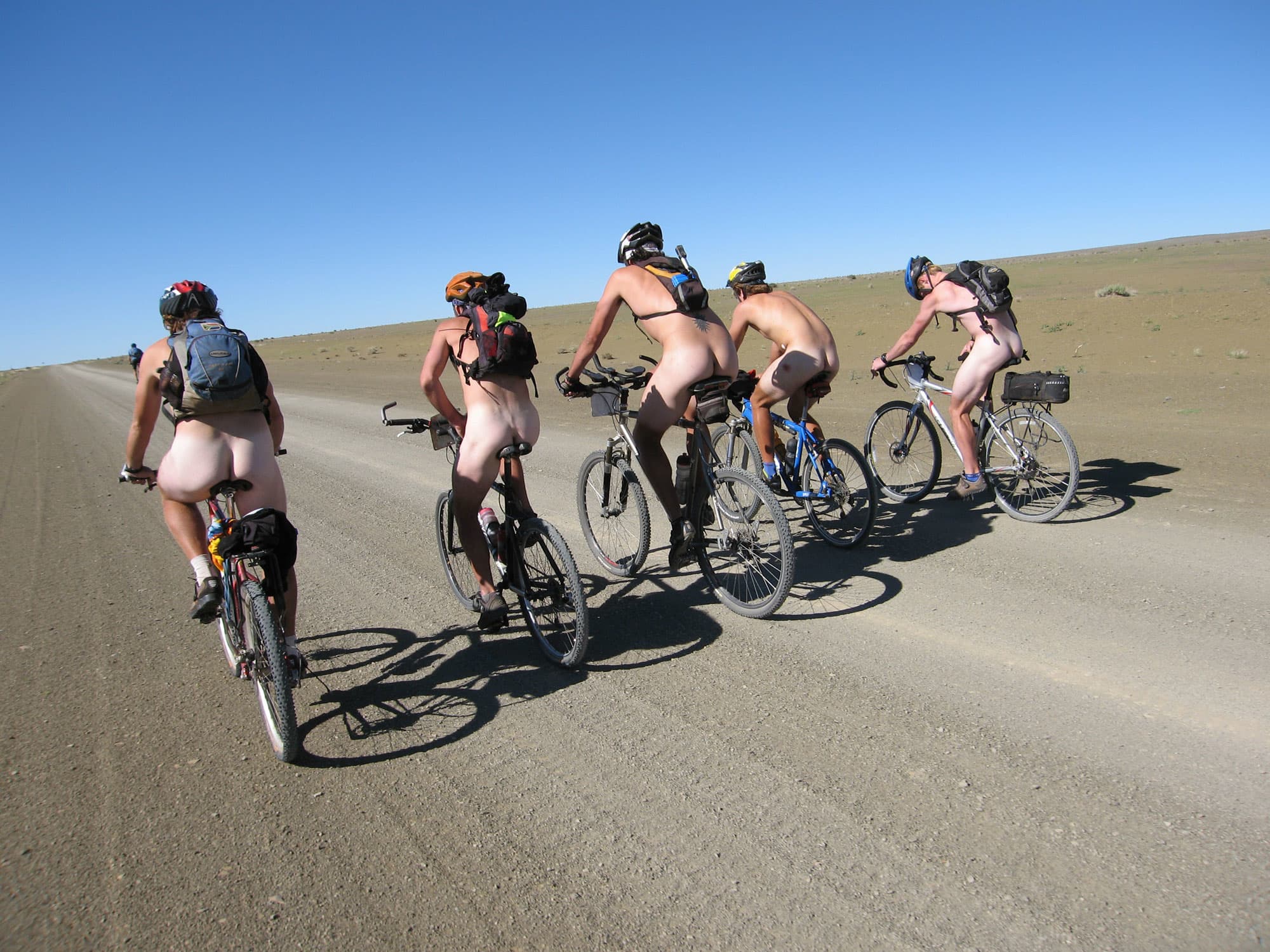
The first Naked Mile in 2006
The tradition was started on the 2006 expedition. Before that, as 2005 rider David Houghton commented, “We limited our nakedness to skinny dipping and sprints to the shower.” Who started it is a mystery! Why Namibia? Likely because it has so much open space that a few naked cyclists might easily go unnoticed. I remember being part of the first one and pedalling happily along before noticing a tour bus approaching. What to do? Well, we just kept spinning along and thoroughly enjoyed the looks of shock, surprise and yes, even horror, as the golden-aged tourists suddenly realized what was going on outside their windows. They came to see Namibia’s famous dunes and instead were treated to our cycle-hardened moons!
In 2009, one rider wrote, “Today things got weird. Rumours have been floating around for a while that some years ago one of the tour groups decided to strip down and ride their bikes naked for a mile. For any normal group of people this idea would seem to be ludicrous… but we are a band of individuals who have decided riding bikes from Cairo to Cape Town sounds like a grand vacation. Therefore, upon hearing that such an ad hoc celebration of the flesh had occurred on years prior an adventurous group of our cyclists (myself included) decided to take it upon themselves to “gear down and go for it”.”
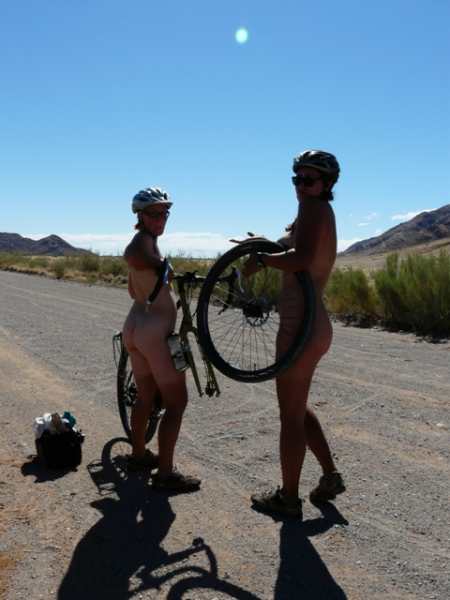
In 2010, one staff member, who shall remain anonymous, wrote, “Off the top of my head, I can think of a few places I’d enjoy being naked: the shower, the bedroom, a sauna, a lake. But naked while riding a bicycle over a gravel road in the full sun of the Namibian desert doesn’t immediately spring to mind. Immediately, that is. Namibia offered epic views and I was enjoying my ride at the back of the group as the sweep, alone with my thoughts and endless kilometres of sand and sky. Suddenly something caught my attention; off in the distance I could make out two figures coming toward me. By now I can usually identify riders by pedal stroke and jersey long before facial features become distinguishable. But this time, something was amiss. It looked as though the pair was wearing pale, flesh-toned body suits. As they pedalled closer I could see they were wearing little more than serious cycling tan lines, helmets, and mischievous smiles. I had heard rumblings of a resurrection of the Naked Mile, the brainchild of some fun-loving riders of TdA’s past, and it donned on me (around the time I got my first glimpse of nipple), that The Naked Mile was on!” An added bonus was that, “Moments after pulling off our jerseys, Henry Gold rumbled toward us in The Green Machine, one of our beastly support vehicles. Caught red-handed (and nearly braless), we seized our opportunity and promptly mooned Tour d’Afrique’s founder.”

The start of the 2012 Naked Mile and Lisa Casey’s record breaking ride
Over the years the competition to ride the Naked Mile the furthest intensified. Sure, setting the record for the fastest ascent of the Blue Nile Gorge is something to talk about but in 2012, one female Canadian cyclist managed to ride the full 84 km stage butt naked. Now that is a record to be proud of!
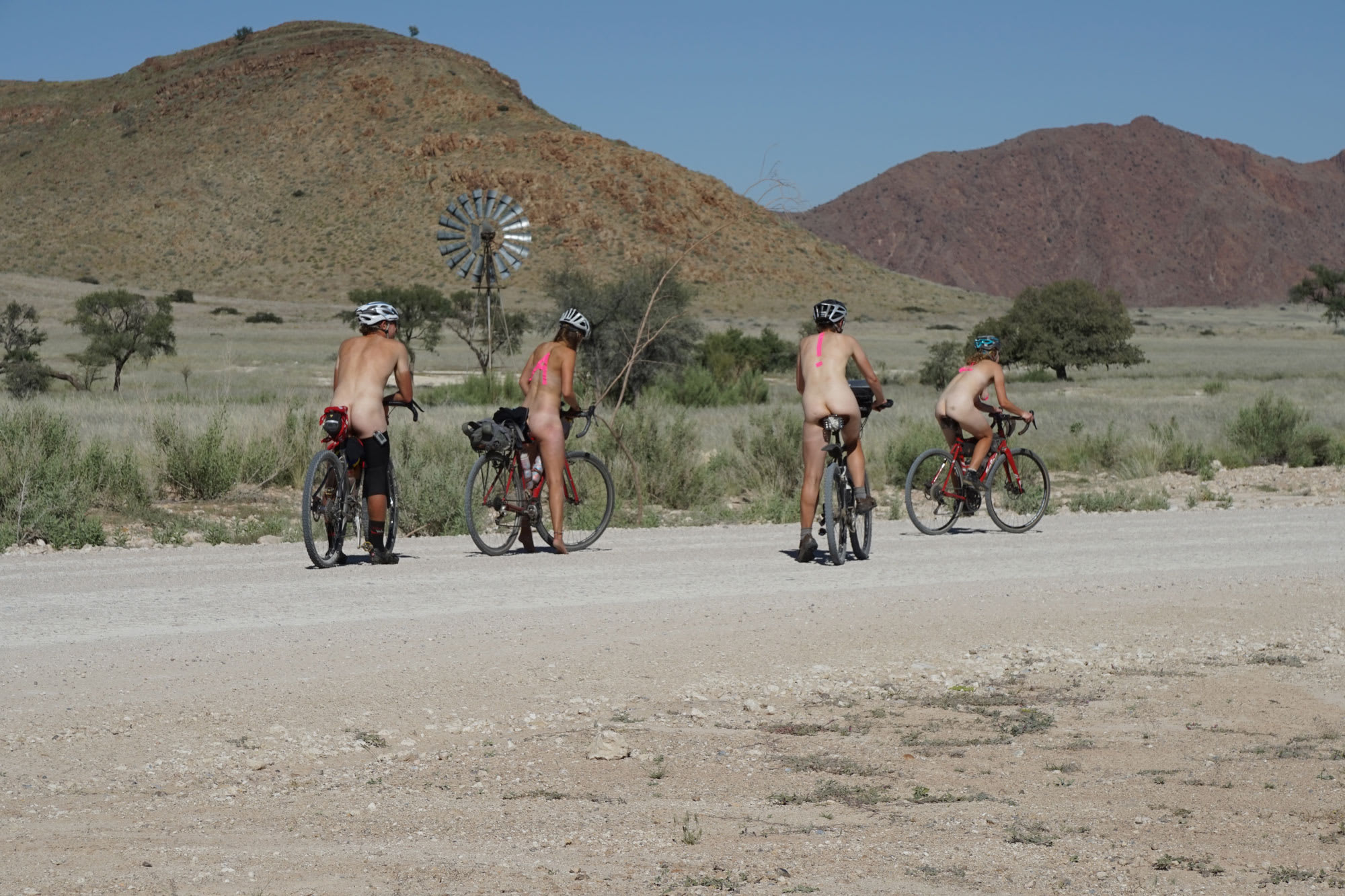
2014 riders getting their tape on…
In 2014 a group of riders spelled out TDA 2014 on their backs in pink tape and rode their mile right past lunch causing quite a spectacle.
A 2017 South African cyclist remembers that his wife, “cycled with the girls, who in true TDA tradition, stripped off their kit & rode the “Naked Mile” before lunch. Two of the Racing Snakes, Charles and Mark rode the complete 30 km Time Trial naked, much to the delight of the numerous Tourists in the immediate area.”
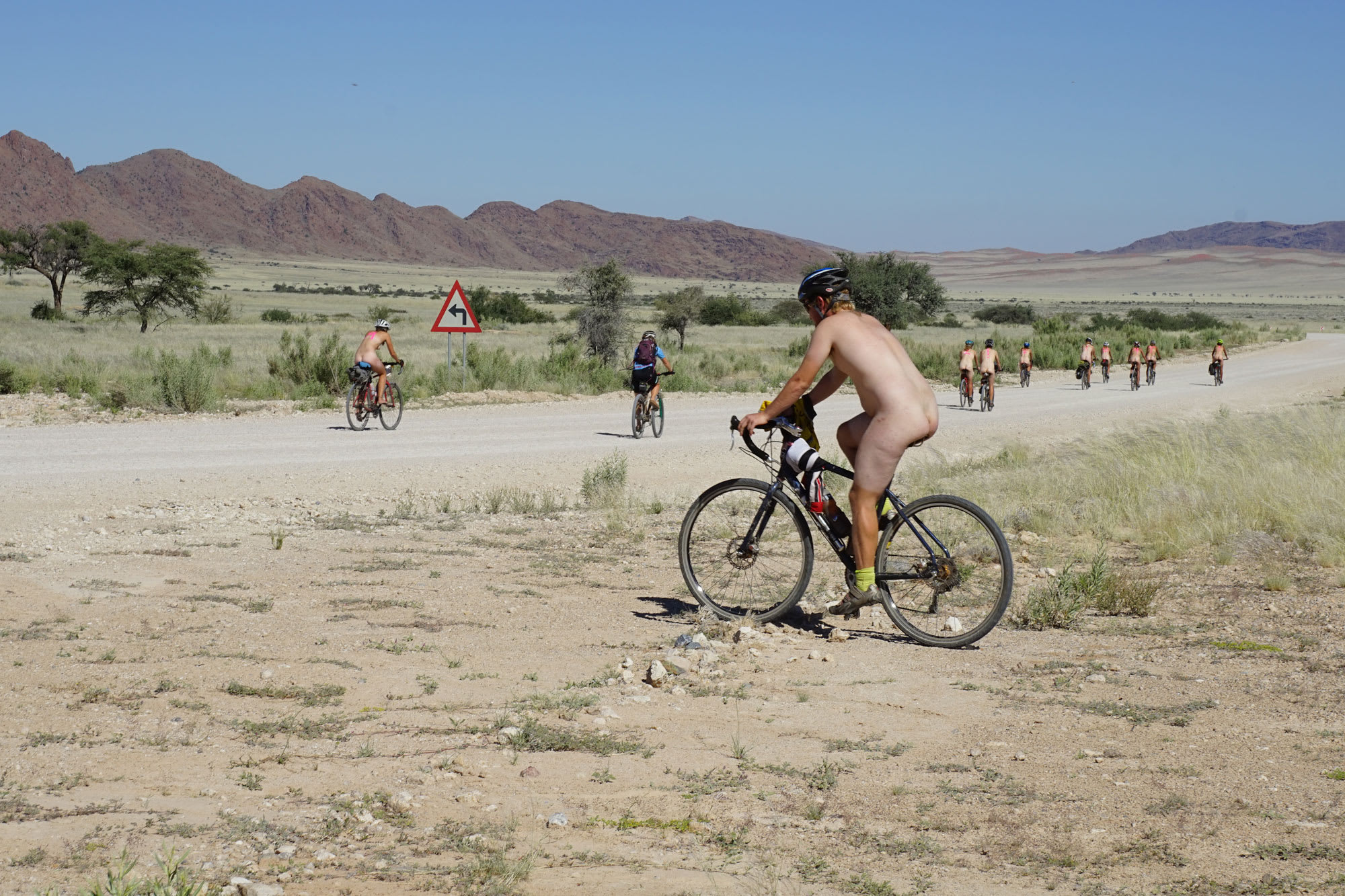
In 2018, a British rider wrote, “It wasn’t as awkward as I had anticipated. And was actually pretty comfortable. We were at the top of the hill by this point so we had a nice cruise down, albeit corrugated again, to the plateau. We attracted a fair about of attention from the handful of vehicles. Maybe 25-30% of them stopped/slowed to get a better look. A tour bus even stopped in the middle of the road and the driver whipped out his phone to take pictures. There was also a couple standing in front of their land cruiser with big cameras taking pictures and talking to us.”
Of course, in 2020 and 2021, the pandemic added the Naked Mile to its many victims but the 2022 Tour d’Afrique will pass through the Namibian desert. Will the tradition continue? Well, there is a isolated stretch of a gravel road, deep in the Namibian wilderness, where each year since 2006 a sacred rite is undertaken. Where cyclists strip down, shedding their clothes and inhibitions. Where they pedal effortlessly for a 1 mile and maybe many more, blowing shamelessly past amused ibex and the occasional horrified tour bus. So why not! Why not, indeed?
]]>
The ride from Wadi Halfa to Khartoum is quite stunning. The vast landscape opens up in all directions – endless desert interrupted every now and then by the Nile River, its waters bordered by swaying palm trees and dotted with friendly villages. This area is Nubia, once known as the legendary Kingdom of Kush, and is home to the Nubian people. They have a distinctive culture, language and architecture. Cyclists pedalling into a small town after riding through the monochrome desert will be delighted by the colourful homes made of mud brick that line the streets, especially by their elaborately decorated doorways.
“Even more distinctive than the floor plan of a Nubian house is the decoration of its exterior doorway, or bawaba, which mixes vivid colour, adobe brick filigree, figurative and geometric images in mud and white lime-plaster relief, and wall-mounted objects like ceramic plates, automobile headlights, mirrors, cow horns and dried crocodiles. While the full range of these decorative materials has shrunk in recent years, the impulse to draw attention to one’s home, and to its doorway as a symbol of the family, remains strong.” – The Decorated Houses of Nubia

Prior to the 1920’s the entranceways were decorated with geometric patterns and objects like clay plates. Some believe that these designs were created to ward off the evil eye or to reflect the nature of the journey to Mecca for the Haj or reflected ancient Nubian traditions. For example, in The Decorated Houses of Nubia, the authors write, “Abdallah Salih Suleiman, age 75, lives in such a house near Kerma. He was born on Badeen Island in mid-channel and remembers his old home’s outer wall adorned with a white lime-plaster image of a lion holding a sword, surrounded by sunbursts. “Whenever a child in the family lost a tooth, he would throw it at the wall, and where it struck, in that place we would then paint a sunburst as a wish for a new tooth. Our doorway also had a plaster cattle egret, which we call here sadeeq al-mazreeq, or friend of the fields, because it is always a welcome guest.” Egrets eat insect pests and make the farmer’s job that much easier.”

The doors face south to avoid the winter’s cold north wind or face the Nile to benefit from the cool summer breezes. Up until the early 20th century, only yellow and red pigments were available and the doors were made of wood. Outside influences were starting to be felt however. One article points out that, “Huntley & Palmers brand tea-biscuit tins, imported into Sudan from the famous Reading firm from the 1880’s onward, were decorated with images of flowers and Art Deco geometrics; those later ended up as standard design motifs on the walls of houses. The tins were ubiquitous throughout the country by the turn of the 20th century.” By the 1920’s artificial colours allowed for a much wider palette of colours and the wooden doors were slowly replaced by more durable metal ones.
The Tour d’Afrique provides its riders with any number of memorable moments but pulling into a small Nubian village with its simple, welcoming and colourful architecture after a long, hot day in the saddle is certainly one that will be remembered for a very long time. Now, if you could just get a cold beer…
]]>


